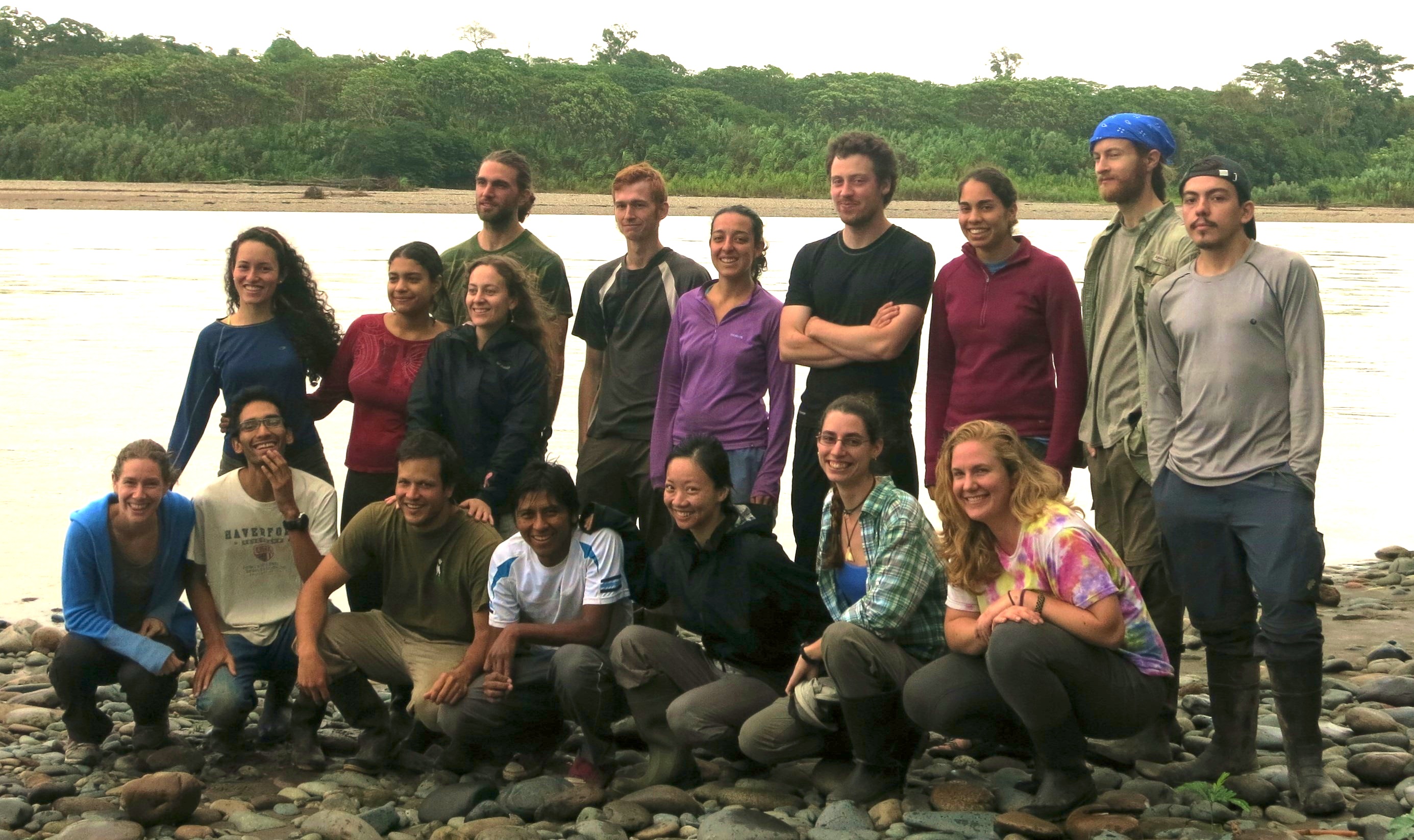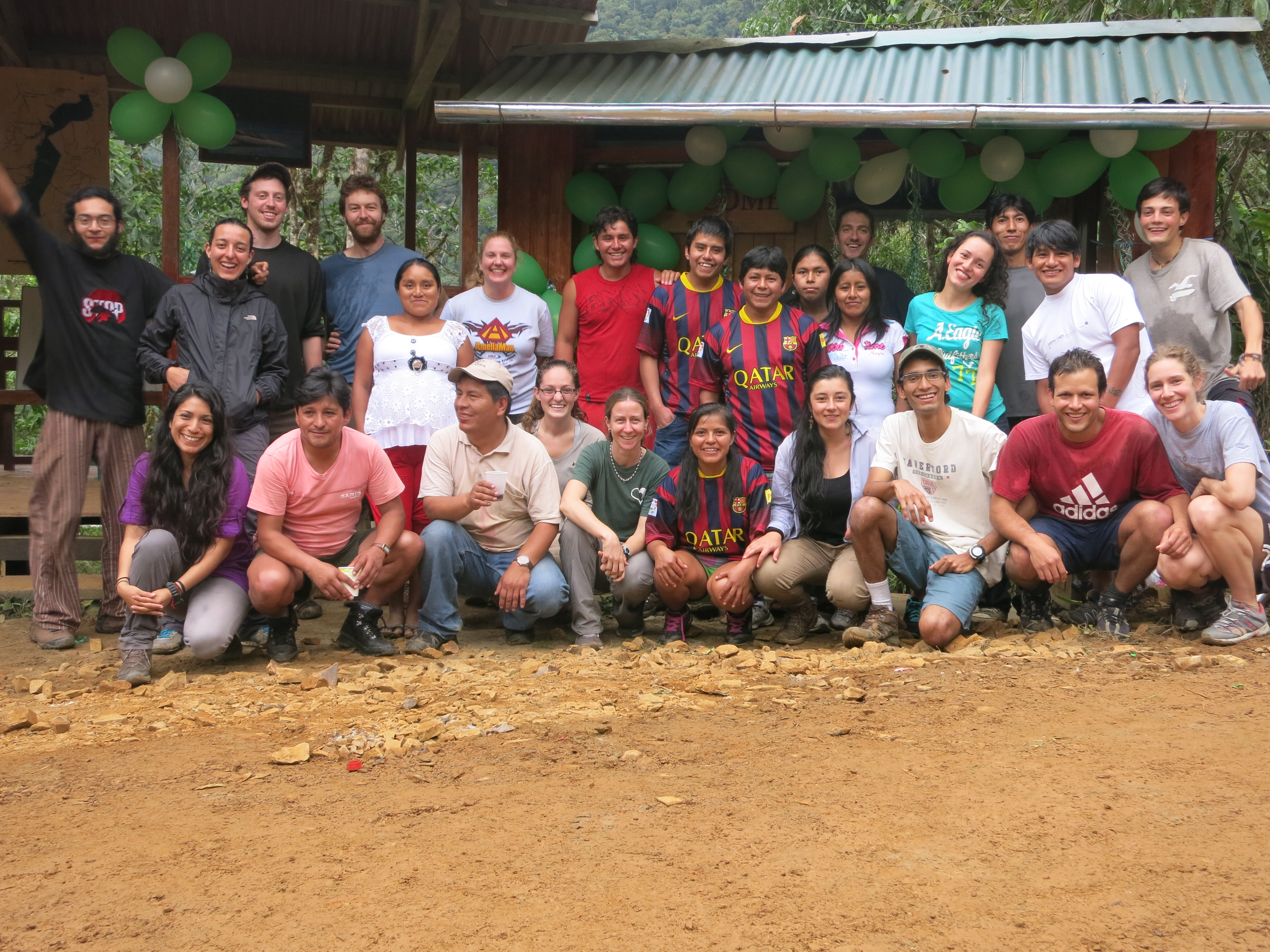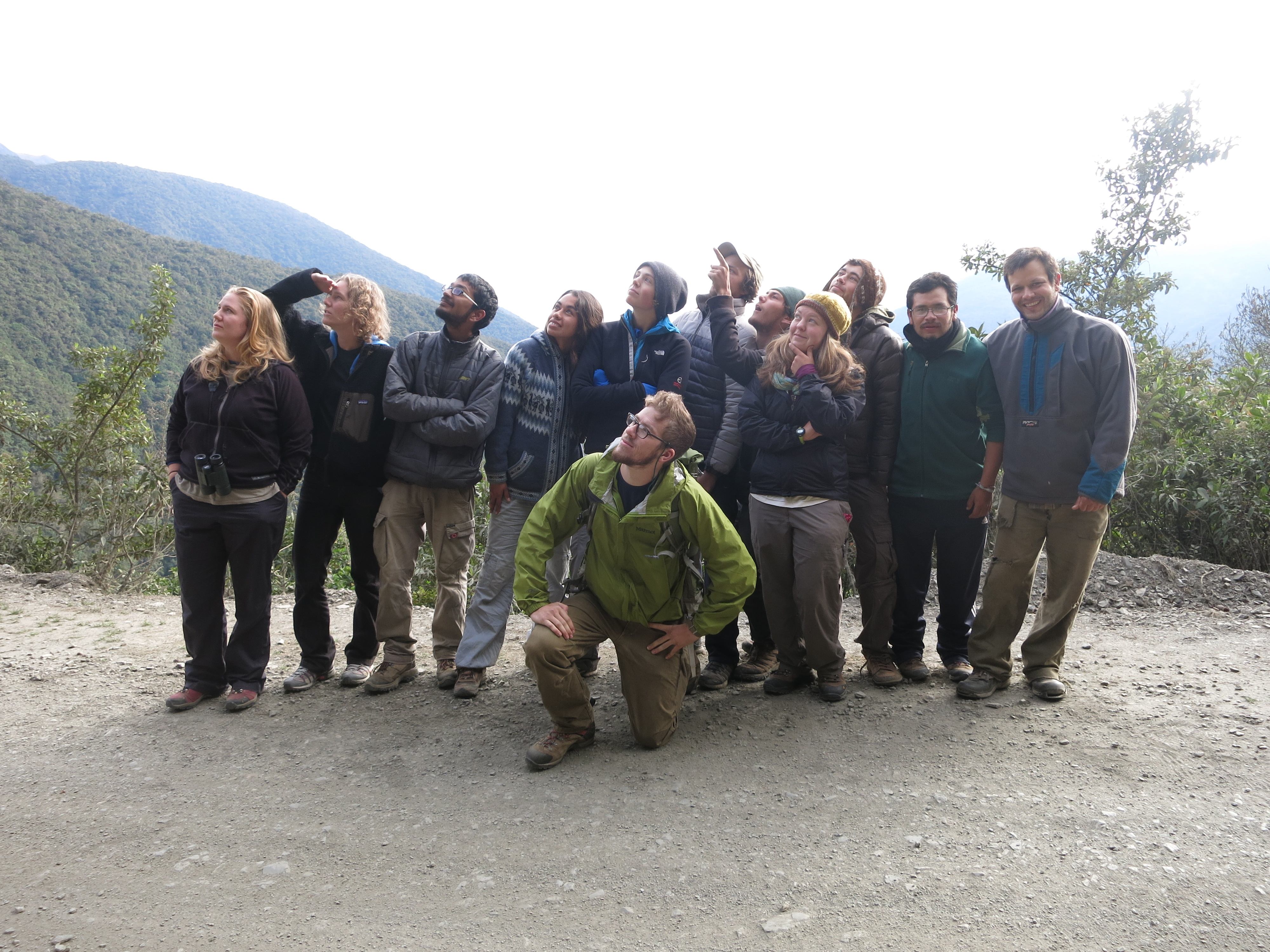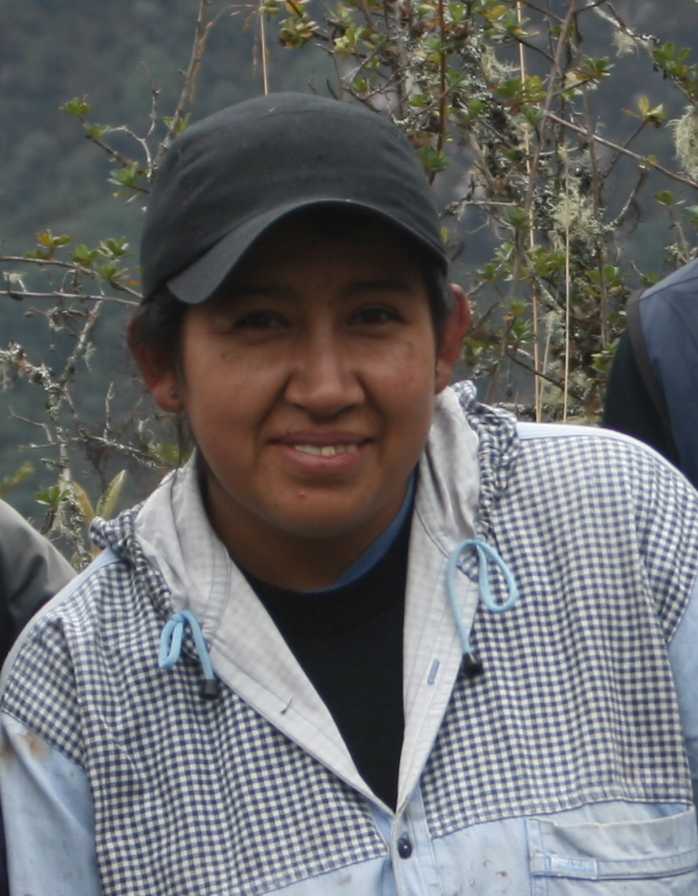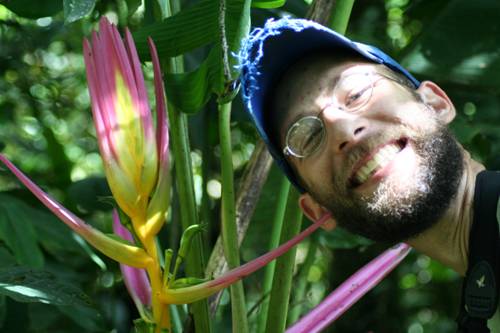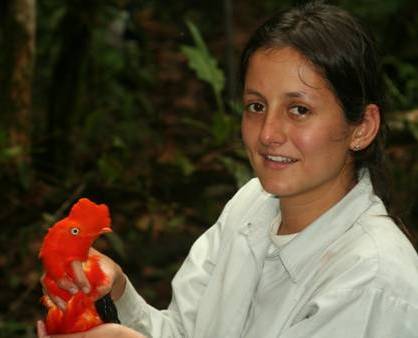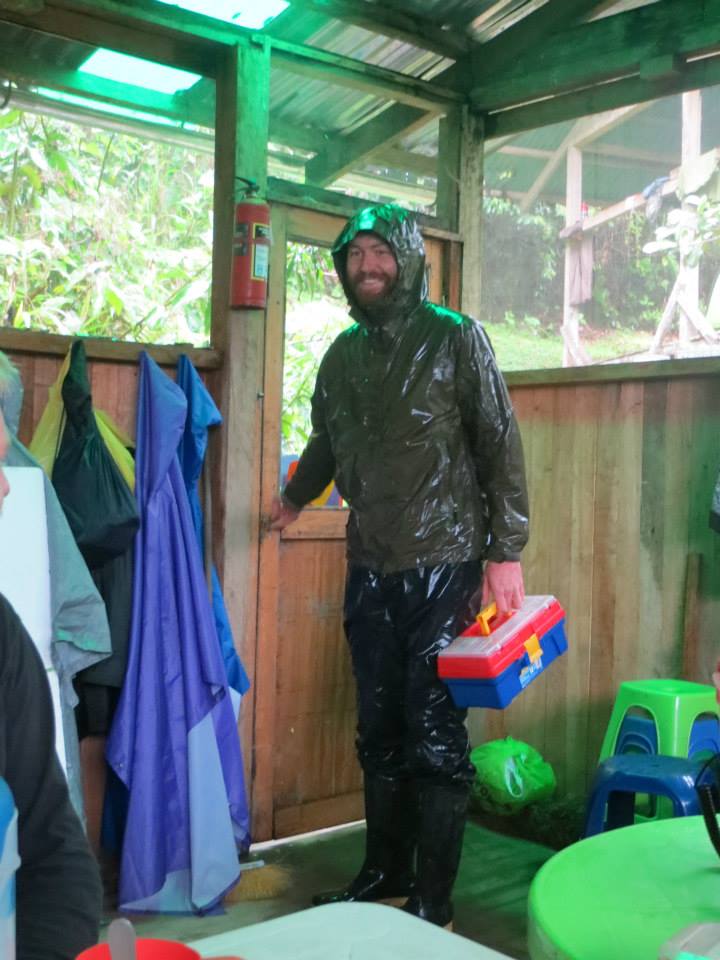
|
Ian Ausprey (USA) 2013
iausprey(at)yahoo(dot)com
I’ve been doing avian field work for 10 years, and this was definitely
one of the most memorable field seasons. Overall, I had a fantastic
time nest searching and mistnetting and would recommend it to people
with a high tolerance for extremely challenging field conditions,
camping, and lack of personal space. Below are some specific comments –
be aware that I was at San Pedro (and visited Pantiacolla for a week)
and conditions vary hugely among the stations. The challenges are much
longer than the highlights. This is because there are more details to
explain – every day in the field was a highlight for me.
Highlights:
1. Location and wildlife are spectacular. The forest at San Pedro
ranges from beautiful moss and epiphyte laden cloud forest to bamboo
stands to early successional scrub in former land slide areas. If you
are reading this then I don’t need to tell you that the birds are
fantastic!
2. I learned a huge amount about tropical avian ecology from direct
field experience. There are few other opportunities to be immersed so
comprehensively in the reproductive biology of tropical birds. I
interacted with nests from species that build domes in epiphytes, open
moss cups, burrows in banks, hanging domes, etc.
3. The people and cultural immersion were fantastic. Our crew was half
USA/Britain and half Colombia/Peru. This is a great opportunity to meet
wonderful biologists, immerse yourself in a new cultural perspectives
and work on your Spanish or English. A major reason for my
participating in this project was to work on Spanish, and I had a lot
of opportunities to do so. I also enjoyed helping the Spanish-speakers
with their English. There is also a lot of cultural learning to be had
in the nearby towns and on the buses. Many of the nearby communities
are indigenous where Spanish is the second language, so if you pay
attention, you can learn a good deal about much of the native
indigenous culture.
Challenges:
1. Make sure you like camping and can tolerate noise when sleeping. In
2013 the tent platform at San Pedro was isolated from the kitchen and
from the metabolics lab with the generator, so it was easy to find
peace and quiet. Not so at Wayquecha where the tents are crammed in a
small room next to the generator and kitchen or at Pantiacolla where
the tents are ~5m from the living area platform. People aren’t always
very polite when it comes to noise at night, so take this comment
seriously.
2. Field conditions are hard. Be very honest with yourself that you can handle them. Pros and cons for the stations are below:
a. Pantiacolla: Trails are flat and big and near the station, so hiking
among sites is fairly straightforward. However, you have to deal with
bullet ants, venomous snakes, and all other manner of lowland
rainforest fauna that you need to avoid. It’s very hot and humid. There
is no internet at the station or at the nearby towns, so plan to be out
of touch. This is an incredibly isolated place, far from medical
services or communication. I recommend contacting people who worked
there for candid advice on the very extreme living conditions you will
experience there.
b. San Pedro: Trails are challenging and not maintained. Look for lots
of wet and/or moss-covered rocks, roots, steep banks and stream
crossing that can easily trip you up. Expect to hike up to 3 km one way
to the farthest nest searching plot – it will take an hour for you to
get back to the station from there. You sometimes have to cross a large
stream that very quickly rises and falls with rainfall at higher
elevations. Expect a good deal of rain and chilly temperatures -
I finished my field days cold and wet 50% of the time . However, San
Pedro is the cushiest site with a beautiful big tent platform,
bathrooms, showers, running water, and a hummingbird garden in the
lodge. The internet technically exists, but it is incredibly slow and
barely functional beyond basic email.
c. Wayquecha: I did not visit the site, but I was told that the trails
are very steep and that the weather was very cold with a good deal of
rain. The “hot” showers also were not hot until November. There is
internet. However, you get to visit nearby Paucartambo, a really lovely
Andean town, on your days off.
3. Communication can vary from good to virtually non-existent depending
on your station manager. I had to ask about nearly everything and
generally found the training to be ad-hoc. This was problematic as the
project has many components and I discovered what I was supposed to do
for many things after the fact. It can be even more challenging if you
don’t speak Spanish.
4. Some people will find the food difficult. However, I found it
surprisingly tasty – lots of lentils, beans, rice, pasta, and cat food
(minced canned anchovies). Vegetables were plentiful (note that getting
food to Pantiacolla can be difficult and sometimes vegetables are
lacking there). Fruit was limited to the local tiny tasty apples. You
get one egg and two pieces of bread plus some oatmeal for breakfast. If
you are hard core carnivore, you may find this diet a shock. I’m a big
guy and eat a lot and was rarely hungry.
5. The language divide is real and requires a lot of work to overcome.
I can communicate effectively in Spanish, but I am nowhere near fluent
enough to participate fully in the colloquial fast-paced conversations
that the Latinos had. It was the same for the Latinos with basic
English skills. Since there were no truly bilingual people on the crew,
meals usually split into two groups. It required a lot of work for the
people with exposure to the other language to bridge this split.
However, when it happened, it was extremely rewarding.
6. Nest searching is extremely challenging at San Pedro. There is
almost no behavior to watch and the birds are extremely secretive. Most
nests you find will be via systematic searching or luck when a bird
flushes. Most people on the crew were very frustrated and several
people did not find more than a few nests. Although Gustavo has put
together a nice field guide of nest pictures the project does little to
orient people to a lot of information that would make nest searching
more focused, such as nesting strategies and locations, nest and
territory locations from previous years, and timing of breeding. From
talking to people, it sounded like nests were much easier to find at
Pantiacolla (they found almost 4x the number at San Pedro) and also
challenging at Wayquecha.
7. The budget on the project is extremely tight, so expect a lot of old
and, at times, inadequate equipment (especially for the banding).
|
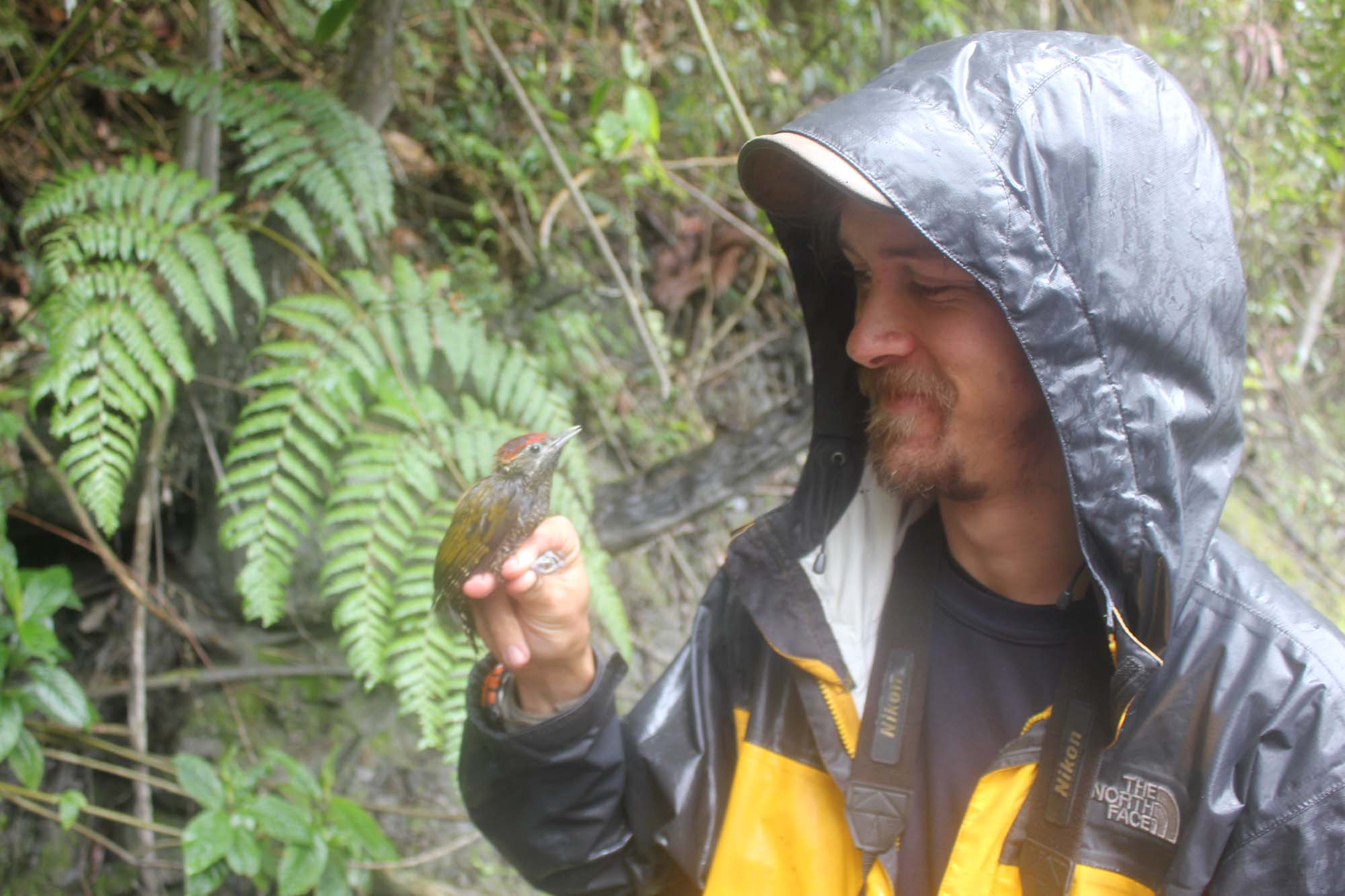
|
Justin Baldwin (USA) 2013
justin(dot)wheeler(dot)baldwin(at)gmail(dot)com
Working as a volunteer in the Manu Bird Project was incredible. At
Wayqecha, the habitat diversity in the immediate vicinity of the cabin
is phenomenal, with Puna grasslands above, elfin forest around, and
cloudforest below, and the birdlife was expectedly wild. The focus of
the project is unique. The overarching questions of the project deal
with community ecology, but on a day to day basis you end up doing a
lot of descriptive work with a large natural history component.
This is the work that Gustavo publishes with field techs, as the
species you encounter often lack basic life history information. To be
able to hold nestlings and think “No one has ever measured nestlings of
this species before” is pretty incredible, and happened more than I
expected.Gustavo is a great motivator and mentor and his enthusiasm is
infectious. The learning curve is ridiculously steep, and at beginning
of the season, there was a lot of
flying-by-the-seat-of-your-pants. But one becomes very skilled at
what one does by the end, and this job taught me more different field
skills than any other field job I have done. There is also a lot
of improvising, as the site is kind of remote, and the nearby field
station (Wayqecha Lodge) lacked basic tools.
The work was intense, 6 days a week we were on our toes for 10 h a day,
nest-searching, and if your job is to do metabolic experiments, then
you stay awake for sometimes more than 24h every four nights. Don’t
realistically expect to do any other side-project of your own design –
this volunteer work requires full-time effort. That said, lots of
techs publish work with Gustavo, and the projects more or less follow
the formula of “Reproductive Biology of [insert little-known-species
here]”. But the work is varied enough to make it rarely get dull.
However, nest-searching can be very difficult, especially when days go
by without finding new nests and with few pointers about what to look
for (in part because some species’ nests there are still
undescribed). But then you have days when you find a bunch of
nests and feel like a million bucks. But the toil is worth it!
Being outside in mindblowing diversity all day long makes for
unforgettable animal encounters (turning around and being face to face
with pumas) and physical challenges (“How badly do I want to free-solo
up this 40ft cliff to lasso that Oropendola nest?”) that will push your
limits and let you practice figuring out how far you are willing to go
for science.
If you want to figure out if you like ecology in the Neotropics, or
field biology in general, this job is the way to do it. Please
contact me with any questions.
|
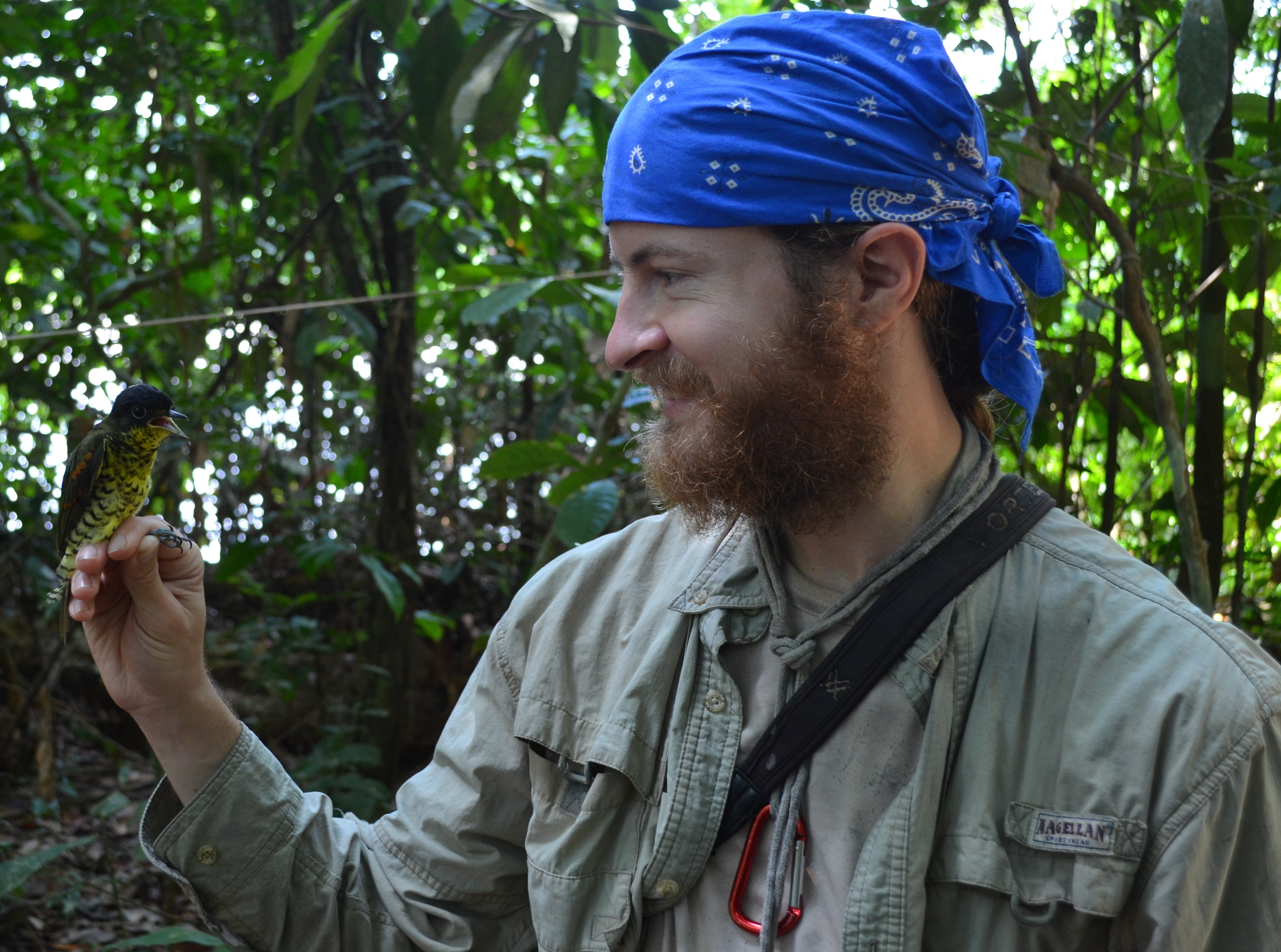
|
Blaine Carnes (USA) 2013
blainehcarnes(at)gmail(dot)com
I spent the 2013 season mist-netting at Pantiacolla. Out of five years
of fieldwork and seven previous trips to the tropics, this was both the
most difficult and the most spectacular field season I have been part
of. The biodiversity at Pantiacolla is significantly more impressive
than other places I’ve worked (the crew saw 10 species of monkey, 3
species of cat, tapir, giant anteater, capybara, more herps than I can
remember, and 450+ species of bird). There were numerous days where 13
hours in the field would fly by because of all the things to notice.
Come prepared. If this is your first trip to this part of the world, I
highly recommend getting a copy of Birds of Peru and studying it so
that you’re not overwhelmed on arrival. You will lose weight because of
the workload and limited diet (there’s only so much food that can get
to the stations at a time because of the transportation and
storage—plus there are issues with bats, rats, opossums, and monkeys).
If you read through the statements from other previous field assistants
you’ll come across most of the frustrations that occur at these
stations. This is a large project in a very remote, very difficult
environment, and it can be a struggle to keep the logistics of
everything in order.
Due to the living conditions and work, it’s very difficult for me to
recommend this project for anyone without much field experience; but
for those who are ready for a challenge and those who are willing and
able to learn from the people around them, this will be one of the
greatest experiences of your lives.
|

|
Stephanie Cavaghan (Canada) 2013
stephaniecavaghan(at)gmail(dot)com
Working on the Manu project was definitely a challenge but a worthwhile
one. If you can handle eating rice and beans for days on end and hiking
for 10-20 km’s a day this is the project for you. Also, being open and
easy going is a must as living in close quarters with people you just
met can get a little cozy.
I spent around 4 months living/working at the Wayqecha station. It was
an amazing and truly educational experience. This station may not have
the diversity of the other two but if you like amazing views and
landscapes this is the place to be. The temperature range throughout
the day takes some getting used to. In the morning it can be near
freezing and by the afternoon on a clear day it can be 25 degrees
Celsius.
For future field assistants I would recommend bringing cards, books or
games along with you, especially with banders the days can be long and
relatively boring without a distraction or two. Also, bring along extra
spices to put some diversity into your cooking day, your crew will love
you for changing it up. Bring along some treats from home as well, I
would recommend protein bars, peanut butter or nutella.
|

|
Juliana Ceron Cardona (Colombia) 2013
juli(dot)ceron(at)gmail(dot)com
Aprender a vivir por largo tiempo en la selva ha sido una de las
mejores experiencias de mi vida, descubrir cosas nuevas de la
naturaleza todos los días y dejarse seducir por este bello lugar es
algo mágico, me sorprende tanta diversidad de vida, tantas historias
que se tejen cada instante y tener el privilegio aunque sea por un
corto lapso de tiempo poder observar. Toda una puerta abierta a la
imaginación, exuberancia y aprendizaje. Las aves en este lugar son
fascinantes y conocer sobre su ecología y comportamiento es algo muy
gratificante, poder encontrar tantos nidos diferentes y dejarse
maravillar ante tanta gracia. A la vez convivir con personas de
diversas culturas y poder hacer amistades fuertes es muy grato. Esta
experiencia fue de gran crecimiento personal, de entender lo importante
que es cultivar la paciencia y de darme cuenta que grande parte de mi
vida la quiero pasar en el monte, explorando y descubriendo. Gracias a
Gustavo y Jill por haberme dado esta oportunidad y por enseñarme tantas
cosas durante la temporada.
|
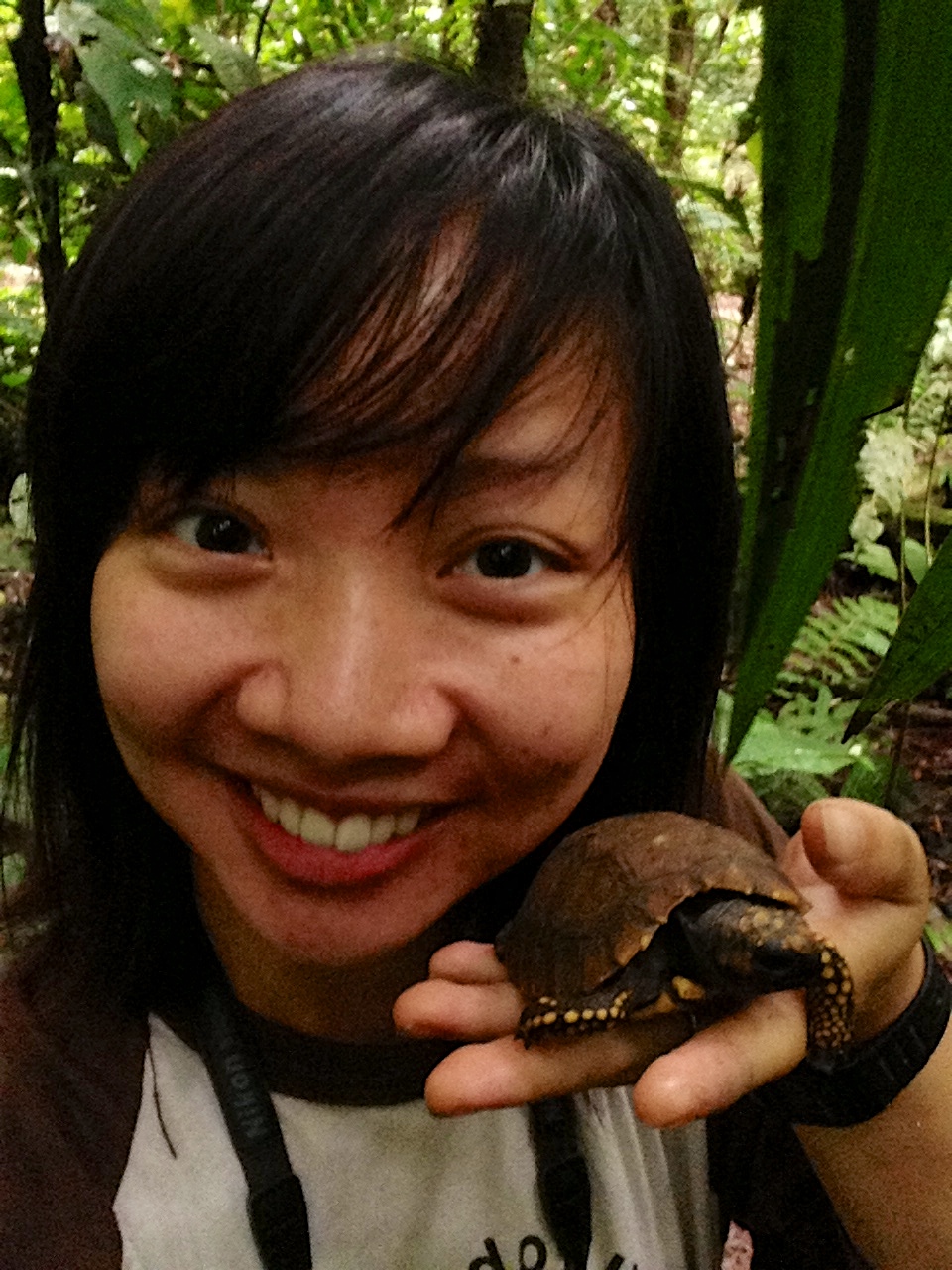
|
Nancy Chen (Canada, Taiwan) 2013
nanstchen(at)gmail(dot)com
Deciding to stay at Pantiacolla has been the best decision I made in my
entire life. Now that statement might sound a little bit intense, but 5
months in the Peruvian Amazon is truly just that. Pure intensity over
the top. In a very good way. Nobody will ever be let down by the
station as one is always surrounded by the marvelous forest while
witnessing nature taking place at great proximity, AND at the same time
being surrounded by wonderful like-minded naturalists. The
disconnection from modern distractions allows you to fully explore your
surrounding and yourself, and you will come out of the jungle reborn
with a brand new perspective about nature and people (yourself
included!). I was very lucky to have an awesome team (Pantiacolla
2013!!) that was always very supportive and made the hikes, the rides,
the beans and lentils and the lack of modern convenience means to enjoy
life at its best, so I never found these lacks as obstacles to enjoying
my field season. I should not forget to mention all the crazy birds,
cats, snakes, monkeys, ant-eaters and armadillos that you will
encounter during your stay, and that all the station managers and
project directors are wonderful, wonderful people.
Now moving from the general descriptions. For people that are doubting
whether Pantiacolla is a good fit for them, as long as you are an
open-minded individual (8 or above on scale 1-10) with a very, very
strong drive to learn and has profound love for nature, you should give
this place a chance. You cannot be allergic to ants, wasps and
mosquitos, you cannot hate cooking, and you should also be able to
adapt quickly to situations as well as handle a good dose of
craziness—we’re talking about equipment breaking down in the middle of
nowhere, flooded tents, and bad beer!
I wil wrap up with the quote list from Pantia2013 that will help
determined Pantias yet-to-come along with some personal interpretations
and advice:
1. It will rain. (rain gears please; I brought 2 pairs of boots and felt really smart about it)
2. Socks are gold, Oreos are diamonds; fried Oreos are fried diamonds.
(bring double-digit socks and snacks. 10 is the minimum. Bring your
spices, spreads and sauces too)
3. Flag everything. (You will lose something to the jungle at some
point, so make sure you attach everything tightly with you. I lost 2
cameras.)
4. It will mold.
Also consider bringing:
a) a bunch of long sleeves for insect protection.
b) very good binoculars to make your life easier especially if you’re not an experienced birder.
c) best headlamp(s) that will blind your eyes when staring at it; they
are very good for detecting animals during epic night walks.
d) rechargeable batteries for your headlamps. I cannot tell you how
many people had to get these babies when down here. Not that easy to do
though.
e) music. Party music sounds even better in the jungle.
Please do not hesitate to contact me if you have any questions about the project or the station. Good luck!
|

|
Miranda Ciotti (USA) 2013
mirandaciotti(at)yahoo(dot)com
My experience as a research assistant with Gustavo was educational in
all areas. I believe it is a unique opportunity to gain a well rounded
experience in evolutionary biology through hands on research and much
time in the field. I have left the project with new skills in field
research ad well as a new found interest in ornithology and renewed
love for the outdoors. If you have a love for being outside, hiking,
and asking questions about the natural world then this is the position
for you! A few words of caution and consideration: If you are not
interested in invasive research methods, than this is not the study for
you. If you need meat or special dietary needs, bring your favorite
energy foods for nutritional support (nuts, peanut butter, dried fruit,
protein powder, bio pills) as well as moral support. Spending a field
season exploring the forest is a memorable and rewarding experience,
but it can become mundane toward the end. To keep a sharp mind and
fresh spirit I would recommend bringing games (cards, chest,
backgammon), movies, books, art supplies, musical instruments- whatever
activities that make you happy at home are worth bringing to your field
station to share with your crew. It will make the experience richer and
everyone happier. Please contact me if you have more questions. Have a
great season!
My experience as a research assistant with Gustavo was educational in
all areas. I believe it is a unique opportunity to gain a well rounded
experience in evolutionary biology through hands on research and much
time in the field. I have left the project with new skills in field
research ad well as a new found interest in ornithology and renewed
love for the outdoors. If you have a love for being outside, hiking,
and asking questions about the natural world then this is the position
for you! A few words of caution and consideration: If you are not
interested in invasive research methods, than this is not the study for
you. If you need meat or special dietary needs, bring your favorite
energy foods for nutritional support (nuts, peanut butter, dried fruit,
protein powder, bio pills) as well as moral support. Spending a field
season exploring the forest is a memorable and rewarding experience,
but it can become mundane toward the end. To keep a sharp mind and
fresh spirit I would recommend bringing games (cards, chest,
backgammon), movies, books, art supplies, musical instruments- whatever
activities that make you happy at home are worth bringing to your field
station to share with your crew. It will make the experience richer and
everyone happier. Please contact me if you have more questions. Have a
great season! |
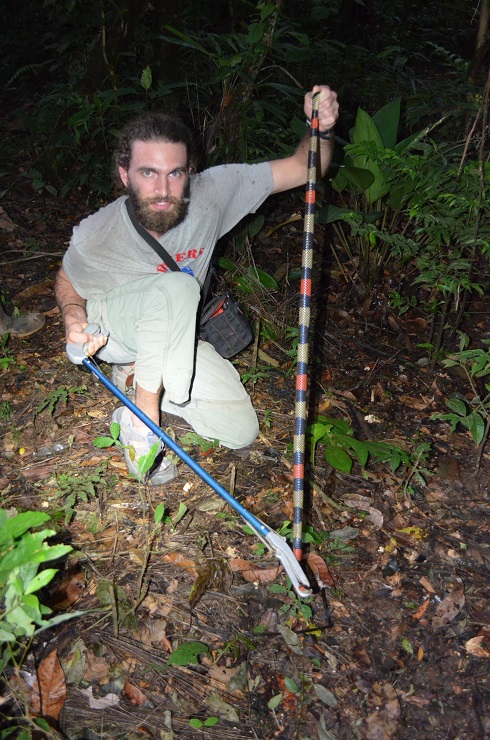
|
Justin Demianew (USA) 2013
jad97(at)humboldt(dot)edu
I spent the Fall of 2013 running around the lowlands of the Peruvian
Amazon (station: Pantiacolla), chasing birds and searching for their
nests, mist netting, catching snakes, frogs, and caimans. I saw
many of the most venomous snakes in the western hemisphere as well as
margay, ocelot, poison dart frogs, grison, tyra, peccaries, too many
birds to mention, many species of monkey, beetles galore, fresh water
rays, eels, and many other wicked and badass animals. Every day I would
encounter a new species (for me) of either an insect, bird, reptile or
amphibian. The biodiversity is off the charts. In the
jungle you will, without a doubt, see lots of crazy and out of this
world creatures. In summary it was an amazing and rewarding
experience and you are guaranteed to have the time of your life.
Warning: The jungle is a rough and tough environment. To date I
have participated in many field projects, but the conditions of
Pantiacolla were by far the harshest. The heat and humidity can be on
the verge of unbearable. Thankfully there are many streams to
jump in and a river to bath in at night. Going to bed dripping
sweat (literally) is a very common occurrence. Bring supplies
accordingly. DO NOT BRING leather ANYTHING. Shoes will mold and
fall apart, your wallet will turn into a mold forest as well as your
belts. Bugs are abundant, it’s the jungle! I personally didn’t wear bug
spray (not a fan) although I did spray my backpack and tent for
chiggers. I recommend you bring some. Many of us had botflys or
other parasites. Don’t leave soaking wet sweaty clothes out to dry, at
least rinse them out first. You will probably get really sick, at least
once. Bring Imodium, pepto, and any other drug of choice.
Bring antifungal powder for your feet and maybe some crème in the event
of a fungal breakout. Full disclosure, I had holes in my boots
for two months, which meant my feet were soaked all day every day and
luckily I didn't have any fungal issues. However, I used powder
and wore sandals at all times around the station to keep the feet aired
out. I recommend you do the same. I would also bring
a bike tire repair kit for the holes in boots. It works!
Other advice to volunteers:
If you wear size 10 or bigger bring your own rain/rubber/gum boots.
Seriously, you probably will not be able to find your size down here.
If you do not have to bring electronic equipment, DON’T! Many of us had
problems with electronics after months in the humidity. Even if
your stuff doesn’t get wet directly it is subject to the harsh and wet
environment. If you do want to bring electronics I recommend you
invest in some silica, lots of good ziplock bags, and real dry
bags. You should definitely bring ziplocks and dry bags for
everything you own. No matter what it is your stuff will mold:
tent, cloths (even in bags, but at least it slows the process), shoes,
backpacks (both the big one you will keep in your tent or on the
platform and especially your field bag), your sleeping bag and
mattress….EVERYTHING.
Bring field guides for taxa you are interested in. These are not
present at the stations. There are probably many more things I failed to
mention. If you have questions or concerns please feel free to
email me. Also, although I can only speak for Peru, if you are
considering the Colombia project I think much of this is very
applicable.
And finally, be prepared to have the field season of a life time, Suerte!
|
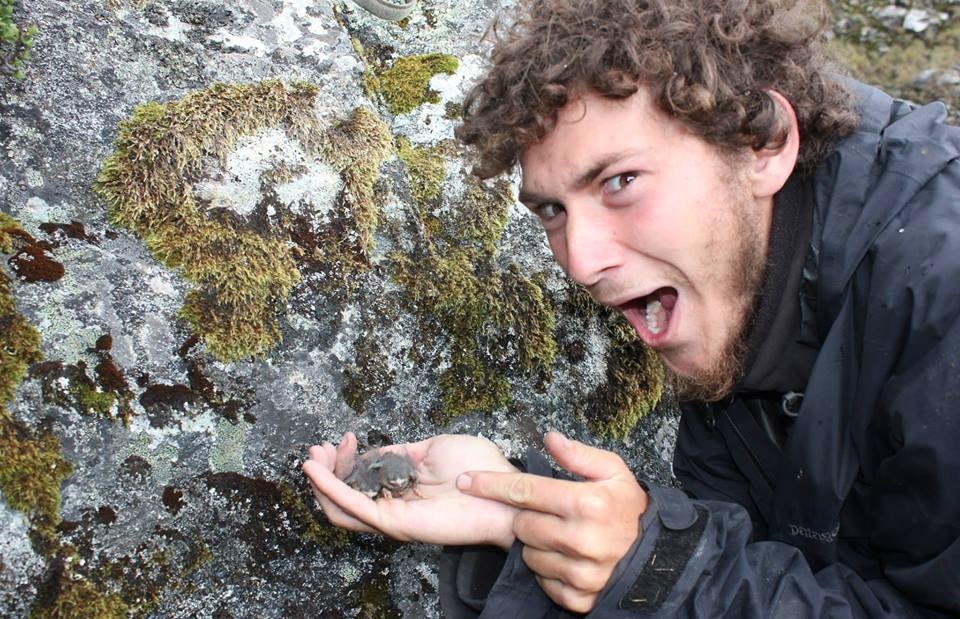
|
Jacob Drucker (USA) 2013
jacobdrucker92(at)gmail(dot)com
Working for the Manu Bird Project was a life-changing experience for
me. Since a young age it had been my dream to do field work with birds
in the neotropics and this project allowed my wish to be fulfilled.
Like any good dream there was a good amount of being cold, wet,
occasional hunger, and plenty of frustration, but all this was
surpassed by the zen and adrenaline of nest searching, the joy of
working with nestlings, the excitement of birdwatching, and the
breathtaking landscape that is Wayqecha. Add in having the most
incredible group of co-workers in the world and all of Manu road for
potential exploration on days off, and you might as well be in
paradise. My time in Manu has helped me gain a better view of how I
would like to pursue my passion for ornithology and evolution, and
provided me with connections, friendships and memories that will stay
with me forever.
|

|
Colin Fagan (USA) 2013
colin(dot)fagan(at)ksc(dot)keene(dot)edu
I worked on the metabolics team at Wayqecha from August to December of
2013. I can say that it was every bit the adventure I was hoping it
would be. Through this project, I was able to explore one of the most
unique and amazing habitats in the world. As a junior in college, it
was a needed change of pace. It is rare that a student at my age is
given the opportunity to work hands on with tropical birds in such a
remote setting.
I jumped into this project with little previous field experience, and
no experience working with birds. My advice to anyone with a similar
background looking for an adventure is to apply to this project! My
fellow field technicians and station manager were amazingly positive
and motivated me to push my limits as an ecologist and a person. I
learned more about ecology, the scientific process, and what it takes
to produce data on a grand scale than I had during all my years as an
undergraduate.
Here’s a little advice for those of you considering working at Wayqecha.
1. Invest in great rain gear, a pair of muck boots, and a decent pair
of hiking
boots.
-Towards the end of the season, the rain really picks up. To keep sane bring gear to stay dry
2. Bring protein
-Your diet at Waqecha will basically consist of vegetarian meals. It is
important to bring things like peanut butter, nuts, or even protein
powder to supplement your diet. You can’t bring enough extra food!
3. If you are considering the metabolics team bring entertainment
-Usually consisting of an eight hour shift, some metabolics nights can
be rough. However, they are a great chance for catching up on data, or
reading scientific papers if you’re a night owl. Movies on your
computer or a couple of books are also recommended.
4. Contact past field techs
-We have a good idea of what you’re in for. Send us an e-mail with questions about anything!
|

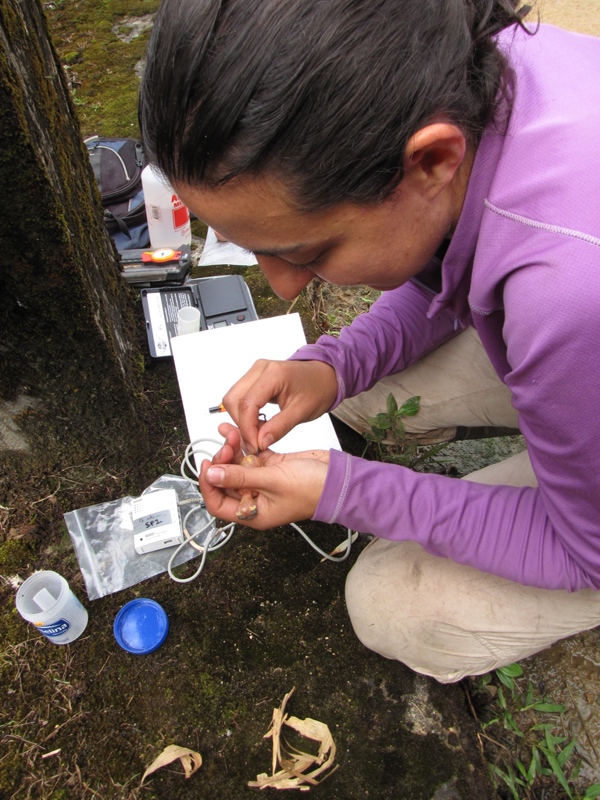 |
Laura
Gómez (Colombia)
2012, 2013
laugm3(at)gmail(dot)com
2013: De
regreso en el Manu redescubrí porque me gusta tanto internarme en el
monte, alejarse de las obligaciones sociales y dedicarse a observar el
mundo sin más presión que una nube gris sobre la cabeza o el hambre que
recuerda que ya es medio día y hay que comer para continuar
caminado…Como mi experiencia del año anterior esta fue inolvidable y
llena de buenos momentos, increíbles aves y nidos y un montón de otros
bichos que alegraban cada día. Además la oportunidad de conocer gente
de todo el mundo y compartir diferentes costumbres, comidas e idiomas
siempre enriquece la experiencia…Este año igualmente estuve en las
estaciones de San Pedro y Pantiacolla, y de nuevo lograron maravillarme
con todas las sorpresas que a su modo cada uno de estos bosques
guardan. Si estás pensando ir a alguna de estas estaciones por favor no
olvides una chaqueta para la lluvia y una buena bolsa seca para tus
equipos electrónicos y además buena disposición para caminar mucho y
trabajar duro; lo que aprendas en el proyecto va a depender en gran
medida de ti, entre más camines más cosas puedes observar, entre más te
esfuerces más nidos puedes encontrar…
2012: Participar
en el proyecto fue y será siempre una de las mejores
experiencias de mi vida.
Tuve la enorme fortuna de trabajar en las estaciones de Pantiacolla y
de San
Pedro, pero aún no puedo decidir si me quedo con la exuberancia,
tranquilidad e
inmensidad de tierras bajas o la magia y la belleza del bosque de
niebla…El
proyecto además de brindarme la oportunidad de conocer
más sobre las historias
de vida de las aves, su fisiología y enorme diversidad, me
permitió crecer
enormemente a nivel profesional y personal, no solo al lado de
excelentes
maestros como lo son Gustavo y Jill sino
también de mis compañeros y maravillosos amigos que me
enseñaron cada día la
importancia de la paciencia y de ser tolerante, pero sobre todo de
nunca perder
la curiosidad…Gracias a todos!!! |
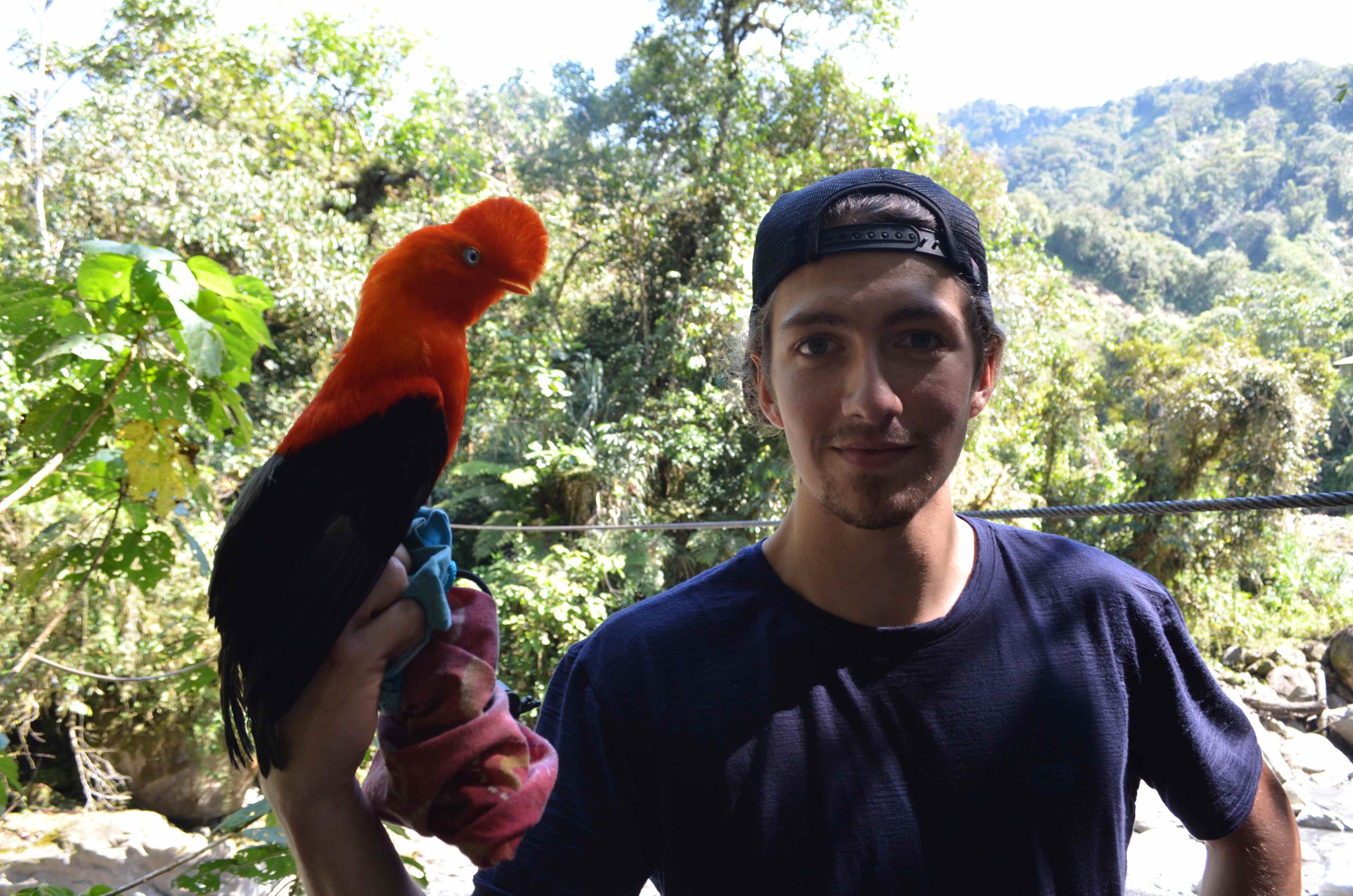
|
Julian Heavyside (Canada) 2013
julianheavyside(at)gmail(dot)com
In this moment, I deeply wish I could be back down the
Manu Road. The trip was life changing. I had the opportunity to work on
the banding team at both the San Pedro and Pantiacolla stations, so
feel free to email me for detailed accounts of my experiences there.
As stated by many other assistants, living conditions at all the
stations can be challenging. However, in my opinion, this is all part
of the complete experience. You may be cold, wet, and/or hungry at any
point, but the truly spectacular biodiversity will make up for it.
Because there is so much to see, everyone had completely unique viewing
experiences. During meals, we would all share our day's sightings, and
we had always seen different and equally amazing things. There is great
potential to observe stuff that is barely known by science, which is a
beautiful concept in today's world. If you haven't been to the tropics
before, they will blow your mind. If you have, you know how radical
they are, and you should get the heck back down as soon as possible.
I'll keep it brief, but here are my key suggestions which I urge you to strongly consider:
-Definitely number 1: go on night walks!!!! In four months, when you're
back home and the trip is over, you'll be sitting on your couch wishing
you'd caught more spectacled caiman, seen more margays hunt night
monkeys, or heard more tropical screech owls. Take a nap after the day
of work, and hit the trails. You will never regret it.
-On a related note, bring the best headlamp you can afford. An entirely
new set of animals comes out at night, and you will miss them if you
have a crummy light.
-Consider bringing burly rubber boots, or stiff footbeds, because the local boots have thin soles and offer little support.
-Go to a shoe store and pick up 100 packets of silica gel for free.
Empty them out into a stocking, and put it in a tupperware that seals
well (you can buy good containers in Cusco at "Plastico 2000"). This
will be a drying chamber for your camera etc., because it is humid down
there! Cook the silica in a frying pan to dry it out, and repeat.
-Banding team: do your furthest and most-challenging sites first. You
will need to camp, or hike ~1hr to some stations, and weather can
become a problem later in the season. Get the tough stations done
first, so you can be less stressed at the end of the season when the
clear days are few. Also, banding in the tropics is slow sometimes, so
bring a book!
-Nest searchers: sometimes, you will go a long time without finding
nests. Keep your head up and keep moving. You won't find much if you
sit by the river feeling sorry for yourself (which I admit I sometimes
did). The nests are there, you just need to notice them. It's hard to
search without much of a target image (you'll be looking for nests of
all species), so you basically just need to keep walking around and
poking everything suspiciously nest-like. Eventually you will be
rewarded.
Other recommendations:
-Neotropical Rainforest Mammals field guide
-peanut butter
-sewing kit
-butterfly net (just bring the mesh, you can make a good pole and hoop with bamboo etc.)
-a little spanish goes a long way
|
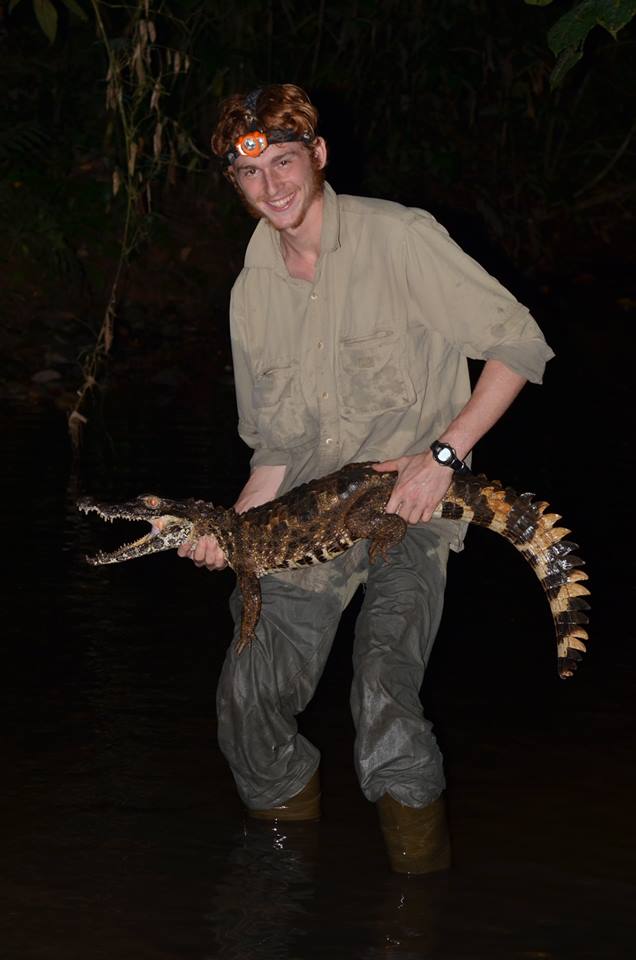
|
Jeremiah Kennedy (Canada) 2013
fisherking(at)telus(dot)net; a6c21768(at)telus(dot)net
I was lucky enough to spend the bulk of the 2013 season at the
Pantiacolla field station not far from Manu National Park. Spending
four months in the Amazon basin is a treat and I would highly suggest
that any individual interested in the natural world take advantage of
this opportunity and apply for this project. Pantiacolla was my
favorite of the stations as I enjoyed the warm temperatures and the
extreme diversity.
The conditions are a bit rustic with a fairly small platform to spend
free time on and few food choices. This and the extreme humidity can
turn some people off, but I don’t think that anyone who even slightly
enjoys some warm temperatures and isolation would let these things get
in the way of an experience of a lifetime.
Bring some water-tight Tupperware, silica, quick dry clothing, long
pants, long-sleeve shirts, rechargeable batteries and anything else you
would bring into the field. Don’t forget optics and something to play
music on.
Go into the project knowing that it is a bit
“fly-by-the-seat-of-your-pants” run. Go with the flow and you will
definitely enjoy yourself, but don’t hesitate to make suggestions if
you see changes that should be made.
If I could only say one thing about the experience, I would say
“unpredictable.” You leave the tent clearing in the morning and NEVER
know what you will see: Cats, anteaters, forest-eagles, monkeys and
many, many other animals and plants that will take your breath away.
GO! Or you’re crazy.
|
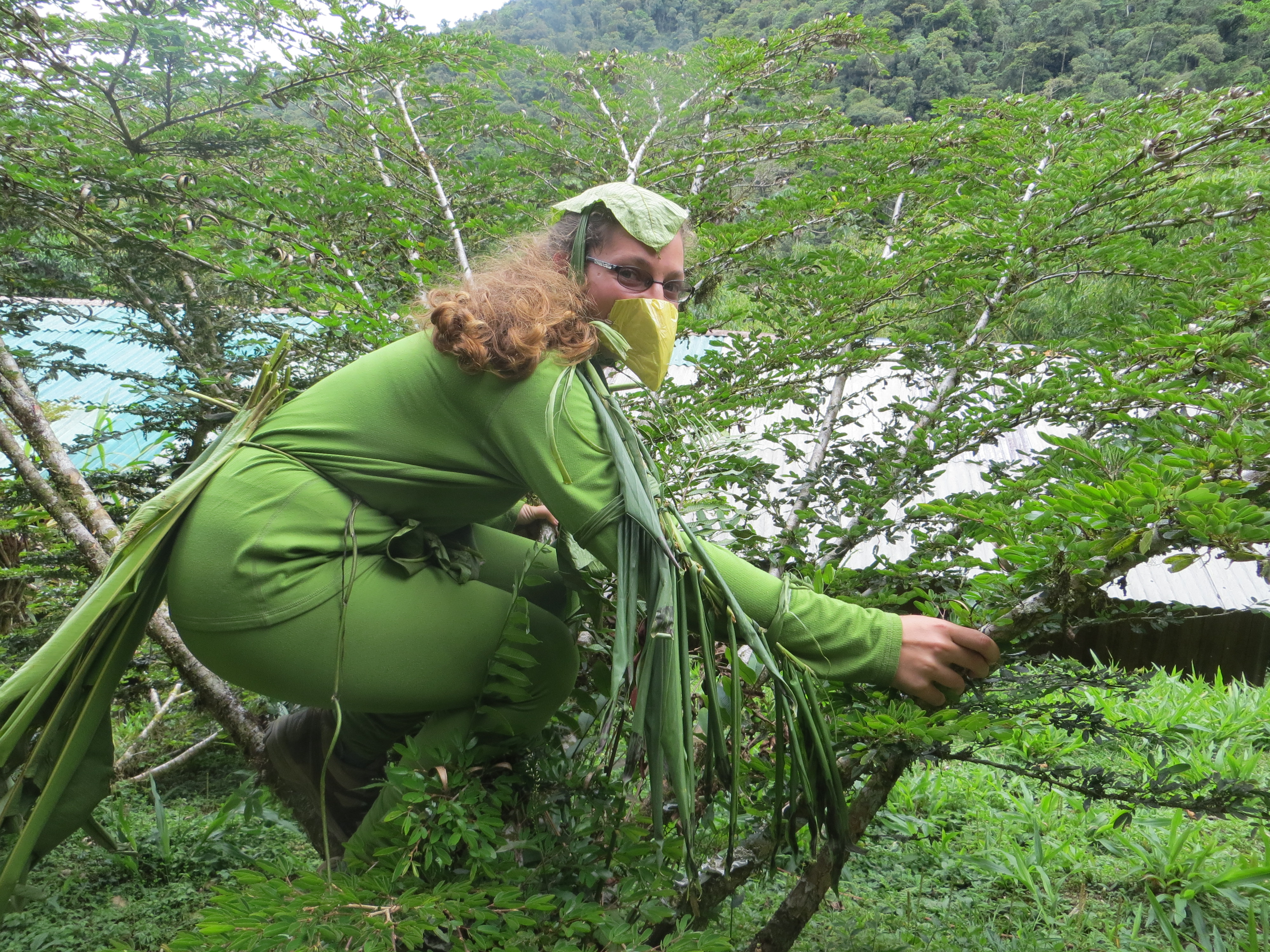
|
Stephanie Levins (USA) 2013
stephl301(at)comcast(dot)net
I was stationed at San Pedro in 2013. I was primarily on the metabolics
team, but I worked on the banding team for a month in the middle. This
project obviously had its ups and downs, but overall I learned a ton
and really got into birding. This project is so much more than just
birds, though. It’s meeting and working with people who share your
interests, learning about and living in a culture different from your
own, enjoying the wildlife that is all around you, and learning to make
the best of every situation (or at least laughing after the fact).
Here are some important things to know before you come volunteer-
In general:
-At some point you will be eating rotten food. The bread will mold, the
eggs will go black, the vegetables will be fuzzy, and you will get
really frustrated. Bring Pepto Bismol, trail mix, and a sense of humor.
-Bring some dice (5 for Yahtzee!) and a deck of cards and bond with your coworkers!
-Make the most of your time there. If you aren’t on the banding team
but want more experience banding, ask to join them every now and then.
-Go through ALL of the project equipment in the first week so you know
what you have. There was a bunch of (incredibly useful) stuff that we
didn’t realize we had until we were packing up in December.
-Get to know your coworkers, especially if they don’t speak your native
language. (Side note: attempt to learn SOME Spanish before you show up.
A little goes a long way.) Don’t let the group be divided based on a
language barrier.
San Pedro specific:
-It might be sunny and (sometimes) toasty during the day, but when the
clouds roll in it can get pretty cold. My 55+ sleeping bag was not
cutting it, so I bought a blanket in town which helped a lot. I also
bought a second blanket to add extra cushion to my sleeping pad. You’re
spending four months on a wooden platform – splurge and get a cushy
sleeping pad.
-The shower water is icy cold, and it’s usually not hot enough outside
for that to be considered refreshing. I’d guess that average number of
showers per week (per person) was 2-3.
-The Cock of the Rock Lodge staff are incredibly nice and friendly.
Talk to them when they’re around, and pretend there’s a chance you can
beat them in a game of soccer.
-The internet situation is nothing to rely on. Some nights you might be
able to send some emails and check Facebook, and others it might take
30 minutes to find out it’s too slow to even sign in to your accounts.
If you assume there won’t be internet in San Pedro, you’ll be
pleasantly surprised on nights when there is SOMETHING. To avoid a lot
of anger and frustration, seriously lower your expectations. (Skype is
not happening.) There is a decently cheap payphone in Pilcopata (the
town you go to for groceries), as well as a couple of internet “cafes”.
The internet at those places is also not great, but it’s better than at
San Pedro.
-Villa Carmen is a biological station & tourist hotel just outside
of town. It’s a great place to visit on your day off to enjoy the
wildlife of the lowlands. You can wander around the trails for free,
the staff are very friendly and eager to chat, and drinking beers by
the lake is the best way to relax (plus there are a ton of birds there).
Feel free to email me if you have any questions!
|
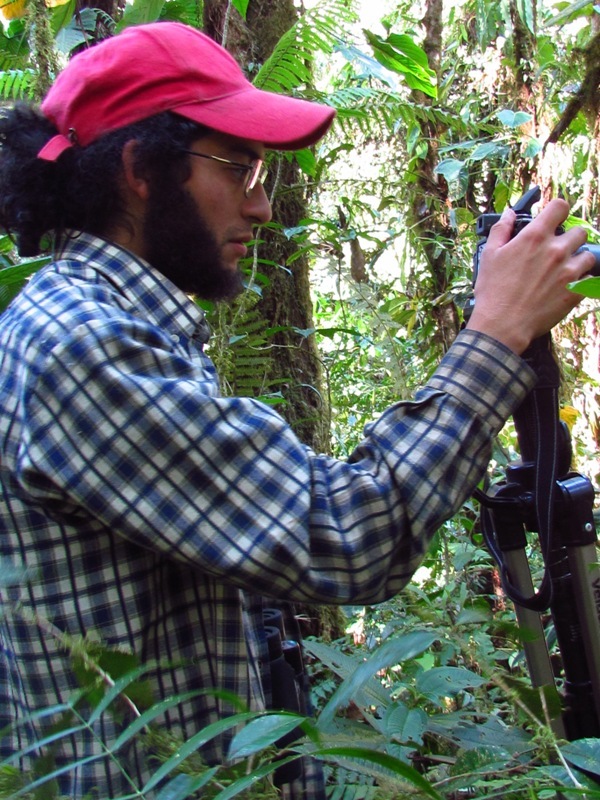
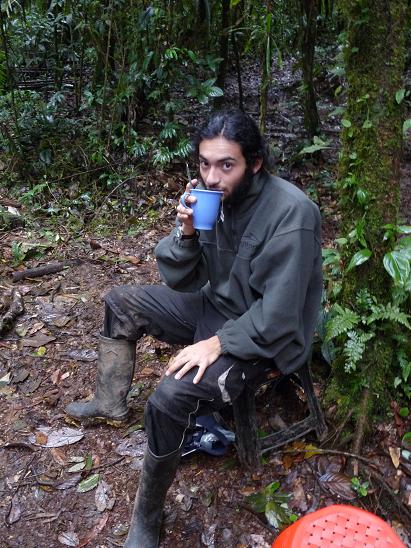
|
Mario Agustin Loaiza Munoz (Colombia) 2009, 2010, 2013
loaizamunoz01(at)gmail(dot)com
2013: Nunca será posible
saber quién de los dos nos enseñara más. Si tus compañeros de campo o
el bosque que te rodea, estos dos te muestran
los caminos para pensar diferente tanto de tu carrera como de la asombrosa naturaleza. Y entre estos amigos y bosques harán la
combinación perfecta para que como siempre sea inolvidable la
experiencia en el proyecto MANU. Proyecto que te acoge como parte de
una familia en la cual siempre podrás confiar, pues en ella encontré
personajes inolvidables, reencontré amigos y deje otro que quedó en la
memoria para siempre.
San Pedro con sus montañas y quebradas pone a prueba la fortaleza de un
buen biólogo naturalista, pues estas laderas escarpadas y cubiertas
de niebla es el lugar donde se entiende perfectamente la magnificencia
de los Andes y su climatología inesperada que cubrió con aguaceros
intensos estaciones, carpas, caminatas, fiestas, experimentos metabólicos y buenas tertulias entre inglés, español, francés y
quechua debatiendo la mejor forma de encontrar nidos, capturar las especies focales o que no se pegue el arroz a las ollas.
2010: La oportunidad
de regresar al proyecto ofreció
muchas más experiencias, aprendizaje, crecimiento personal y
profesional de las
que se esperaban. Gracias a los nuevos compañeros, los distintos
lugares y
travesías inolvidables que condujeron a lograr los objetivos
diarios, teniendo
la posibilidad de observar mas de seis especies de mamíferos y
un mínimo de 20
sp de aves dentro de doseles de mas de 40 metros e innumerables frutos
comestibles, algo que cualquier ser humano debería vivenciar. La
habilidad que se
adquirió en la temporada pasada se incrementó
disfrutando así mucho
mas ésta nueva oportunidad de vivir en la selva
amazónica.
Lo más invaluable de este proyecto
es, que al darse cuenta de la falta y el apoyo que ofrece la familia se
encuentran personas que dan la moral, la pasión, la
alegría y la energía
necesaria para seguir inmerso en el entendimiento de la vida y porque
las cosas
suceden en determinados momentos.
2009: El trabajo que
realice dentro
del proyecto me dio la posibilidad de comprender como ha funcionado la
vida
durante millones de años mostrándome como nacen, crecen y
mueren, insectos,
plantas y animales. Y descubrir que estos cambios suceden a diario pero
solo se
logran identificar cuando se vive entre sitios conservados y aislados,
en donde
tú eres considerado con un mamífero más en
la selva. La búsqueda de nidos es algo que
al principio es un poco complicado ya que no estaba acostumbrado a
detallar tan
minuciosamente arboles, matorrales, rocas, raíces, y un
sinfín de sitios donde
se ocultan los nidos, pero con el paso del tiempo se adquiere una
habilidad
única y se comienza a encontrar los nidos alegrándose a
diario de ver que ponen
los huevos y al cabo de unos días nacen los pichones y
entristeciéndose cuando
es depredado ya que se alcanza a coger cariño a los polluelos,
sin dejar de
lado que poder ver un evento de depredación es algo fascinante.
Pero no todo fue trabajo y
aprendizaje de la biología reproductiva de las aves, pues
conocer los otros
integrantes de la estación es algo magnifico, ya que cada uno es
diferente,
de cada uno se aprende algo nuevo, debido a que cada persona
tiene sus
aficiones, gustos, temperamentos específicos, culturas y
tradiciones.
Transformándonos en la familia TONO 2009 en la cual se
discutía y bromeaba.
En
mi proceso de formación como biólogo, persona
e investigador fue lo mejor que pude haber hecho.
|
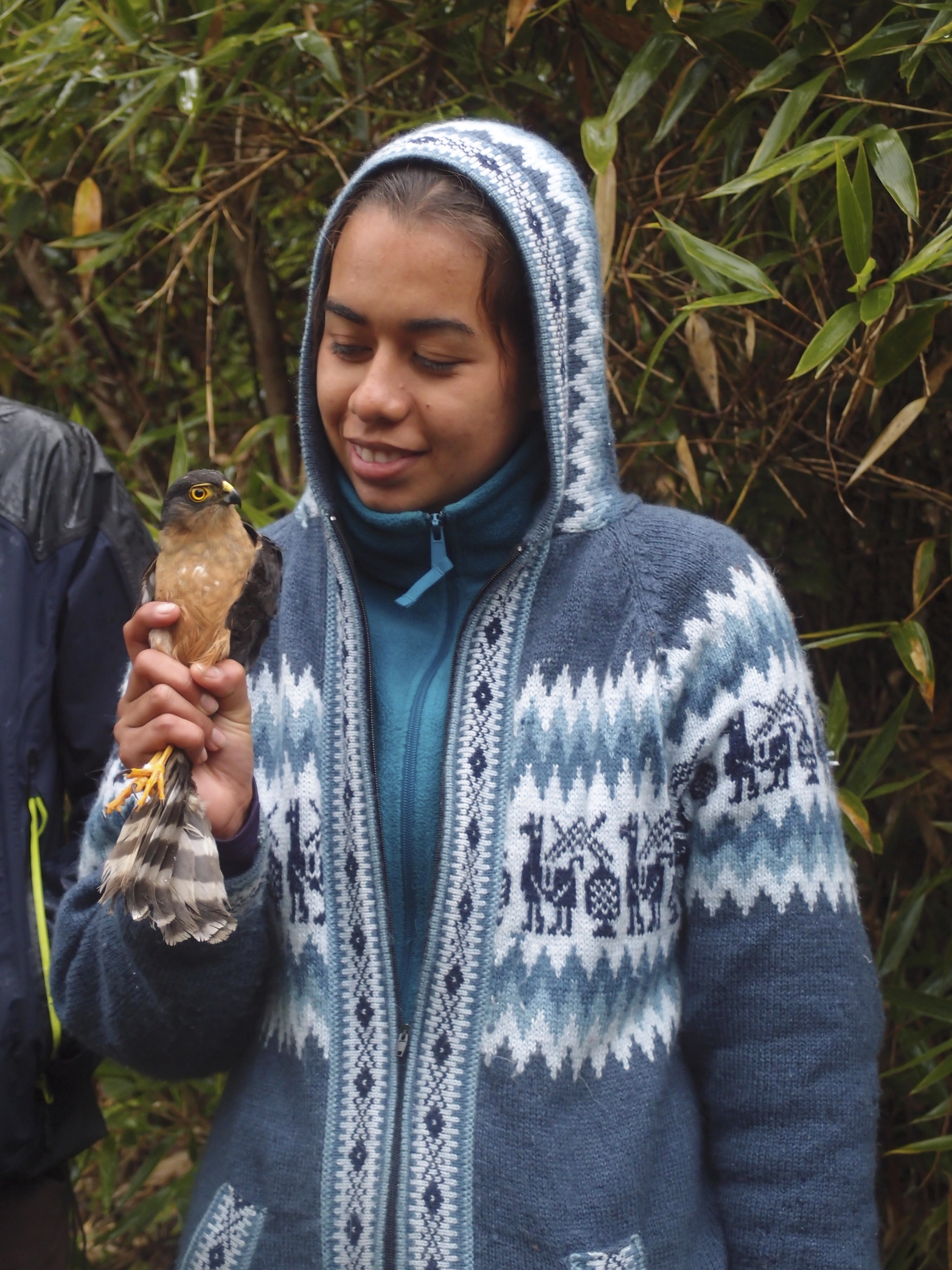
|
Gliselle Marin (Belize) 2013
gliselle(at)gmail(dot)com
The experience as a volunteer with the Manu Bird Project is one that
simply cannot be summed up in a single paragraph. When I signed up to
be a research assistant for this project, I expected it to have some
impact on my career as a biologist, but I certainly did not expect the
great impact it would have on my life. I was stationed at the Wayqecha
station in the cloud forest, and this was an environment unlike any I
had ever visited before. Wayqecha is wild in a sense that was unknown
to me, with unmatched views, and forests ranging from dense fern and
moss filled to scrubby, elfin forests. The Manu Project accepted me
even with a limited knowledge of Peruvian birds, but the intense and
demanding schedule allowed me to become immersed in a world of birds
that I quickly fell in love with. I found working with birds to be
personally fulfilling, and though I knew that birds were charismatic,
the hands on experience that we gained with this project allowed me to
see the beauty of their amazing habits, characteristics and innate
features. I developed my observational skills to a level I had not
known, and quickly became more careful and thoughtful both in my
recording and handling techniques.
One of the best parts of my time with the Manu Bird Project, was
meeting many wonderful people. This started with the project PIs who
personally visited with the field crews to inform and assist us on the
project. I was lucky to be on a crew that quickly became a family for
me, and introduced me to young biologists who are truly passionate
about the work they do. The project was personally a great
experience for me as a lot of the field work required independence and
good judgment, but the living situations highlighted a sense of
community. I treasured my time living with people who shared similar
interests and enjoyed being removed temporarily from a world of
convenience and getting back to basics. If you have a true passion for
ecology and conservation and enjoy personal challenges, I highly
recommend volunteering with the Manu Bird Project as the experiences
that come from it will be some of the most memorable and fulfilling you
will have.
|
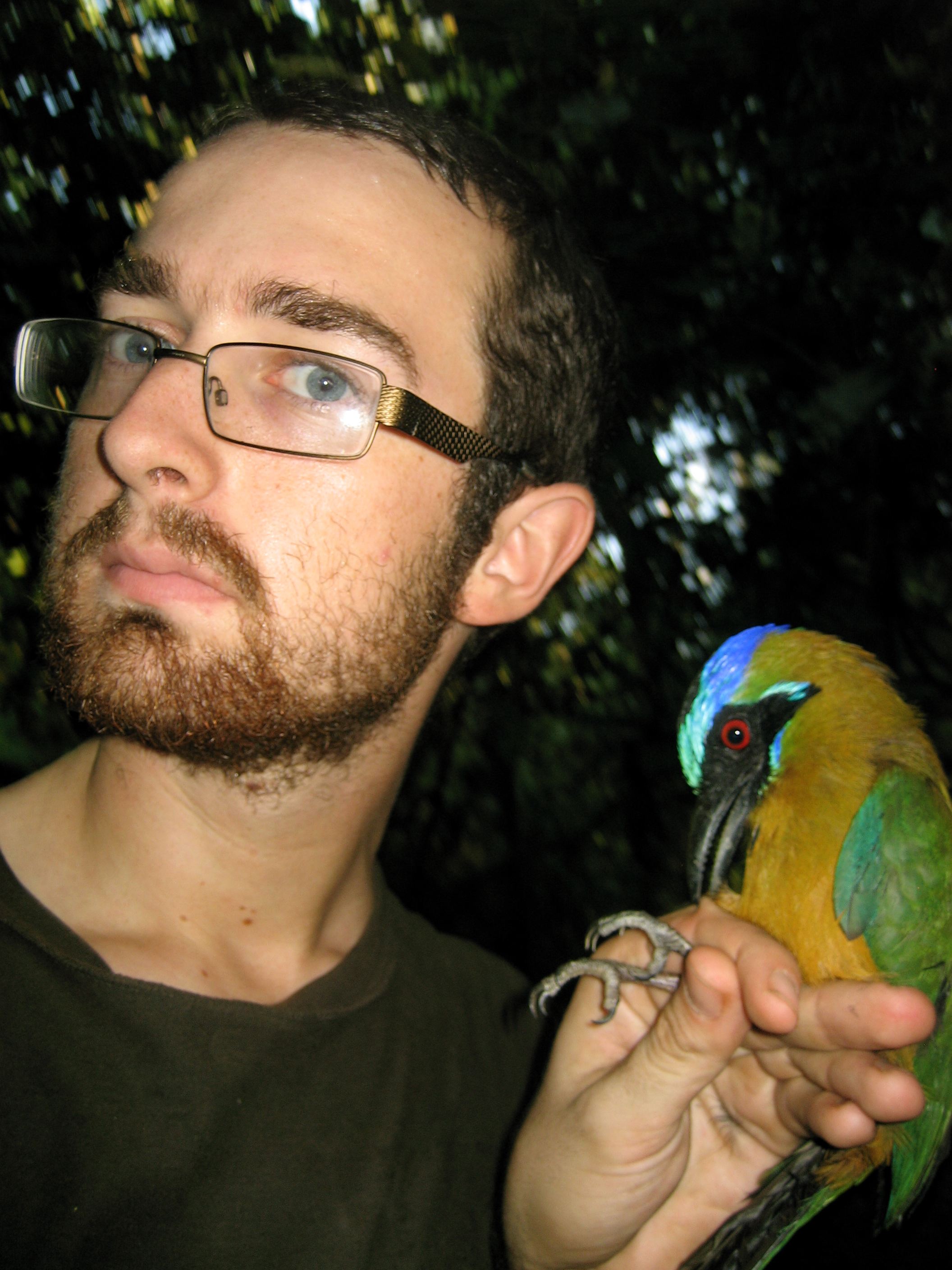
|
Adam Milch (USA) 2013
Amilch3(at)gmail(dot)com
The Manu project is undoubtedly one of the most interesting volunteer
projects someone can do in their lives. It is definitely not for
everyone, and it is important to make sure that you are at the right
point in your life to participate before applying. But this project is
well worth making time in your life to be a part of. Even though you
are volunteering, the feeling of reward you get from camping in the
rainforest for 4 months is worth more than any amount you could be
paid. You will meet some interesting people, see many interesting
things, and learn a huge amount.
I volunteered at the Pantiacolla station in 2013 and aside from getting
used to the food, weather, and bathing in the river, the feeling of
isolation from the outside world was the biggest adjustment for me. The
nearest town has a few small stores and a restaurant with a TV and a
payphone that you can use to call home (the US) for around 35 cents a
minute. Bring a lot of change with you because you can’t always
exchange bills for coins. The town is accessible in dry weather by
boat, and is around 15-20 minutes downstream.
This project will teach you much more about yourself than you think and
I highly suggest it to those who feel they are up to the challenge. It
is not easy but getting the rare experience to live in the Amazon is a
pricelessly unforgettable reward.
|
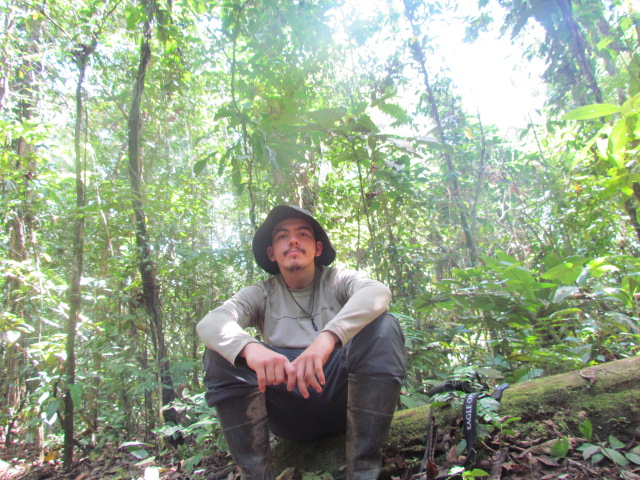
|
Alvaro José Rodríguez Cardona (Colombia) 2013
tigerwolverine7(at)hotmail(dot)com
Despertar en la mañana con el canto de los monos Aulladores, tomar un
breve desayudo y salir a andar por tan maravilloso lugar encontrándote
paso a paso con miles de pequeños y maravillosos mundos, aves
fascinantes, insectos de colores psicodélicos, monos, pecarís,
serpientes, venados, todo esto mientras juegas a las escondidas con la
vida en un mar de imponente vegetación verde, para después regresar al
medio día y compartir un gratificante almuerzo con tus compañeros,
reírse un poco, platicar sobre lo visto en la mañana y regresar de
nuevo a esa maravillosa selva.
Es verdad puede que haya momentos que sean duros, días que te vas con
las manos vacías al no encontrar un nido, uno que otro malestar
estomacal, tal vez una que otra caída, las mosquitos susurrándote al
oído palabras no precisamente románticas y calores sofocantes
alternados de noches supremamente frías.
Pero nada de esto logra opacar la magnificencia de estar ahí, en ese
corazón del mundo, sentirás la emoción de meter un gol de chilena cada
que encuentras un nido, sentirás que celebras un campeonato mundial
cada vez que te reúnes en la mesa con tus compañeros, sentirás la vida
misma al tomar un baño en el rio con un cielo plagado de estrellas
fugaces y al tener un pequeño huevo o polluelo entre tus manos.
Lastimosamente no pude terminar la temporada, pero indudablemente puedo
decir que fue la experiencia más bonita de mi vida, de regreso en la
ciudad ya nada es igual, y me paso las noches recordando lo vivido en
la selva y soñando cuando volveré a ella.
Si te gusta la selva, si eres un fanático de la vida, si te encanta trabajar con las aves, indudablemente debes estar allí.
|
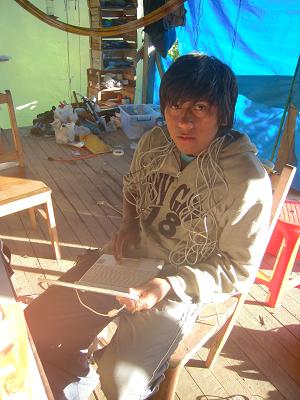 |
Manuel Andres Sanchez Martinez (Colombia) 2009, 2012, 2013
manusama79(at)gmail(dot)com
2012, 2013: La experiencia en estos dos últimos años (2012 – 2013)
estuvo llena de maravillosos momentos, en los cuales tuve la
oportunidad de conocer a excelente grupo de personas comprometidas con
el trabajo y capaces de sortear las diferentes dificultades que se
presentan en el campo. Dos años consecutivos me sirvieron para aprender
día tras día no solo de aves si no de un sin número de animales y
plantas. Lo que más me gusto de la estancia en la Amazonia peruana fue
el hecho de poder levantarme cada día y pensar que tenía toda la selva
para explorar, poder conocer a mucha gente y sus formas de vida, muy
diferentes a la mía.
2009: La
participación en
el proyecto la pasada temporada fue muy enriquecedor e importante tanto
personal como profesionalmente, ya que adquiri mucha experiencia en
trabajo de
campo, por ejemplo como tomar datos en campo, destreza en el empleo de
herramientas para la toma de datos, reconocimiento de una cierta
cantidad de
especies tanto de aves como otro tipo de animales y plantas, a sortear
algunos
incovenientes que se presentan en el campo, a aprender y a convivir con
varias
personas que tienen culturas diferentes. Por otra parte disfrute mucho
el haber
conocido un lugar que presenta un buen estado de conservacion con gran
gran
biodiversidad asociada.
|
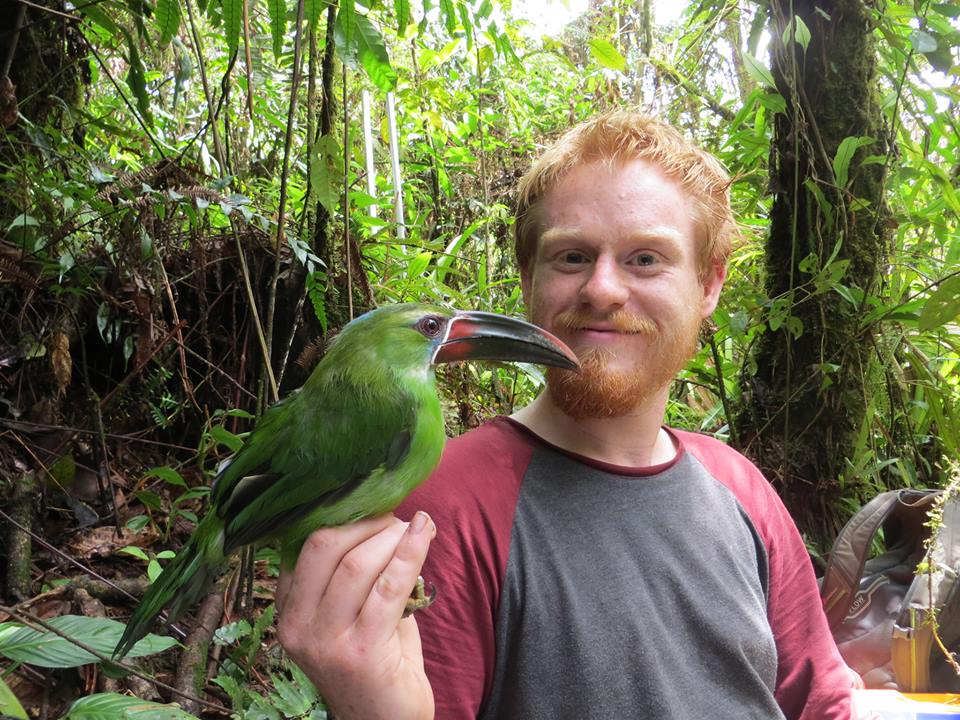
|
Jack Shutt (UK) 2013
jdshutt216(at)gmail(dot)com
The Manu Bird Project is an amazing and unique experience. As with any
project of this duration, difficulty and isolation, it throws up many
upsides and downsides. You are guaranteed to see many hundreds of truly
astonishing bird species and this never grows old and will keep you
enthralled from start to finish. This is not to mention the abundant
other forms of life you will encounter and all the while ‘working’ in
one of the most stunning landscapes on Earth – as a life-affirming
experience it really is second to none.
Having said this, living conditions are hard – your diet is poor,
logistics are difficult and some basic amenities completely lacking.
You can expect to be frustrated by aspects of the project and tensions
to flare occasionally when living so close to so few for so long. I
felt sometimes that the organization and communication was poor and new
training was negligible, although help is available on all these fronts
when truly needed. But just remember that all the bad times will fade
to nothing very quickly and you’ll soon wish you were back hurtling
down the road again, hanging onto the back of a truck for dear life –
proving how worthwhile this project and experience really is!
I was based at San Pedro for the 2013 field season. It is a fantastic
and genuinely stunning place with, in my opinion, the best birdlife
around and the added bonus of providing you with calves of steel by the
end! It gives you a great chance to experience a wide range of habitats
and species, with Villa Carmen and the lowlands or Wayqecha and the
highlands both within reach for your day off. The road around the camp
is also not to be missed, especially the Mirador, as this itself gives
an excellent gradient within easy reach.
As far as advice goes, I think the most important thing is to take a
freestanding, comfortably sized tent that works properly without guys
on a platform – this will make your life so much easier! Flip-flops are
essential to dry your feet out at the end of the day. Friaje’s at the
start of the season are actually cold, so bring more than one
jumper/fleece and a good blanket never goes amiss either. Good wellies
and waterproofs are very important too – you will be needing them! If
on the ringing team, you will catch some excellent stuff but it can be
slow-going at times so be prepared. Also, at San Pedro, I would
recommend starting with the furthest away and camping sites, as when
the rains hit properly from November rivers can become impassable,
paths more difficult and you’ll want to be closer to cover for when it
starts bucketing it down mid-way through your session!
Most of all though, make the most of it and enjoy, as I’m sure you will!!!
|
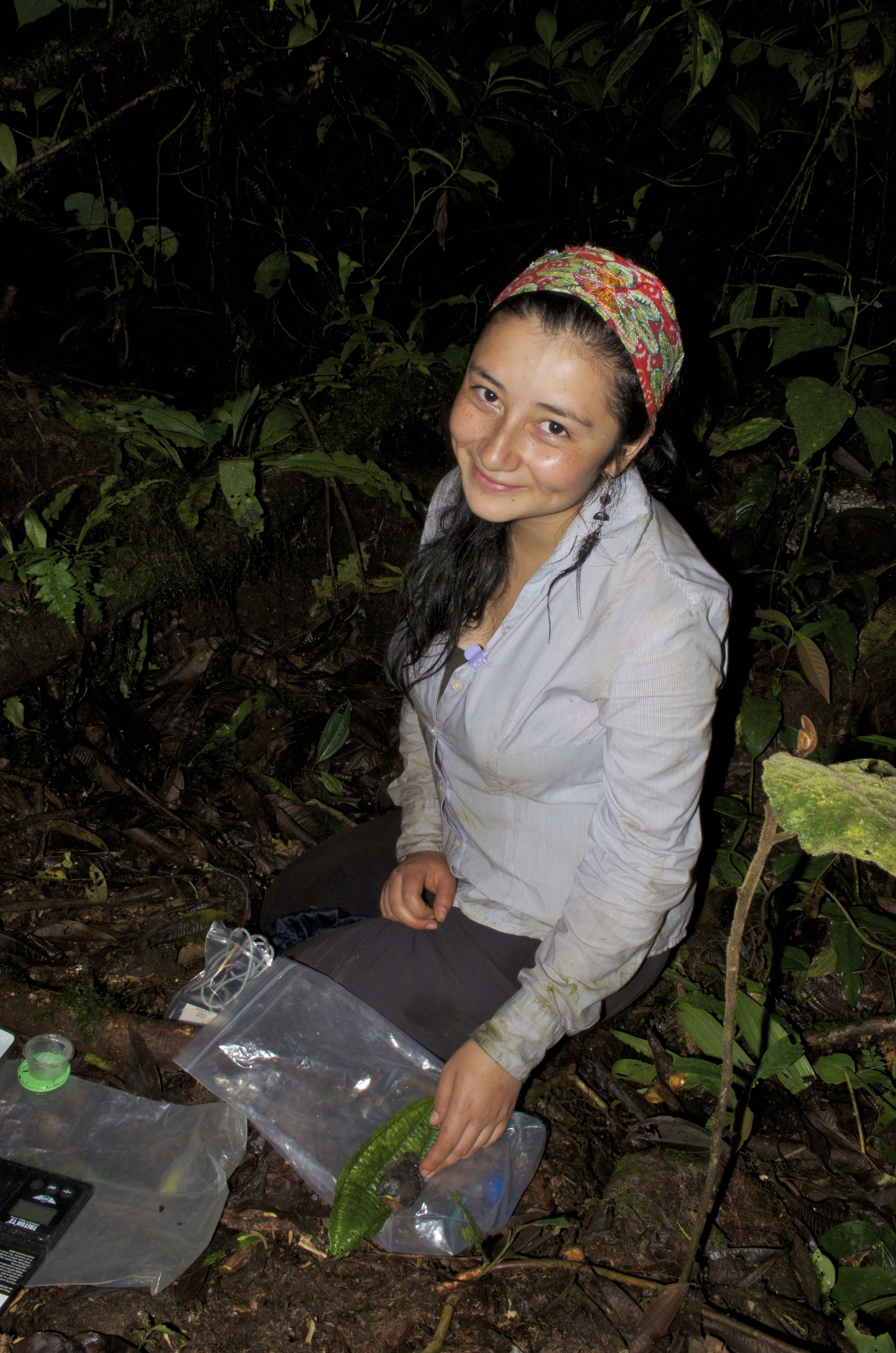
|
Juliana Soto Patiño (Colombia) 2013
julianita.nea(at)gmail(dot)com
Participar en el proyecto fue y será una de las experiencias más
impresionantes de mi vida. Es un aprendizaje constante en todos los
sentidos. Despertar cada mañana, escuchar los exuberantes sonidos de la
naturaleza, contemplar a cada paso la majestuosidad de la vida. Caminar
y sorprenderse con cada componente del paisaje, cada acción del mismo.
El proyecto es la oportunidad para formarse como biólogo, como
profesional pero sobretodo como persona, es la oportunidad de convivir
con personas hermosas compartiendo escenarios y momentos inigualables.
El proyecto marcó mi vida y pude apreciar la grandeza de la vida como
nunca antes y de aprender mucho sobre aves y el entorno en
general, a valorar cada cosa, persona y lugar en el mundo. Aprender
acerca de la biología reproductiva de aves, buscar nidos,
monitorearlos, medir polluelos, observar depredaciones, ver diferentes
comportamientos reproductivos, presenciar los procesos reproductivos de
las aves es algo maravilloso, trabajar con los experimentos
metabólicos, pasar la noche en vela, capturar las aves para los
experimentos y observar tanta variación y diversidad son cosas que
nunca se podrán olvidar de esta experiencia. Trabajar junto a Gustavo,
Jill y todo el equipo es muy gratificante, es sentirse en familia, con
la que aprendes pero también compartes felicidad, risas, historias y
por qué no tristezas. Gracias a Manu Bird Project por darme la
oportunidad de hacer parte de una temporada llena de aves, naturaleza,
paisajes indescriptibles, momentos inolvidables y personas únicas.
|
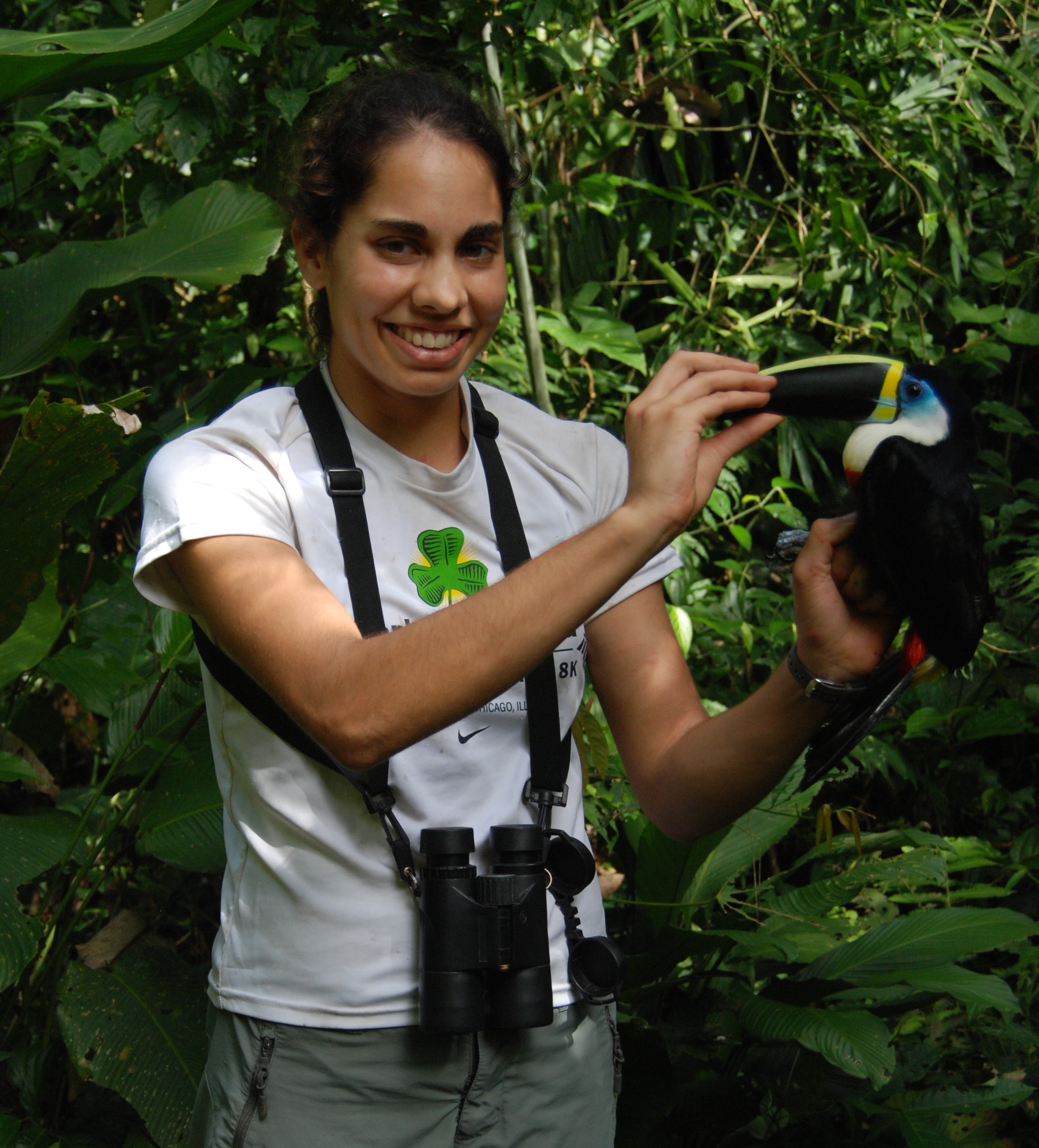
|
Sheela Turbek (USA) 2013
sheela(dot)turbek(at)gmail(dot)com
A few sentences cannot do justice to the incredible experience of
living in the lowland tropical rainforest for an extended period of
time. The biodiversity and natural beauty of Manu National Park was
unlike anything I had ever experienced. Although I walked the same
trails on a daily basis, hardly a day went by in which a mesmerizing
new species of bird, insect, or plant failed to catch my attention.
Mist netting days were long and occasionally monotonous, but these
downsides were more than outweighed by the impressive array of
fascinating and often vibrant birds that we had the opportunity to
examine in the hand. I highly recommend this experience for anyone with
an insatiable curiosity in the natural world and a strong interest in
the ecology and natural history of tropical birds. Pantiacolla has the
fewest amenities and is certainly the most remote station of the
project. However, nothing can compare to bathing in a river amid
capybaras as the sun dips below the horizon, washing dishes beneath a
sky full of shooting stars, and getting to know a diverse group of
fellow passionate biologists without the distractions of technological
devices. You will not regret temporarily forgoing modern comforts and
completely immersing yourself in the magical environment of the Amazon
rainforest!
Words of advice for those heading to Pantiacolla:
1. If possible, avoid bringing brand new field equipment, as few items will escape mold-free.
2. Pack any field guides you may want (there are very
few at the station) and plenty of books to read during the field
season. You will have quite a
bit of down time on slow mist netting days.
3. Take advantage of every available opportunity to
see as much wildlife as possible. Night hikes are almost always
rewarding!
|
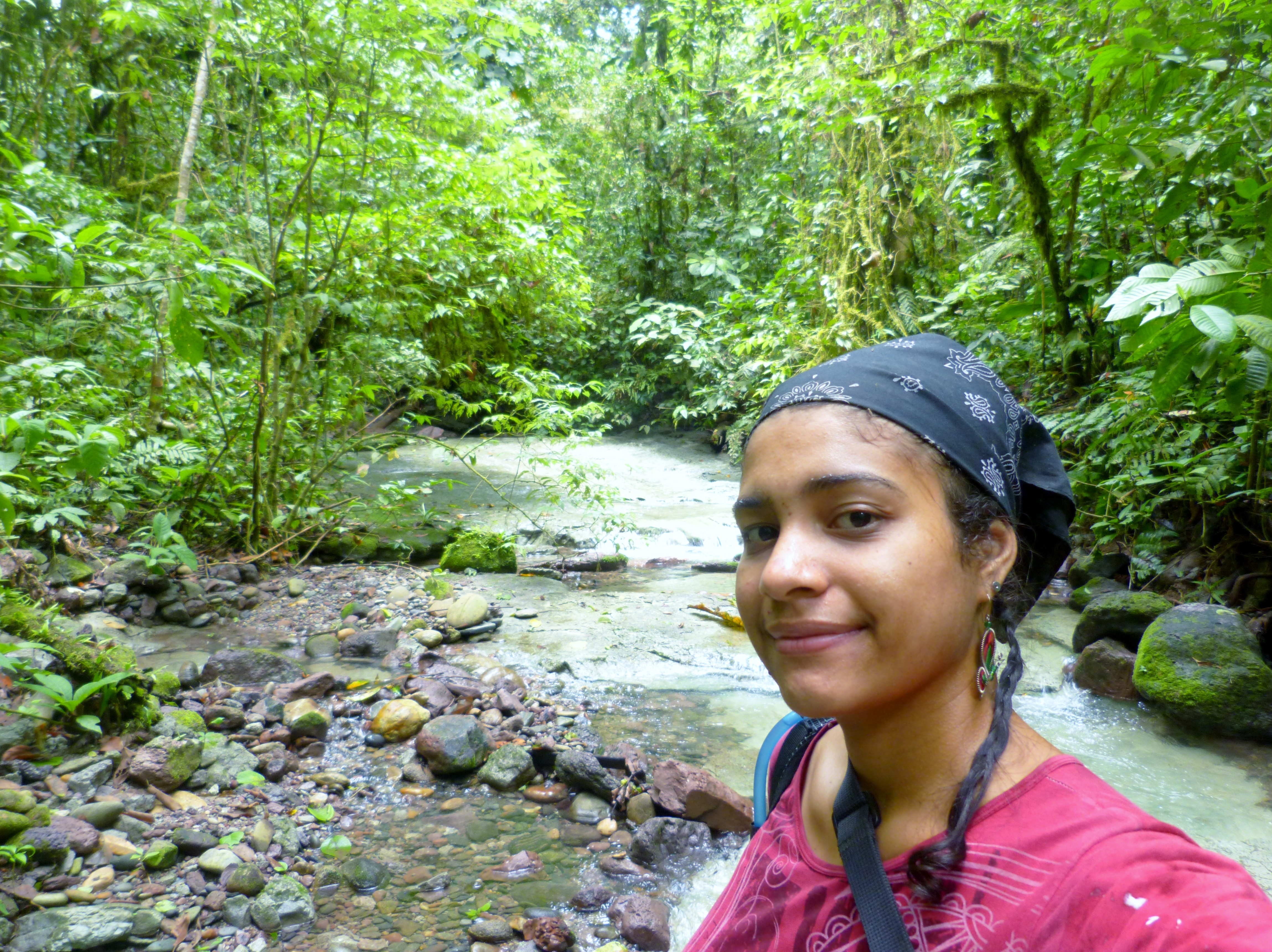
|
Wendy Valencia (Colombia) 2013
valenaturaa(at)gmail(dot)com
Vivir en una selva húmeda tropical, en un lugar con una diversidad tan
exorbitante como el Amazonas y particularmente en un sitio tan hermoso
como Pantiacolla ha sido la experiencia de mayor sensibilidad, sorpresa
y admiración constante por el mundo natural que he tenido. A pesar de
que continuamente vas a campo mientras estudias Biología y a veces por
largo tiempo, nunca se compara con la experiencia de vivir ahí, en la
selva, levantándote con los aullidos de los monos aulladores, y
acostándote al ritmo del canto de la rata del bambú después de un
mágico baño en el río desde el cual casi todos los días puedes ver la
vía láctea y estrellas fugaces. Nunca había experimentado la magia y la
complejidad de un ecosistema como la selva al nivel al que la vives
cuando todo el día estás caminando, observando, involucrado con el
lugar en el que buscas nidos. Un día te das cuenta de que ya no
te pierdes, otro que ya conoces todos los árboles grandes de la parcela
donde buscas, después, que ya sabes dónde están generalmente las
manadas de monos y posteriormente aprendes dónde estás porque escuchas
a la screeming pija cantar. De verdad te logras involucrar con el
ambiente y aprender biología en el mayor laboratorio, aprender de
primera mano, observando y sintiendo. Lo que se aprende experimentando
durante esos meses en la selva no lo puedes aprender nunca en un salón
de clase. Y no sólo acerca de historia natural, lo que aprendes sobre
ti mismo caminando todo el día solo y conviviendo con personas que
finalmente se terminan volviendo tus hermanos.
No sólo es una experiencia de trabajo sino que involucra todos los
aspectos de la vida, haces amigos con los que te ríes, molestas, juegas
fútbol, volleyball, bailas, cocinas, compartes y aprendes de culturas
diferentes. Aprendes a tener una disciplina de trabajo en campo y con
los datos muy importante si consideras que la biología de campo es tu
elección de vida. Y finalmente, los polluelos!!!!! Los polluelos! es
que parece magia, que un huevo con calor se vuelva polluelo, y después
crezca y le salgan plumas, y casi todo al parecer contra reloj antes de
que un depredador de lo coma. Si te gusta el campo, no te pierdas de
ver esto!
|
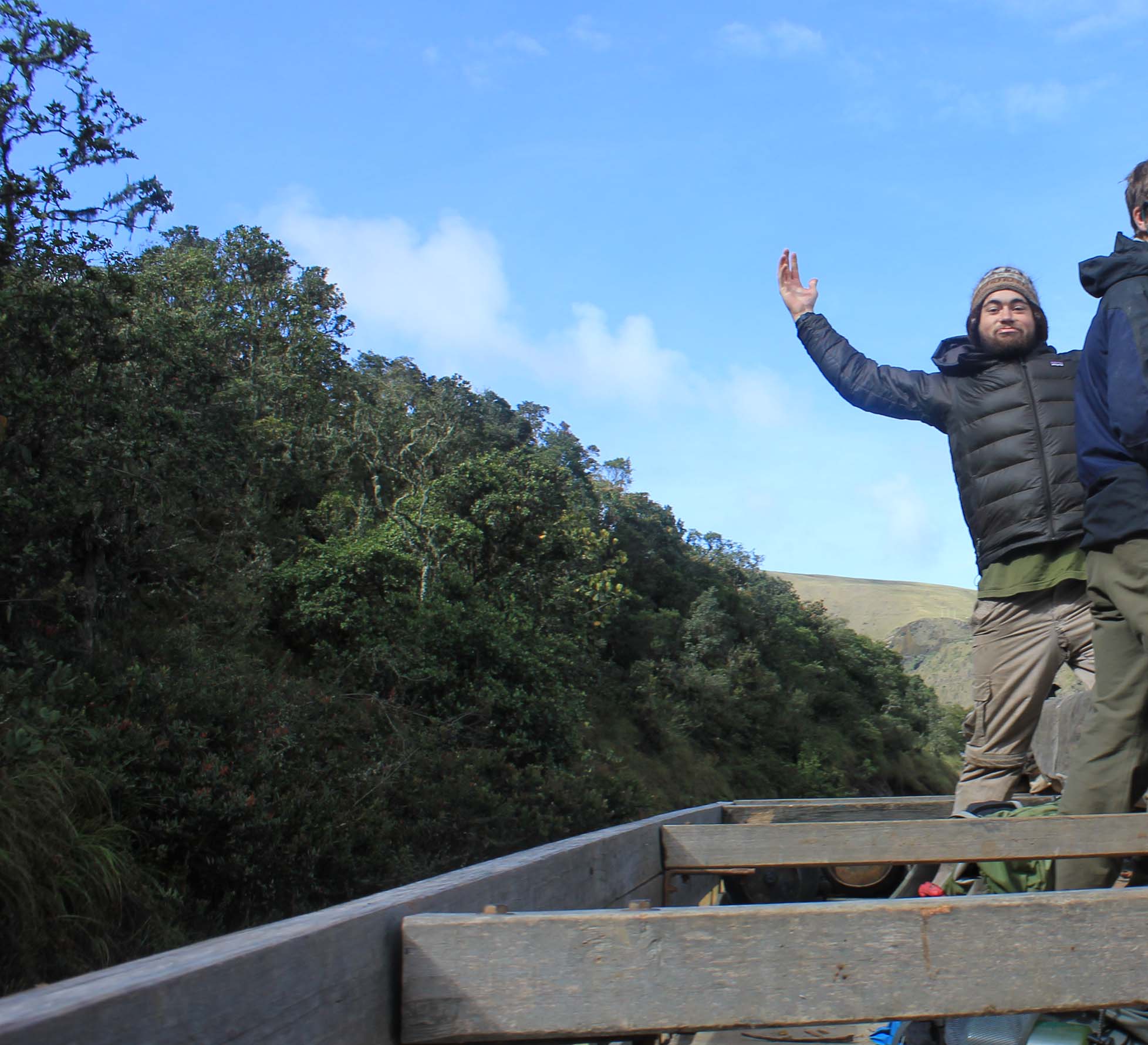
|
Ben Vernasco (USA) 2013
bjv4(at)humboldt(dot)edu
The Manu Bird Project was one of the most fun and challenging field
jobs out of the 8 field jobs that I have had. During my time, I was
stationed at the highest elevation site, Wayquecha biological station.
I was one of the two banders responsible for managing the 13 mist
netting stations and training my fellow coworkers how to band. Mist
netting at Wayquecha was a hit or a miss depending on the station and
the weather. Work consisted of very early mornings (0345 was the
earliest) and long days (nets were open from dawn to dusk). When the
nets were slow, there was lots of time in the day to read, look for
birds, or nest search (so bring some good books!). The views were
amazing and the biodiversity is extremely unique, we caught some really
amazing species. Don't expect too much privacy outside of your
tent! The bag I checked underneath the plane never made it to Cusco, so
I went the whole season with the clothes/gear I could find in Cusco
(If this happens to anyone email me for store names). One important part of having a good time is group cohesiveness and weekend
adventures! Puarcutambo is way better than Pilcopata for days off, stay
at the Tres Cruces Hostel in Puarcutambo. I highly recommend this
project for anyone that wants to work in Neotropical ornithology. Feel free to email me with questions. Things to bring:
sewing kit, zero degree sleeping bag, a good sleeping pad, cards, portable speakers, and an easy going personality.
|
 |
Wendy
Vidal (Colombia)
2012
Wendyvidalh(at)gmail(dot)com
Alguien
un día me dijo, la vida se encarga de ponerte en el lugar en el
que debes
estar, entonces estaba yo allí, en Wayquecha, en la
estación más alta de todas,
la más fría, despertándome muy temprano en la
mañana y alcanzando a admirar
como el sol empezaba a iluminar las montañas; y así
empezaba la mañana de
arduas caminatas, en el bosque, en la puna y en los ríos
pequeños… En
ocasiones, me perdí pero siempre encontré el camino de
regreso, además de
hermosos lugares en lo alto de las montañas. Es que esta
experiencia te enseña
en todos los campos, aprendes a tener un ritmo de trabajo, a afinar la
observación, a ser ágil en la toma de muestras, a manejar
metodologías
complejas e innovadoras, a vivir en condiciones de campo,
convivir con personas
de diferentes costumbres, diferentes idiomas, hasta el punto de
sentirlos
familia. También adquieres un poco más de paciencia,
hasta con los métodos, que
están en constante adaptación a las nuevas
circunstancias. Y bueno, Wayquecha
es una estación fría, así que debes
llevar buen abrigo, la comida
suele conservarse en buen estado debido a la temperatura, aunque debes
prepararte para una dieta poco variada... Por la altura las
enfermedades que
puedas adquirir son menores que en las estaciones bajas, puedes sufrir
del
estomago (lleva medicamento) o sentirte raro por el cambio de dieta.
Tenemos
acceso a internet en las noches luego de caminar 40 min a
la estación biológica, y bueno hay que cuidarse
la salud pues por lo
menos yo, no llevaba seguro médico. Para mí el proyecto
no fue una experiencia
netamente académica, más bien una experiencia de vida. |
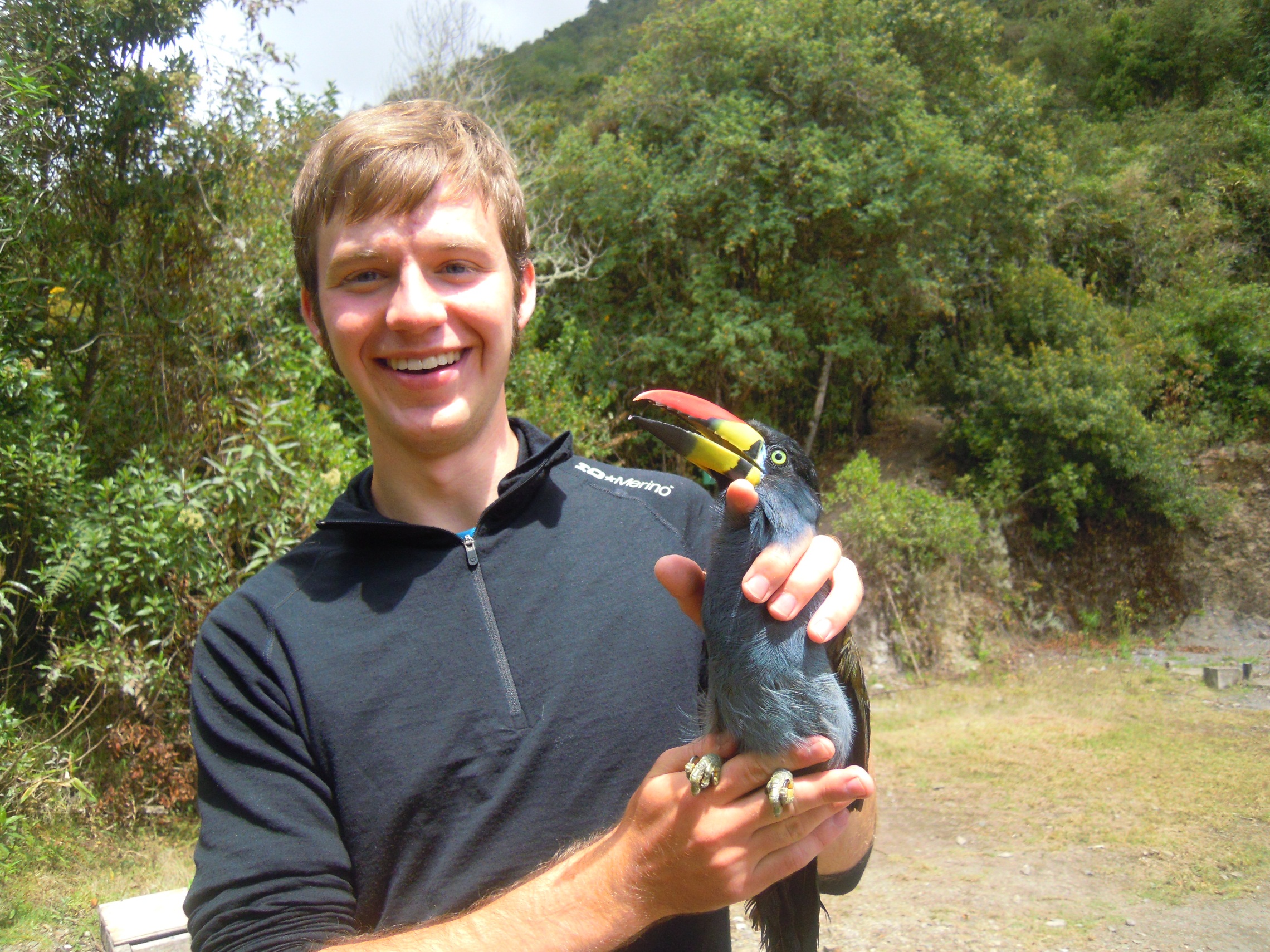 |
Harrison
Jones (USA) 2012
vireoviscount1(at)gmail(dot)com
Working
with the Manu Bird Project was an incredibly unique experience that was
at once
trying and rewarding. Any project which demands the volume and duration
of work
in as isolated and unique an environment as the eastern slopes of the
Andes is
bound to offer its fair share of frustrations as well as unforgettable
moments.
To be sure, the restricted diet, logistical difficulties, and lack of
some
basic ‘Western’ amenities, compounded by certain
organizational problems, at
times made for frustrations and frictions. Yet looking back on the five
month period
that I spent in Peru, it is inevitably the laughs, the magnificent
views, and
of course the opportunity to interact with and appreciate the immense
diversity
of Andean wildlife that comes to mind. In spite of, or perhaps because
of, the
difficult moments, the ability to live and work in such an untouched
habitat
for long enough to grow to appreciate its intricacies is all the more
rewarding. The banding work is certainly difficult, with long 12 to 14
hour
days, early mornings, and often quite a bit of hiking to get to the
nets, but
the diversity (not to mention colors) of the birds more than makes up
for it.
Jill and Gustavo were incredibly inspiring and kind people to work
alongside as
well.
I was assigned to the Wayqecha station in the high Andean cloud forest,
an
environment which is incredibly different from any of the lowland
forests at
the other field stations and deserves to be considered and appreciated
in its
own right. It is definitely an Andean, and not Amazonian, environment,
with a
temperature that ranges from a very comfortable ‘indian
summer’ of pleasantly
cool to (on very sunny days) hot during the day to cold temperatures at
night.
As such, the climate is anything but tropical, lacking the humidity and
mugginess of the lowlands and meaning that you’ll have an easier
time of hiking
up and down those mountainsides. While there is a rainy season from
late
November onwards, during most of the field season you will be treated
to light
misty rain and low clouds (fog) which blow up the valley in impressive
fashion
each afternoon. The habitat itself is extremely varied, ranging from
puna
grassland to stunted elfin forest, to full on cloud forest, which is
home to an
impressive array of tree ferns, orchids and other epiphytes,
hummingbirds,
tanagers, and flowerpiercers. Yes, the density of wildlife might not be
up to
Amazonian standards, but the birds are as colorful as anywhere else,
and always
unpredictable as to what you might run across. Oh, and the views are
better
than anywhere else in the Kosnipata valley...
For Wayqecha, I would recommend bringing a 3.5 to four season tent, a
sleeping
bag which is rated to at least freezing, and some good sunblock- at
3000 meters
you will burn in about fifteen minutes on a cloudless day. A good
knowledge of
Spanish will help a lot in terms of communication with the locals and
the
research group. My time in Peru with the project convinced me that I
want to
pursue ornithology as a career and opened my eyes to the amazing world
of
neotropical fieldwork. |
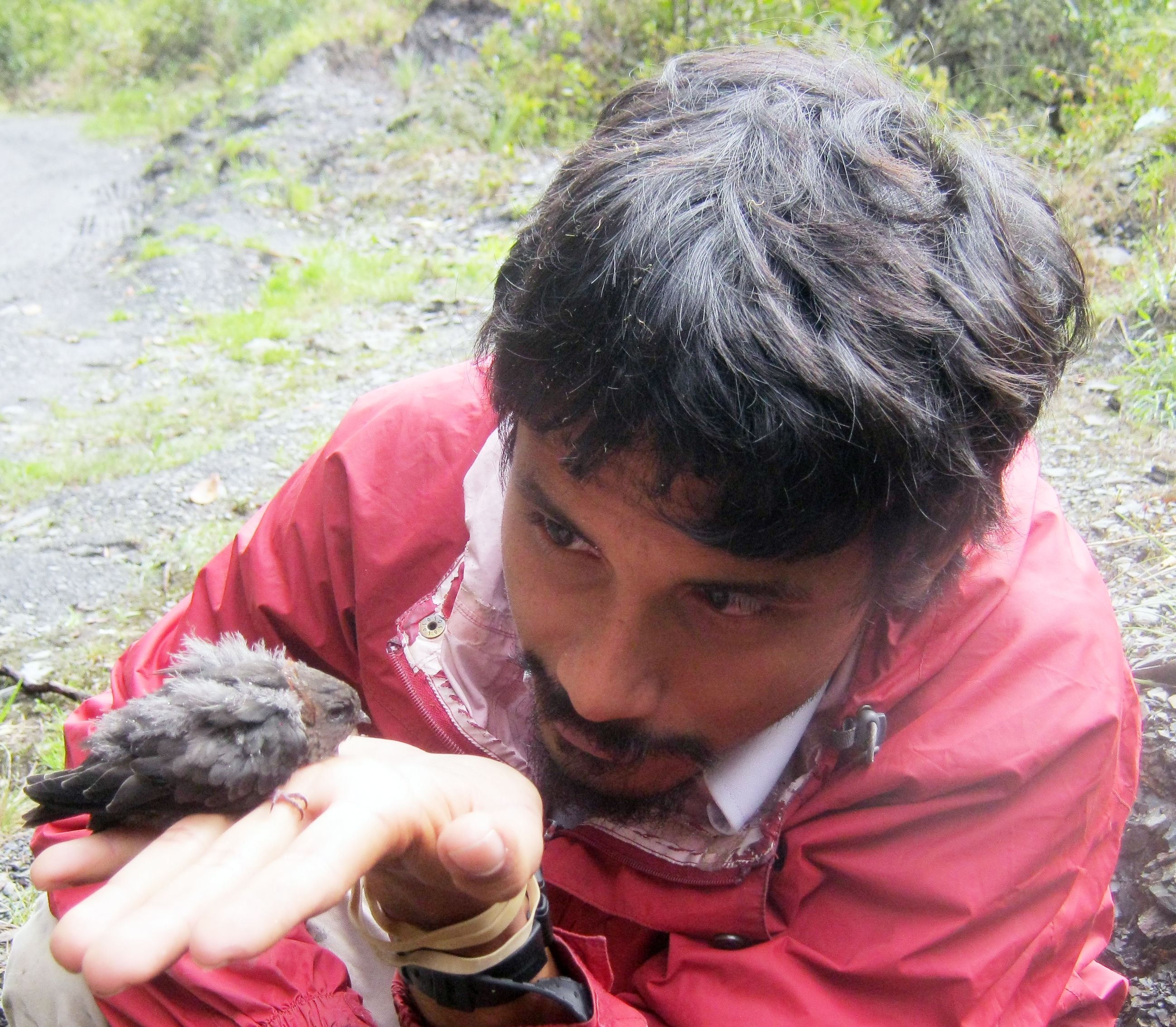
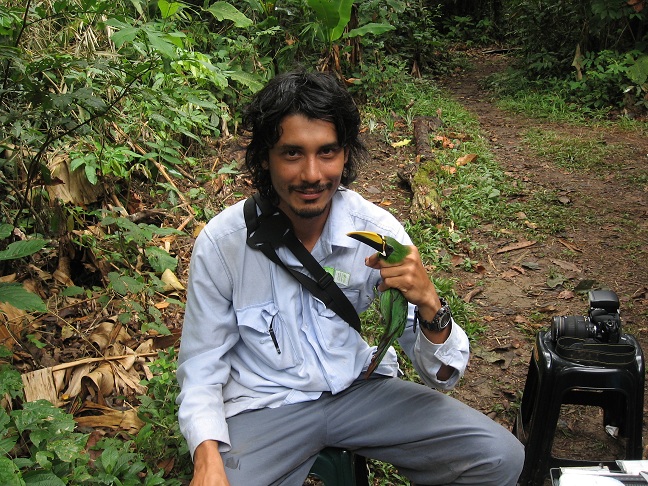
|
Diego
A Rinconguarin (Colombia)
2011, 2012
Diegoarincong(at)gmail(dot)com
2012: De
nuevo trabajando con Gustavo y Jill, mi segunda temporada en Manu
Bird
Project, esta vez regresé como encargado de Wayqecha, de las
tres
estaciones la más fría. En 2012 más familiarizado
con las metodologías y tareas
que se manejan en el proyecto como la búsqueda de nidos (a veces
frustrante),
redes, trasnochadas en tasas metabólicas, trabajo con los datos,
días de cocina
y logística, para que todo saliera bien. Estar a cargo te
dá tiempo para
conocer bien a tus compañeros, allí te encontrarás
con personas que son
excelentes trabajadores, personas que quieren aprender mucho, personas
que se
quejan de todo, los que no se quejan por nada, los buenos amigos y las
personas
desordenadas, entre otros, pero hay que tener en cuenta que todos
tenemos
diferentes personalidades y por eso recomiendo no amargarse, ser
tolerante,
tener paciencia y muchísimo interés por aprender. Hay
días en que estás agotado
y te quieres ir a dormir a las 6 de la tarde, también
tendrás momentos bonitos,
malos, preocupantes, emocionantes, tristes, de tensión,
días lluviosos, pero
hay que saber sortearlos y aprovecharlos, porque un componente muy
importante
(en la vida) es la buena convivencia y el buen ambiente de trabajo y
mas en el
campamento, que es tu casa y que estás viviendo con un grupo de
siete personas
que son tu familia durante cuatro meses o más. Debes interesarte
por los datos
que tomes y aprovecharlos, debes ser muy ordenado y observador y
así podrás
preguntarte el porqué de muchas cosas que allí veas.
Tienes la oportunidad de
visitar uno de los lugares con la más alta diversidad del mundo,
podrás ver
allí las tángaras de alta montaña que son
espectaculares; si caminas hacia
arriba un poco más, podrás ver muchos pájaros de
la Puna y si caminas hacia
abajo o por entre el monte cerca al campamento de Esperanza,
verás los pájaros
que se mezclan a menos de 2500 m. Es una buena oportunidad para conocer
personas de diferentes países, en este caso, a personas de
más de 10
nacionalidades dentro del proyecto, como de El Salvador, Brasil,
Estados
Unidos, México, Canadá, Perú, Ecuador,
Bélgica, Inglaterra, Sudáfrica, Francia,
China y más colombianos; sin olvidar a los conductores de
camión, de bus, guías
de turismo, turistas, mas voluntarios de otros proyectos,
lugareños,
profesores...... Otra cosa, las salidas a Pilcopata por mercado cada 15
días,
algo largas porque vas desde los 3000 m hasta los 500 m, pero puedes
ver las
montañas que nunca se terminan y como cambia el monte en el
gradiente y
siempre, cada viaje es más interesante que el
anterior. Finalmente, sería
buena idea llevar speakers para la música y seguir en 2013
invictos en fútbol,
ya que en 2012 siempre les ganamos al personal del lodge de Wayqecha.
Agradezco
a Gustavo y
a Jill por compartir sus conocimientos y por permitirme regresar. Para
más
información: aplica al proyecto, visita el Manu y estoy seguro
que querrás
volver!!
2011: Ayudar
con este proyecto ha sido sin duda alguna una
experiencia asombrosa, ya que muchas cosas allí fueron nuevas
para mí; desde
San Pedro, los viajes, los otros compañeros, los nidos, los
huevos, las aves,
la comida, las montañas, las lluvias, los ríos y miles de
cosas mas, son
imposibles de olvidar. Buscar nidos es un trabajo entretenido porque
recorriendo el bosque por entre matorrales, bambú, cruzando
ríos y quebradas
uno se da cuenta de todo lo que tiene al rededor y que la tranquilidad
que se
siente en medio del bosque es única. Además, para nadie
es sorpresa que el
trabajo de campo es difícil y se tienen incomodidades y que
todas las personas
somos diferentes, pero aun así en San Pedro las cosas fueron las
mejores
siempre. Finalmente, cuando la temporada esta por acabar uno ruega que
el
tiempo se pase muy lento, para disfrutar al máximo todo
allí. El Manu fué
sorprendente y espero algún día regresar para seguir
aprendiendo de todo,
gracias Gustavo y gracias amigos.
|
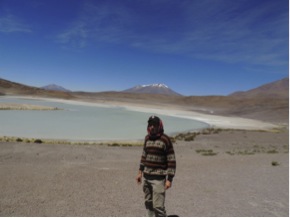 |
Juan
Diego (Colombia)
2012
lanero89(at)gmail(dot)com
Tener la
fortuna de estar en un país como Perú, y no solo
eso, sino llegar a uno de los lugares más increíbles del
mundo (la Amazonía),
lo hace crecer a uno como persona, no solo a nivel académico y
en experiencia
de campo sino como ser humano que debe tener un conocimiento
holístico de lo
que le rodea y más que eso mantener una relación
respetuosa con la
majestuosidad de la selva, que nos ofrece mucho pero a la vez se hace
frágil
ante la intervención humana.
El duro día a
día de caminatas y búsqueda de nidos tiene una
gran recompensa cuando se ve un ave salir de una cavidad o transportar
un gran
insecto en su pico, y más cuando tienes la fortuna de encontrar
tan elaboradas
estructuras y toda una historia detrás. Gracias a Gustavo y Jill
por hacer
posible esta gran experiencia.
|
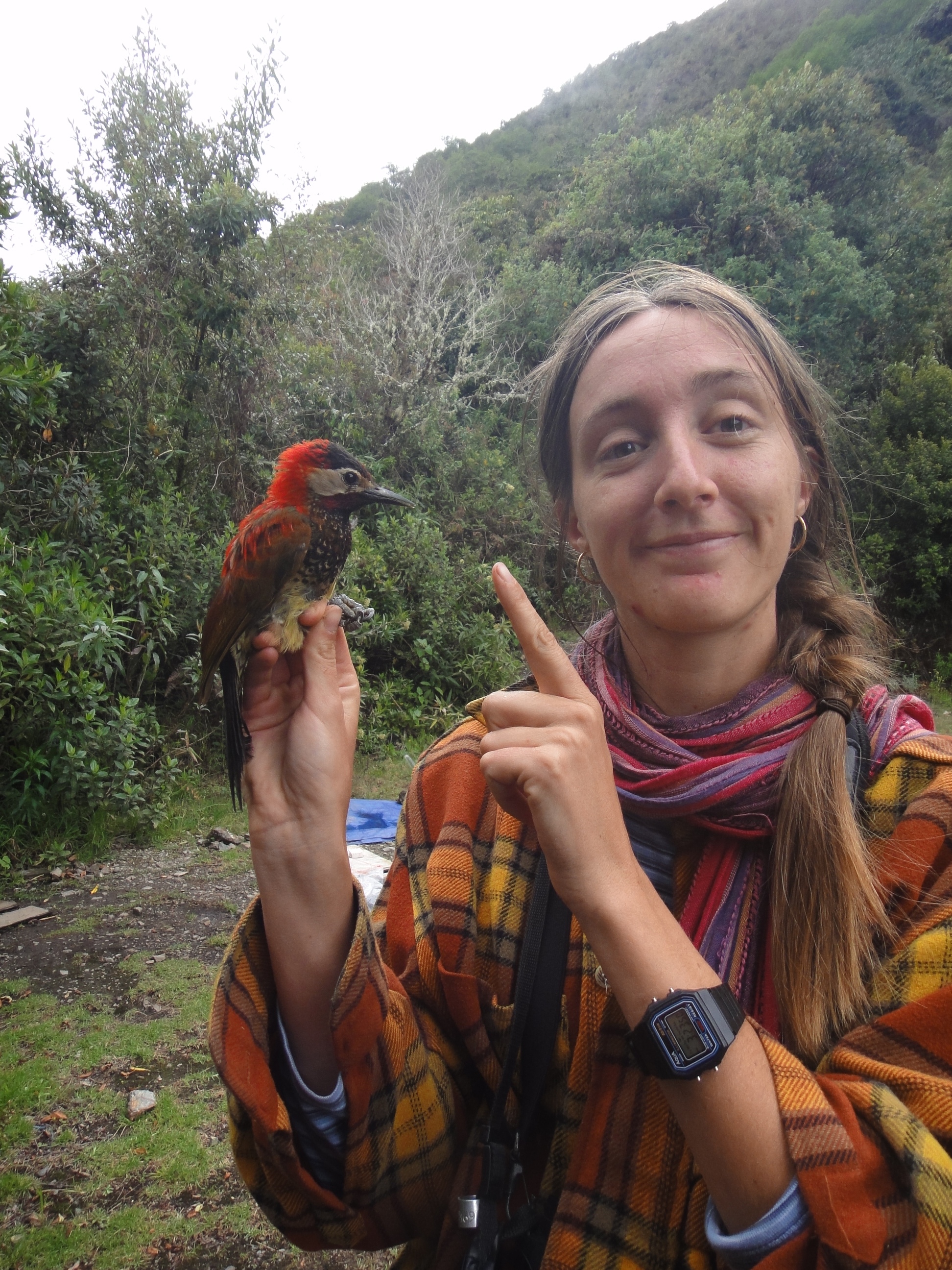 |
Catherine
Klein (France)
2012
4iklein(at)gmail(dot)com
Even if the
2012 field session was a bit disorganized
in Wayqecha, I really think Manu Bird project is a really good
opportunity for
those who want to study and discover rainforest birds. If you have a
problem
with changing protocols, don’t hesitate to say yes! The managers,
especially
Jill, are ready to help you and open for all suggestions. You will
learn to
live in a community, to cook with non-usual food for a lot of people,
to sit on
a potato bag during hours in a truck for traveling... And of course, a
lot of
fascinating things about birds and tropical forest.
I
worked in Wayqecha in 2012, it is a fantastic
station. You will not see as many birds compared to the other stations,
the
nests are difficult to find, the mist nets are often empty, you will
learn to
swim through spiny bushes, the cabana is not very comfortable... But I
really
dont regret my station choice, I'm totally in love with this amazing
landscape!
I already miss my little break, sitting in the grassland with a cookie,
looking
the valley going down to the Amazonian forest... If you like mountains
and cool
temperatures, go to Wayqecha!
|
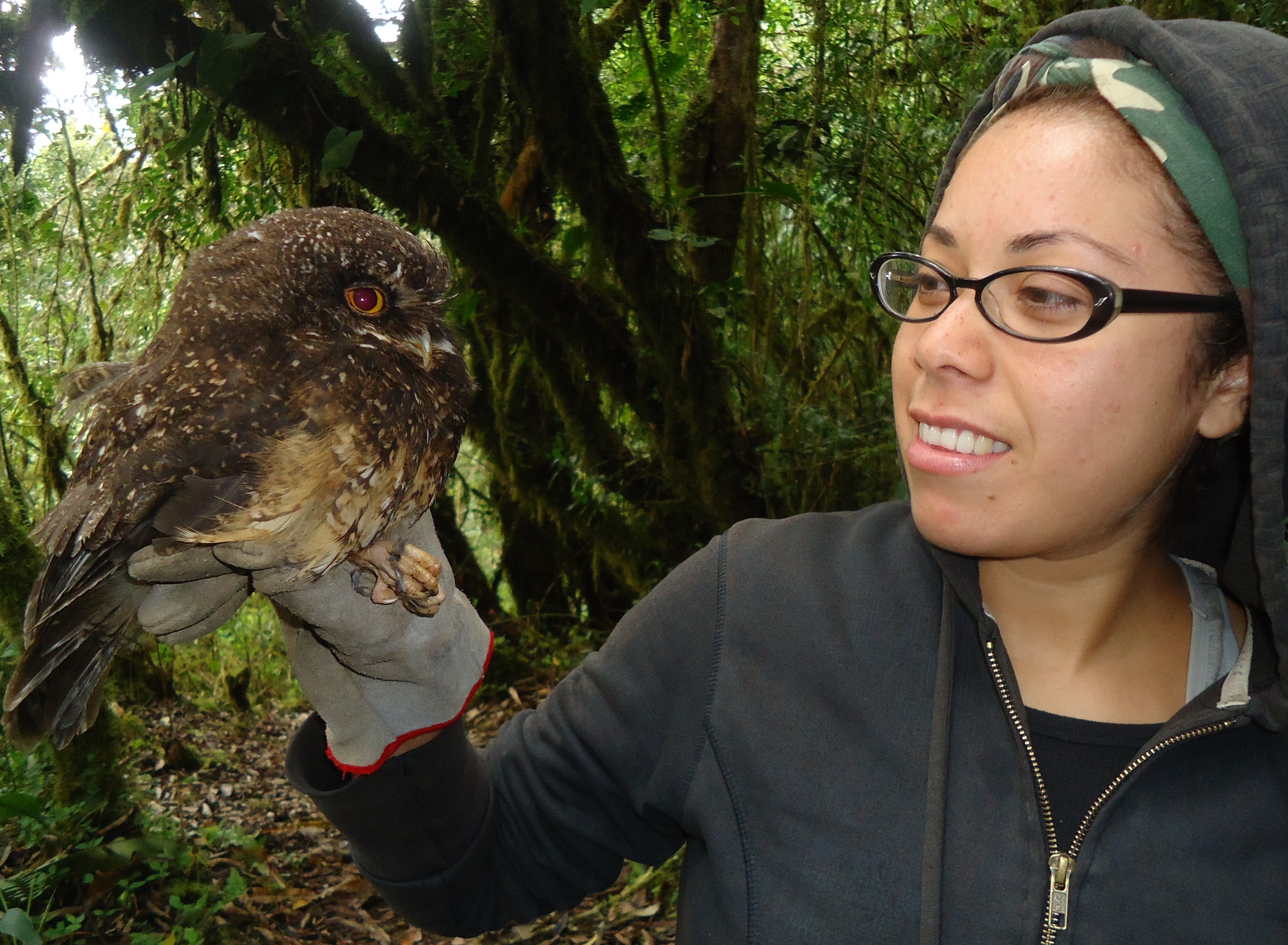 |
Johanna Barahona Rivera (USA)
2012
jyb3(at)humboldt(dot)edu
I spent
about 4 months volunteering at the Wayquecha station.
This experience turned out to be way more
than what I expected, I knew it was going to change my life but some of
the
hardships most definitely caught me by surprise. It
was both mentally and physically demanding
and challenging. It’s an experience that will help you grow in
personality,
knowledge, socially, and professionally. Here
goes some advice to volunteers in general:
-study the
Latin names of the birds found in your work station before you volunteer
-read some
of the scientific journals written by Gustavo, Jill and others of Manu
Bird
Project to familiarize yourself with the field work you will be aiding
-pack lots
of comfort foods, trail mix is cheaper in the USA
-focus on a
hobby such as birding, plant/insect identification, reading,
photography,
crafts, etc to get through the days
-pack a
wrist watch with alarm, water filter can come in handy, pack all
electronics in
waterproof bags
-pack
PeptoBismol, expect stomach discomforts, diarrhea, etc . If you can get
ahold
of Giardia antibiotics do it just in case you get it, I had Giardia for
most of
my stay in the volunteer and fully recovered once I left Wayquecha.
Health food
stores or herb stores sell organic herbal parasite cleansing pills.
Have fun,
enjoy the beauty of Peru. The birds are amazing, there is a lot to
learn from
the environment you will be surrounded by. It is a very special place.
You will
be working with a diverse group of people, be sensitive to others, it
is
essential that people try to get along and maintain an overall positive
level
of energy within the group to reduce work and living stress.
Advice
to volunteers in Wayquecha:
-pack
thermal wear, Wayquecha is COLD!!! One sleeping back was not enough for
some of
us, we had to put blankets inside our sleeping bags
-Although
the closest town to Wayquecha is
Paucartambo, there is not reliable transportation back and forth to
that town
in one day. On your day off expect an
8-10 hour roundtrip ride to Pilcopata, passing the San Pedro station.
In
Pilcopata you will buy groceries, use internet and telephone. |
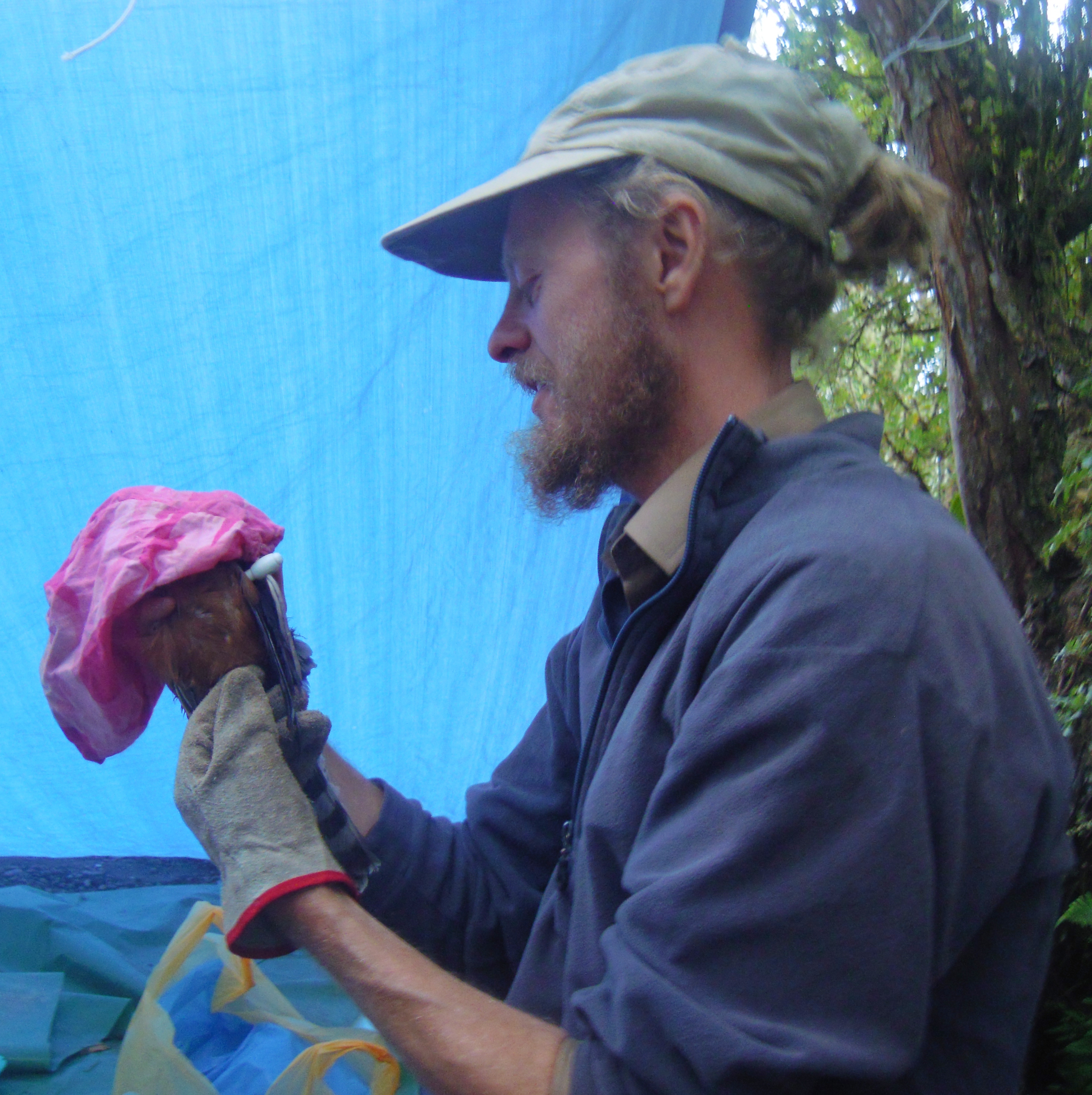 |
Nik
Aspey (UK)
2012
nik_aspey(at)hotmail(dot)com
If
you have worked in the tropics before but
never in the cloud forest, this is a fantastic opportunity to
appreciate it's
distinctive nature.
Above all
it is
NOT the tropical sweat-bath of the lowlands, it's more a weird
temperate
tropical mix with sunny Spring mornings, Summer days, Autumn late
afternoons
and early Winter nights. If you bring a little kit and clothing to
cover
these colder daily periods (Grade 2/3 sleeping bag with liners, a few
fleece
tops and bottoms and even a pair of gloves if you like) you will
be super comfortable and ready to ditch them quickly to enjoy the
dry
sunny heat of the average day. Another advantage of the climate is the
reduced
level of things that bite and mould your kit and sometimes yourself,
makes
fieldwork just that bit more comfortable.
The
tropical wildlife
may be at a reduced density to the lowlands but compared to
temperate
areas it's still plentiful, and being at the intersection of montane
forest,
elfin forest and high Puna grasslands the diversity of flora and fauna
is
pretty special. If you want to test your nest searching skills or learn
in the
most challenging of habitats then this place is certainly it, about as
extreme as you can get. The views are stunning with forest clad
valleys
rolling down to the lowlands below you and the grass clad Andean peaks
above.
It
is definitely a
once in a lifetime location to do fieldwork in and I was pretty happy
that I
did. |
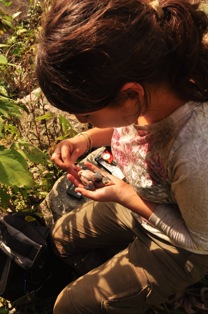 |
Jessica
Thompson (Mexico)
2012
upis_22(at)hotmail(dot)com
San
Pedro es un bosque de niebla hermoso, y aunque llueve todo el tiempo el
clima
es perfecto, este lugar esta lleno de cascadas, arroyos y riachuelos,
todo esta
cubierto de musgos y otras epifitas, es un lugar increíble para
buscar
nidos..., buscar nidos es la parte mas divertida y difícil del
asunto ¡la
mayoría están tan bien escondidos! salir a buscar nidos
es una de las mejores
experiencias que he tenido, encontrarlos, monitorearlos,
los nidos, los huevos, y ver como van
cambiando los
pollos día a día es muy interesante y bonito, aun cuando
no encuentres muchos
es muy padre ver lo que los demás están encontrando, es
motivante, encontrar
nidos es todo un reto.
Esta
experiencia fue positiva en muchos sentidos por que estas aprendiendo
todo el
tiempo, ya sea sobre aves, sobre sus hábitos, ecología,
comportamiento,
reproducción, distribución, alimentación …
pero no solo eso, sino que en
realidad aprendes de todo, aprendes sobre el bosque, aprendes a
cocinar, a
reparar, a cacharrear, aprendes de ti mismo, aprendes a ser
responsable,
aprendes de los demás, los chicos de San Pedro estaban muy
motivados y comprometidos
con su trabajo, hacían todo con muchas ganas y lo mejor posible,
además de que
fue muy divertido cambiaron mi manera de trabajar y también de
ver las cosas. |
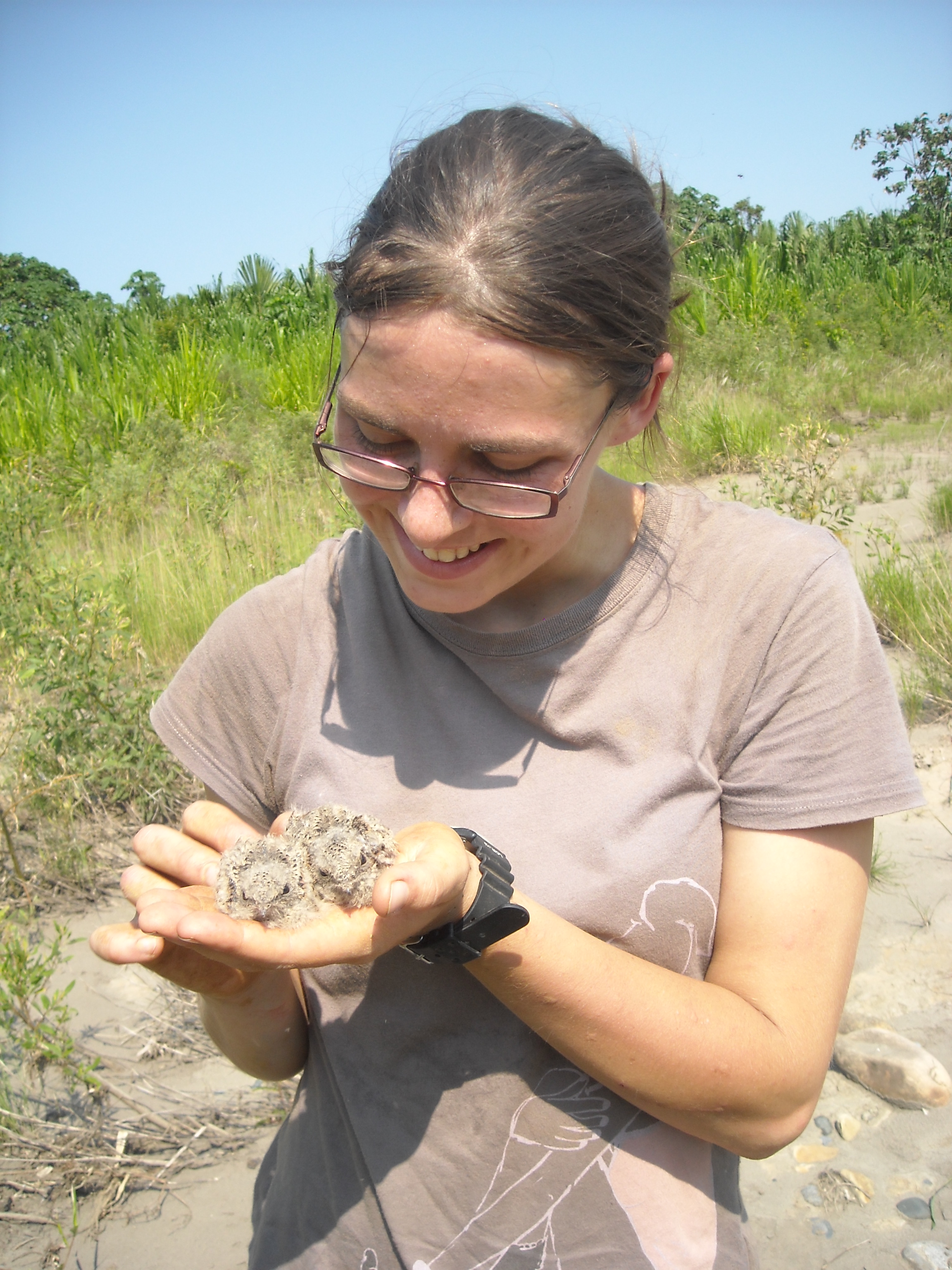 |
Kirstie
Hazelwood
(UK) 2012
Hazelwoodkj(at)googlemail(dot)com
Working in Pantiacolla was one of the most rewarding
experiences of working with wildlife I have had! The rainforest is an
endlessly
beautiful and interesting place and there are always new birds, plants
and
insects to see. This project gave me the unique opportunity to wander
into the
forest and spend all day looking at interesting things, and to bathe in
the
biggest bath I’ve ever used (the Manu river). I have also left
with some
unexpected and valuable skills and knowledge that I am still using now
and I
can’t stop telling people about the amazing birds and people I
was working
with.
There are of course
aspects to this lifestyle that can be
hard, living conditions are basic, contact with the rest of the world
is few
and far between, and the work can be difficult and tiring. Metabolic
experiments are invasive, lengthy and not very interesting, and until
you start
to find nests, nest searching can be frustrating, but as long as you
can
appreciate your surroundings as you go these things need not be a
problem.
I
would recommend that future assistants include a large amounts of
socks, a
Spanish dictionary, and if you think you’re into metabolics; some
hardcore
night-time entertainment! Be open minded and appreciate the diversity
of the
people you meet, and don’t hesitate to contact me with any
questions. |
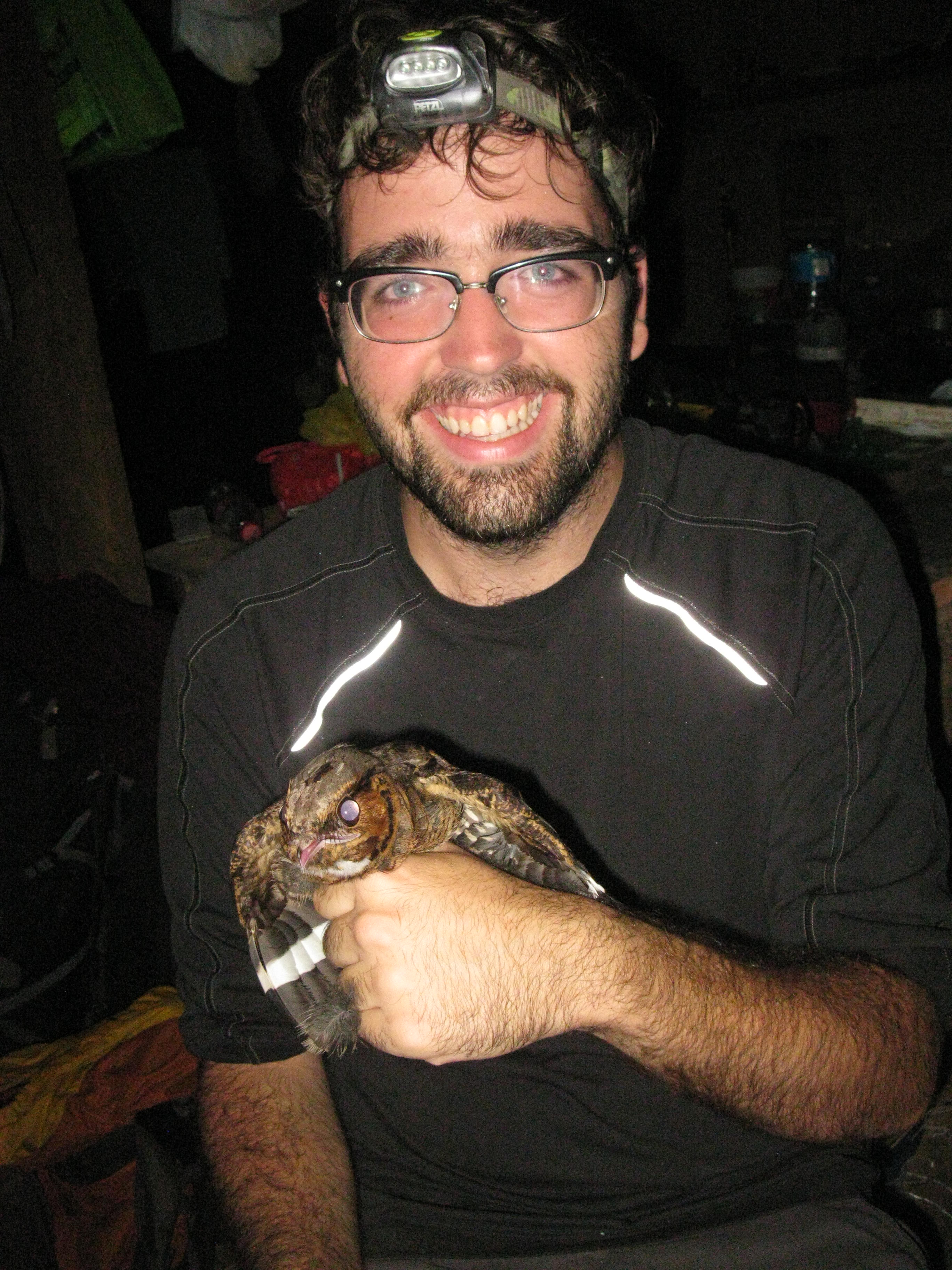 |
Paul
Preston (Canada)
2012
paul.preston(at)alumni(dot)ubc(dot)ca
I
worked at the Pantiacolla field station in the fall of 2012 and all I
can say
is that it was quite the experience. The biggest thing I would say to
prepare
yourself for working in the Amazon is that go in with no expectations
and your
mind will be blown, go in with expectations of what you will see and
what the
project will be like and you will be disappointed. The thing I had to
wrap my
head around while I was there was that Pantiacolla is so remote that it
really
is a different world. All the things we take for granted like food,
comfort and
communication are in short supply in Pantiacolla and in a way, I felt
very much
like I was a contestant on the show Survivor, but there was no million
dollar
prize, the prize was getting to experience something that very few
people will
ever get a chance to experience. The Amazon rainforest. I was on the
mist-netting team and it was amazing to be able to hold birds like
toucans,
hawks, manakins and euphonias in your hands. I had done bird banding
before but
it was nothing compared to this. The project was a lot of work and at
times it
was very difficult and stressful, but you have to remember that all the
organization of the project goes on from thousands of miles away and in
that
part of Peru, it’s very easy for things to get lost along the
way. Overall, I
had an amazing experience, the only thing I would like to have done
differently
was to come into the project not expecting anything. I came into it
thinking
there would be internet in the nearby town, that town would be easily
accessible, we’d have no problem with getting food and water and
that our basic
comforts would not be so infringed on, but in that respect I was wrong.
That’s
all part of the adventure. That’s what Pantiacolla was, an
endless source of
adventure, and you won’t regret it for a second.
|
 |
Katharine
Fielding (USA)
2012
Krfield(at)rams(dot)colostate(dot)edu
Working
for the project was challenging, but definitely worth it. By the
end, you
will be way more self- sufficient with cooking and laundry. The
station
leaders are awesome, and will help you learn all the basics of banding
and mist
netting, even if you have limited birding experience. Working in
such
isolated conditions can be difficult, but as long as you are willing to
be
adaptable and positive, you will have a great experience.
|
 |
Carolina Granthon
(Peru) 2012
c.granthon(at)tcu(dot)edu
El
proyecto en general es bien interesante y completo, hay muchas tareas
por hacer y abarca los gustos de diferentes personas. Participar en un
proyecto
como este no es nada fácil, hay poca comunicación con el
exterior, se vive en
condiciones difíciles, y se trabaja duro por 4 meses. Sin
embargo, es difícil
llamar lo que hacemos trabajo, ya que cada día es diferente e
increíble. La
emoción de encontrar un nido, o atrapar una especie nueva en las
redes, y hasta
sobrevivir a los experimentos de tazas metabólicas sin que se te
escape ningún
ave, es todo un logro. Yo estuve en San Pedro y es una gran
estación, con
muchísima diversidad de aves, grandes paisajes, aventuras,
lugares nuevos e
inexplorados, la verdad que es meterte al bosque de verdad; entre las
plantas y
lejos de las trochas. También tuve la suerte de trabajar con un
grupo de gente
increíble, conocer gente nueva, y hacer nuevos amigos.
Finalmente, trabajar con
Jill y Gustavo es genial, siempre dispuestos a responder tus preguntas
y
enseñarte algo nuevo cada vez que hablas con ellos,
además de ser tan buenos
amigos.
|
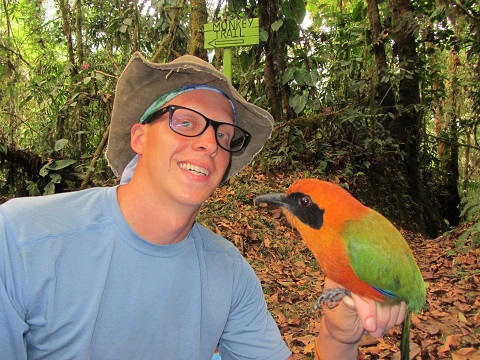 |
Clifton Avery (USA)
2012
cliftonkavery(at)gmail(dot)com
I worked in Peru from
September through
December 2012. The majority of this time I worked as a member of
the
mobile team. For the last month I split my time between San Pedro
and
Wayqecha nest searching. Working on the mobile team was an incredible
experience that gave me the opportunity to see many different
ecosystems within
Manu National Park. We worked at elevations ranging from nearly
12,000
feet down to1,000 feet. The mobile team primarily mist-netted
which was a
valuable learning opportunity for me to learn many aspects of mist
netting.
Due to all the different elevations we worked at, I held and saw
a large
range of the avian diversity of Manu National Park. However,
being a part
of the mobile team is not an easy task. One must be in good
physical
condition, be willing to camp in very remote locations for up to two
weeks at a
time, not mind the weather of the eastern Andes, be able to withstand
the bugs,
and simply like being outside in the rainforest all of the time!
The
experiences I had during those two and a half months with the mobile
team were
unforgettable and some of the best moments of my life. This work
experience has
only furthered my love, interest, and curiosity for working in the
field of
tropical ecology. I also spent a month nest searching which is a
difficult task
that requires patience and awareness of your surroundings at all times
while in
the field. It is a wonderful feeling when you do find a nest that is
active and
well disguised within the monstrous biomass of the Peruvian Cloud
Forest.
Overall
this was a life changing experience that a semester of college can
simply not
replace. My colleagues were all wonderful people and were from many
different
places around the world. Manu National Park is the largest and
most
pristine piece of rainforest I have been to. The flora and fauna are
dazzling.
Working with and beside Jill Jankowski was an extremely rewarding
experience. I hope to work with Jill and
this project in the near future. |
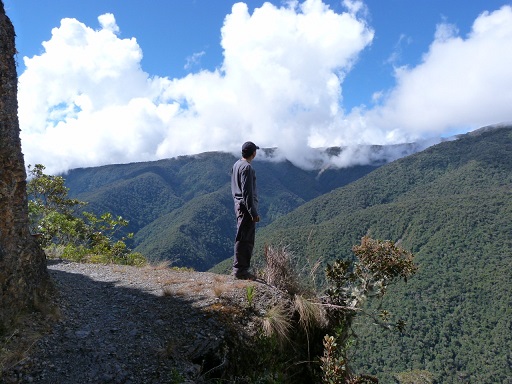 |
Jaime
Garizabal (Colombia) 2008, 2010, 2012
jgarizabal(at)gmail(dot)com
2008: Será
siempre
poco lo que yo diga; estar allí y
entonces fue una grandiosa experiencia de vida, desde innumerables
puntos de
vista. Como persona encontré un refugio interno que me
permitió conocerme
de maneras impredecibles, tuve mucho tiempo para estar solo
acompañado
de mi mismo, es algo único y muy enriquecedor. Como
estudiante y biólogo aprendí dos cosas
muy importantes, a trabajar solo y a
trabajar acompañado, aprendí a ser independiente y a la
vez ser parte de algo
más, a confiar en mi mismo y en el otro.
Además, aprendí labores
de campo de todo tipo, la experiencia es bastante completa, desde
montar
un campamento, reparar y preparar sensores y dataloggers, instalarlos
en campo,
luego analizar los datos, realizar experimentos con nidos, entre
muchas
otras cosas. Además, me familiaricé
bastante con la vida en la selva;
escuché, vi y tuve indicios de gran cantidad de
organismos vivos de
toda clase, dormí en carpa más de 100
noches, aprendí a
cocinar varias cosas y a valorar lo que otros cocinaban, supe
lo que
es lavar ropa en un río, bañarme allí mismo,
lavar la loza y recoger agua
para tomar y cocinar, pasé semanas enteras viendo tan
sólo tres o cuatro
rostros. Aprendí a ser aún más paciente,
pues me
tocó soportar muchos eventos que merecieron paciencia,
como nubes de
insectos, humedad, lluvia, soledad, en fin. Supe que si se
es atento,
se aprende mucho de si mismo, de la naturaleza, de los
compañeros y
de la vida, se da uno cuenta de que todo problema tiene solución
y que nada hay
tan majestuoso que el disfrute de la vida que se desnuda
ante uno
cuando se tiene la oportunidad de vivir una experiencia como estas.
Agradezco
inmensamente el haber estado allí, pues sin duda, fue una de
esas vivencias que
recordamos con cariño hasta el final de nuestros días y
que nunca terminan de
enseñarnos, al recapitular y recapitular. A quien le guste
trabajar fuerte sin
perder la conciencia, escuchar y ser escuchado, estar en contacto
directo con
la vida y la naturaleza, sin máscaras, tomarse la vida como
una lucha constante
pero divertida, aprender inmensamente, sentir y pensar cosas nuevas,
sin
importar el reto que supongan, seguramente ha de fascinarle, como a mi,
participar en un proyecto como el de Gustavo, quien además de
ser excelente en
lo que hace, es una maravillosa persona. Buscar nidos no es
difícil, lo difícil es
encontrarlos. Perseverancia, paciencia, método, control mental,
concentración e
incluso suerte, hacen la diferencia entre el que encuentra y
el que
no, cada día.
2010: En mi
segunda vez en el proyecto
de Gustavo me divertí mucho más que en la primera,
indudablemente, y no sólo
porque, como la primera vez, fue esta una experiencia reveladora, llena
de
momentos inolvidables, en lugares indescriptibles, sino porque
definitivamente
las personas que trabajan en él y la forma como se desenvuelve
el trabajo de
campo, te permite crecer mucho, no solo a nivel académico y
laboral, sino a
nivel personal. Yo siempre me sentiré un privilegiado por
participar en el
proyecto y para mi, sin duda, es una de las experiencias más
bonitas, completas
e importantes que he tenido en la vida. Estoy eternamente agradecido
con
Gustavo y los compañeros de proyecto, con cada momento, cada
lugar y cada cosa
que viví tanto en 2008 como en 2010
2012: Definitivamente el
Manu tiene algo mágico que hace que cada vez que regreses te
enamores más. Este año, mi tercero, tuve el placer de
visitar durante la temporada de verano a las tres estaciones del
proyecto, cada una espectacular a su modo. Como siempre, ser parte de
este proyecto representa una experiencia única donde las
palabras nunca alcanzan. Quizás por eso, cada vez que escribo
para esta sección soy más breve. Y es que la única
forma de entender lo que significa estar allá y entonces, es
vivirlo en carne y alma propia!! Solo elogios para este proyecto,
siempre! Me siento inmensamente afortunado por ser parte de esta
familia, donde se mezcla la ciencia, la amistad, la biología y
la vida misma!
|
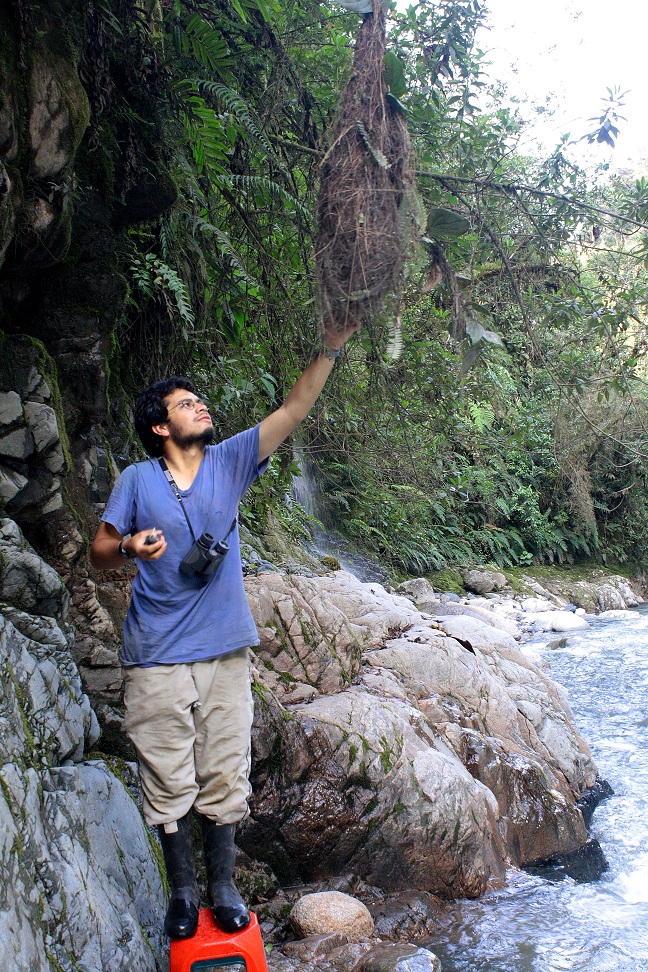 |
Andres Chinome (Colombia) 2010, 2011
andchinome(at)gmail(dot)com
2010: No
podría catalogar esta experiencia como un
paso
más
en mi vida, porque realmente fue un momento determinante y
trascendental tanto
en lo personal como en lo profesional. La exigencia del trabajo me
ayudo a
conocer más de mis habilidades y defectos, a abordar de manera
más positiva y
paciente las cosas que se demoran en llegar. A conocerme en diferentes
circunstancias. Aprender a confiar en personas que inicialmente eran
totalmente
desconocidos, reír, sufrir y celebrar con ellos hizo que San
Pedro tuviera el
ambiente más propicio para el aprendizaje, no solo de aspectos
personales sino
también en la Investigación Biológica. Encontrar
en Gustavo un maestro
dispuesto a compartir lo que sabe, hizo de la plataforma no solo una
familia
sino una constante Escuela. En lo académico, no solo se tiene la
oportunidad de
relacionarnos con rasgos morfológicos de una especie en
particular, sino de
aprender sobre características fisiológicas,
comportamentales, de la ecología e
Historia de vida. El ver dia a dia ejemplificado lo que
se
aprende de manera teórica, en los nidos a monitorear, en
inesperados pero
maravillosos encuentros con la fauna y flora Tropical, son
conocimientos que de
ninguna otra manera podrían ser asimilados con igual realismo.
Es
definitivamente un ejercicio que todo Biólogo
debería experimentar.
2011: Al igual que la
temporada 2010, el 2011 estuvo lleno de grandes enseñanzas
académicas y
personales. Es una excelente experiencia para las personas que quieran
aprender
y prepararse en la investigación de la Avifauna, desde el manejo
y
procesamiento de datos con redes de niebla Y Biología
Reproductiva, hasta
experimentos metabólicos. El aprendizaje es diario, proviene del
arduo trabajo
en campo y la interacción con los demás asistentes.
Gracias a las enseñanzas de
Gustavo, Jill y de los compañeros del proyecto 2011, mi
participación fue una
experiencia anecdótica. |

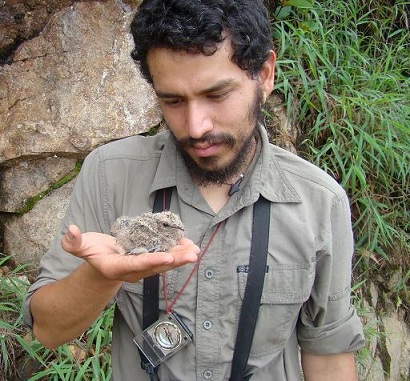
|
David
Ocampo Rincon (Colombia) 2008, 2009, 2011
algorab2(at)gmail(dot)com
2011: Tener la sensación de regresar a un hogar al
comenzar a descender
desde la Puna, pasando por los bosques densos de Wayqecha, atravesando
el valle
al lado del río Kcosñipata, para luego internarse donde
se pierde la montaña en
la Amazonía a las orillas de río Alto Madre de Dios, para
mi siempre será un
privilegio. El tercer año de participación en el proyecto
estuvo cargado de
cosas nuevas. Nuevas metodologías y dinámicas de trabajo,
y como siempre nuevas aves y amigos. Trabajar junto a Gustavo y a Jill en este
proyecto es una experiencia realmente enriquecedora, en la que he
tenido la
oportunidad de interactuar con muchas facetas de las vidas de las aves,
a
través de interesantes y complementarias metodologías.
Este año, mi función en
el proyecto me llevó a visitar constantemente las tres
estaciones en el
gradiente, trabajando con comunidades de aves muy diferentes pero
igualmente
apasionantes. ¿Cual estación? Difícil escoger,
como siempre, depende de
preferencias personales, pero seguro sin importar cual, se
tendrá un
experiencia llena de aventuras, amigos, aves, bichos de toda clase y
mucho
nuevo conocimiento, en uno de los Parques mas increíbles que se
puede visitar.
2009:
Llegar
a
conocer la biología de las aves de forma tan directa, pienso,
solo es posible
internándose un buen tiempo, en un buen sitio. Un sitio alejado
y conservado,
el tiempo suficiente para empezar a aprender no solo a ver las aves y
demás
organismos en él, sino a interpretar (a veces
acertadamente) las señales
que nos dan. Basta tener los sentidos sensibles para empezar a
reconocer esos
distintos sitios donde podría estar un nido. ¿De que tipo
de nido? copa,
domo..., los huevos ¿con que patrón de
coloración?, ¿y los pichones?, son
tantas las variaciones en formas, colores y comportamientos de
anidación, que
no es difícil interesarse profundamente en la biología
reproductiva de las aves
y seguirle el paso a la metodología del proyecto. Para
mí, eso fueron las dos
temporadas reproductivas que pase en el proyecto: una excelente
experiencia que
definió lo que quiero seguir haciendo, sumada a la oportunidad
de conocer gente
nueva, diferente e interesante en un increíble e inusual lugar.
2008:
La inmersión
de forma tan directa con lo
que estudiamos y más en un sitio como este, lleno de vida, que
permite
acercarse a especies conocidas, otras no tanto y otras que incluso
ignorábamos,
todas con fascinantes comportamientos y estrategias, es única
(brutal); y
si además tenemos en cuenta que se tiene la oportunidad de
trabajar, con
diferentes técnicas de campo, en un aspecto tan decisivo en
la historia de
vida de cualquier especie como es la reproducción, no cabe duda
que participar
de este proyecto es una gran oportunidad. Buscar nidos no
es fácil, y compartir con
gente de tan diferentes mundos puede ser en ocasiones difícil,
pero de igual
forma es un reto, un aprendizaje diario, ya sea académica,
social, cultural
o interior. Una experiencia llena de aventura, amigos y
conocimiento.
|
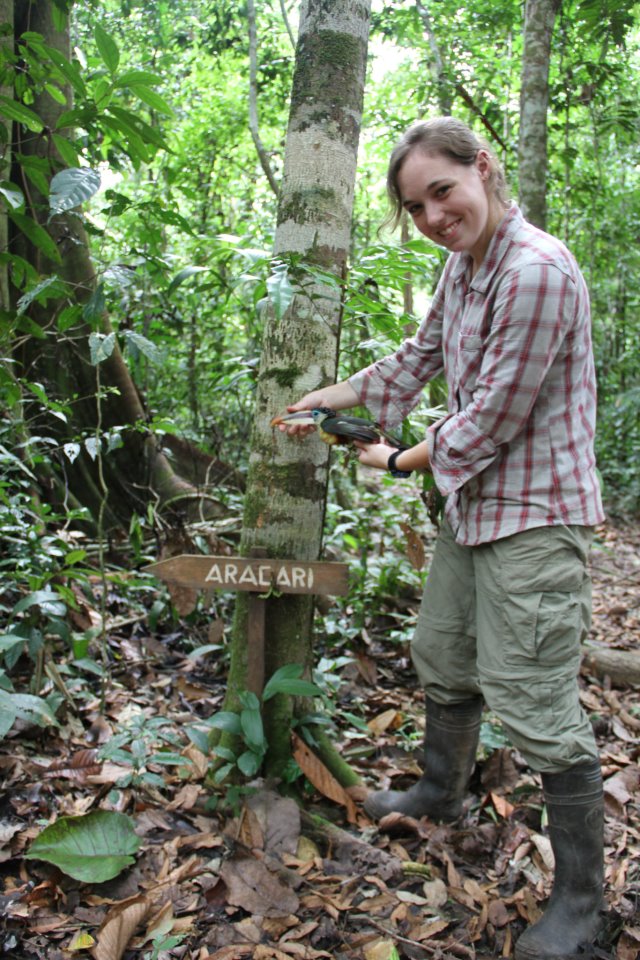
|
Jennifer
Bailey (USA)
2011
jenn.bailey9595(at)gmail(dot)com
Working
in Peru
with Gustavo was perhaps
one of the most challenging and rewarding field experiences I have had
thus
far. As you will read from the other field assistants, there is
nothing
quite like the frustration you will feel after spending a 10 hour (or
more) day
out in the field searching for nests and finding absolutely
nothing. In
the beginning of the field season, this can be very discouraging.
However, if you keep walking and enjoying the forest around you while
staying
alert, you will find them. I will never forget the excitement I
felt each
time I came upon a new nest.
Gustavo's project provides an incredible opportunity to mix an amazing
group of
people with a beautiful ecosystem and very cool research. It will
not be
easy. Living conditions are very basic, the work is both
physically and
mentally challenging, and at least at the Pantiacolla field station,
you will
have very little if any contact with home. If you are up to the
challenge
though, you will not regret it. I came into the project with
absolutely
no avian experience. The amount that I learned both about the
birds
themselves and the neotropical zone is truly unbelievable and has led
to great
future job opportunities.
For future field assistants, I would highly recommend that you bring
more socks
than you could possibly imagine, large amounts of anti-itch cream,
several good
books, an open mind, and a sense of adventure. You will get to
see things
and places that most people can't even dream about. Enjoy and
please feel
free to email me if you have any questions. |
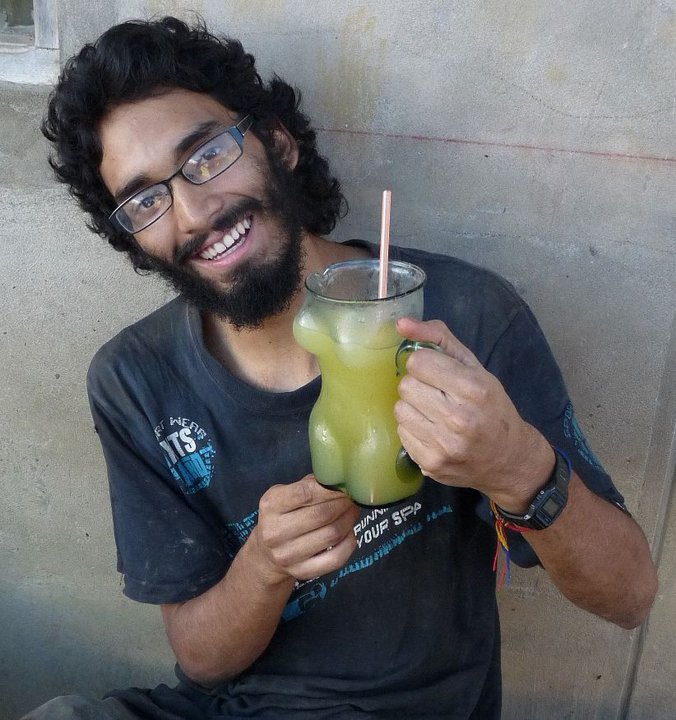 |
Santiago
David Rivera
(Colombia) 2008, 2009, 2011
sdrrock(at)gmail(dot)com
La mejor experiencia de campo en el Neotrópico!
2011: Si
usted está
interesado en la historia natural de las aves Neotropicales, si usted
pretende
continuar un programa graduado con investigación en campo, si
usted desea
aprender del mundo natural en uno de los lugares más diversos
del planeta, si
usted es capaz de vivir en condiciones totalmente diferentes a las que
está
acostumbrado, si le interesa la ecología, comportamiento,
evolución y
fisiología, si usted es ordenado, curioso, entusiasta, trabaja
en equipo y
tienes paciencia, interés y ganas de aprender… entonces definitivamente tiene que considerar participar de
este
impresionante proyecto! No es
sólo
buscar y encontrar nidos, es ser persistente y curioso en campo, es ser
ordenado con los datos, es ayudar a mantener un buen ambiente con su
equipo de
trabajo, es levantarse y disfrutar la experiencia, es aprovechar cada
segundo
de cada día. En 2011 participe por tercera vez del proyecto con
Gustavo y puedo
simplemente resumirlo como la mejor experiencia de campo en el
Neotrópico para
un biólogo en formación.
2009: Como
si la
primera vez no hubiera sido perfecta, agradezco la oportunidad de vivir
una
segunda. Este fue un segundo año lleno de nuevas aves,
nidos, amigos y
buenas experiencias, de nuevo Tono es uno de los hogares en que
más he
disfrutado vivir y unos de esos lugares a los que siempre esperare
volver. Un proyecto lleno de satisfacciones, desde el encontrar
los nidos
hasta el colocar sensores. Hacer parte de esto, el proyecto de nidos en
Manu,
es sin duda la mejor experiencia de campo de mi
vida!!! |
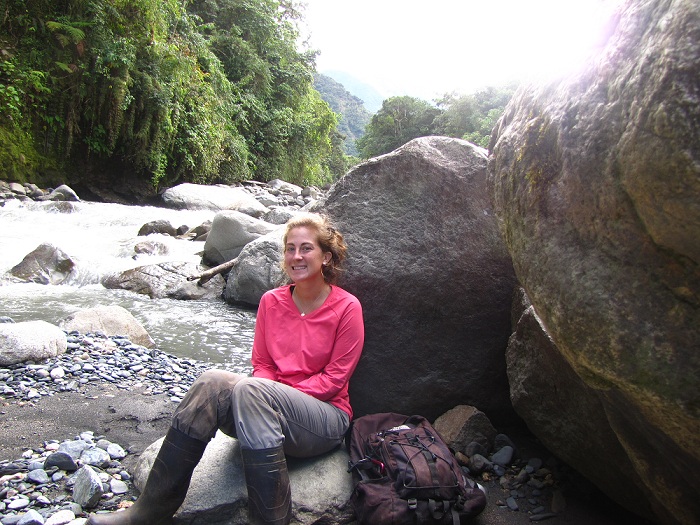 |
Rachel
Grey (USA)
2011
rachel.grey4(at)gmail(dot)com
While
working for Gustavo I
absolutely fell in love with Peru.
It is a beautiful country
and living in San Pedro was amazing. The forest is beautiful and full
of crazy
insects, huge trees, beautiful flowers and scenery that I'll probably
never see
again. The work itself is frustrating but very rewarding. It's
basically like a
scavenger hunt all day every day, and I definitely found more old nests
than
active nests. That being said the mist netting is also a great aspect
of the
job. Holding birds like the Cock of the Rock, Rocket-Tailed
Hummingbirds,
Motmots, Tanagers, and everything in between was awesome. I never
thought I'd
be holding a hummingbird that was as big as my thumb. The birds that
you get to
work with really are amazing. I feel like I learned so much about
different
types of sampling and bird handling techniques. Day to day life at the
platform
was super rewarding; and you definitely learn to not mind the little
things. I
definitely had to get more creative with my cooking, and getting used
to doing
laundry by hand took a little getting used to. I used waaaay less
clothes per
week by the end of the season. Another great part of the job was
getting to
know people from all over the states, Peru,
Colombia
and Canada.
I still keep in touch
with many of them. My Spanish was way better by December. Finally
working for
Gustavo was great; I couldn't have asked for a better boss. He was
always
cheerful, energetic, positive, and handled everything very well. He
gives great
advice regarding graduate school and everything else. He's very patient
and
understanding and a great leader. I really enjoyed working for him, as
well as
my time in Peru.
|
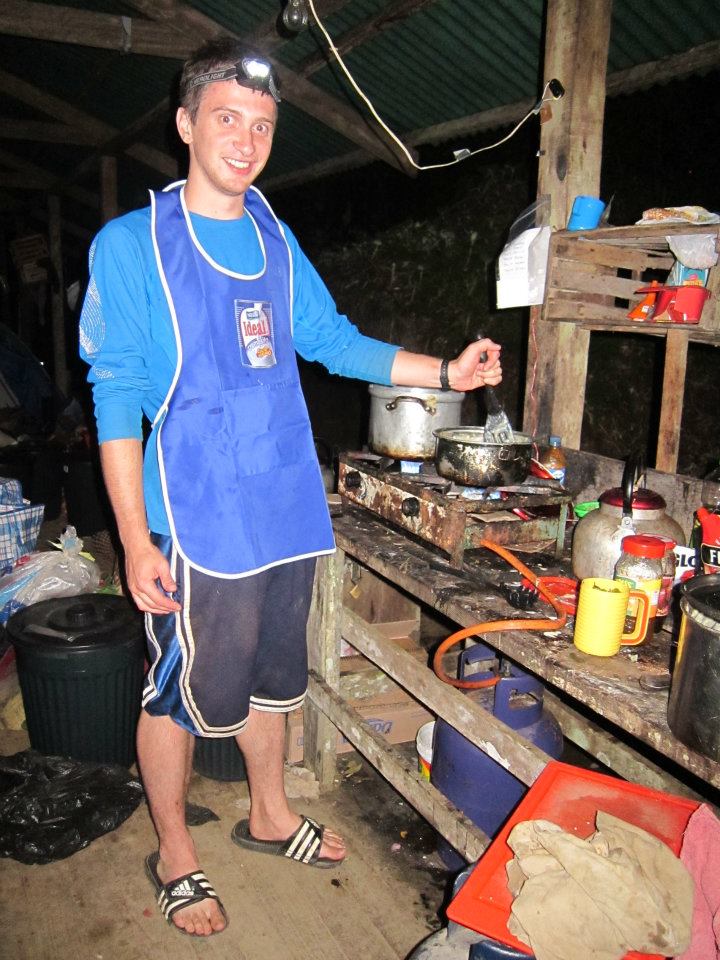 |
Tim Forrester
(USA) 2011
forrestertr(at)gmail(dot)com
I spent one month at San Pedro and three months at
Wayqecha. The diversity between these stations is astounding, I only
counted 7 species of birds seen at both of these stations. The forest
at San Pedro is spectacular and the rivers are very fun to explore. The
monkeys, snakes, frogs, and birds are all very entertaining. Wayqecha
is almost completely different. It is much colder but usually a very
comfortable temperature during the day. Nest searching up and down the
steep hills will turn you into a mountain goat, and playing soccer at
3000m will get you in shape. Spending a lot of time at this station,
there are many rare species of birds that you will get to see that most
tourists miss. As others have said, it is undeniably frustrating
spending many hours a day searching for nests and not finding anything.
And when you do find a nest, you need to exercise even more
patience, so as to safely take measurements so the bird does not
abandon the nest. But there are very few things more satisfying than
finding a beautiful hidden nest and collecting data that maybe no one
else in the world has collected before. Mist-netting here is also a
thrill, as you never know what you may catch. Be prepared to lose
weight, as the constant walking and fairly regulated diet make it
inevitable. This job is perfect for people who love birds, love
being outdoors, and most importantly, have a lot of patience. This job
is also great for biologists looking to see if they want to pursue more
work in the tropics, as you will meet many experts in tropical
ornithology. Gustavo is also an amazing and truly unique person to work
with. There are very few people in the world who have such a deep well
of knowledge about tropical avian ecology, and it is truly a adventure
to work with him. I have no doubt that the experience of this job was a
great help in myself getting accepted to graduate school. I hope to
work on this project again at Pantiacolla in a few years. |
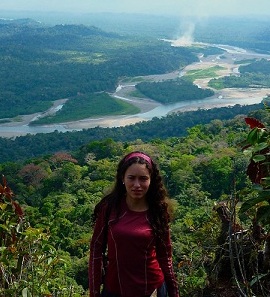 |
Jenny Muñoz (Colombia) 2011
juanita027(at)gmail(dot)com
La
mayoría de las personas no van a la selva porque suponen que
extrañaran miles
de cosas, en mi caso la selva me dio cada día algo de que
enamorarme y por
supuesto algo que extrañar el resto de mi vida. Manu es ese
increíble sitio en
donde puedes despertarte en la mañana con el canto de una
hermosa ave tropical
que se ha perchado sobre tu carpa, o tras el llamado de un amigo que
encontró
una impresionante serpiente. Manu es
caminar a donde te lleven los pies pero tambien tu pasión y tu
curiosidad, el
Proyecto Manu no es solo buscar nidos o capturar aves es enamorarte de
la historia
natural de las aves, de su ecología, su comportamiento, su
fisiología. Nunca
olvidare esa estremecedora sensación al encontrar el primer nido
o al tener un
pequeno colibrí en torpor entre mis manos
y luego gastar horas en decenas de
preguntas que nos surgian cada día.
Este
proyecto fue un reto para aprender sobre ecología y
fisiología, pero sobretodo
para disfrutar la experiencia de vivir
bajo condiciones exigentes en una selva tropical y aprender de un
diverso
equipo de trabajo en donde encontré maravillosos amigos. No todo
es fácil, pero
lo unico que usted necesita para estar bien en este paraiso es
paciencia y
buena actitud. Esta temporada en Manu es
la primera de muchas que quiero pasar.
Gracias
a Jill y Gustavo por ser unos investigadores magníficos y unos
amigos
preciosos.
|
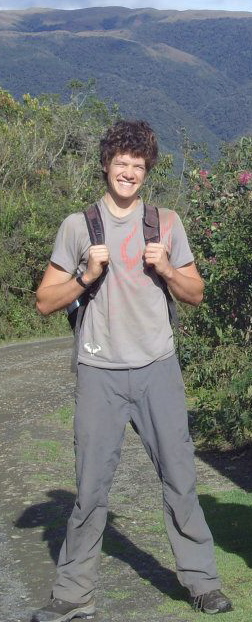 |
Callum Kingwell
(Canada) 2011
callumkingwell(at)gmail(dot)com
Prospecting
for birds nests in fairly remote areas of Peru may seem like an odd
task to
devote oneself to for 5 months, but I personally can't recommend it
highly
enough. At the outset you will be
assigned a large patch of forest where you will spend almost half of
every day (i.e.
10-12 hours), 6 days a week for the duration of the field season
searching for
birds nests on your own. (This cycle is
broken, however, by bouts of mist-netting and metabolic rate
measurements). Consequently, you will
appreciate the natural
history of your patch to an extent that nobody living life at a normal
tempo
really could; which, If you're into that
kind of stuff, is pretty neat. At the
same time, you are contributing to a data set which is being used to
answer
interesting and important ecological questions which are listed
elsewhere on
this site. The realities of life in the
field: 1) the food may be different both
in nature and occasionally in quantity from what you are used to at
home (this
mostly goes out to fellow North American omnivores), 2) you will suffer
the
minor discomforts of living in a tent for months at a time, and 3) as
previously mentioned you will find yourself spending a lot of time
alone. If these conditions sound
unbearable to you,
you are probably wrong and you should come for the job in order to test
your
physical and mental character. If you
feel that you are comfortable with these circumstances, you should
definitely
consider coming to Peru to work on the project. Gustavo
and Jill are both great people to work with/for,
and both their
scientific contributions to neotropical ornithology and the energy they
have
invested in building up this Manu project are truly impressive. Working alongside interesting people from a
variety of nationalities and backgrounds is another hugely rewarding
component
of this work. Bonus Tips: 1) try to pick
up as much Spanish as you can before you head down and 2) don't let
your
binoculars fall out of your pack in the forest - you will never
find them.
|
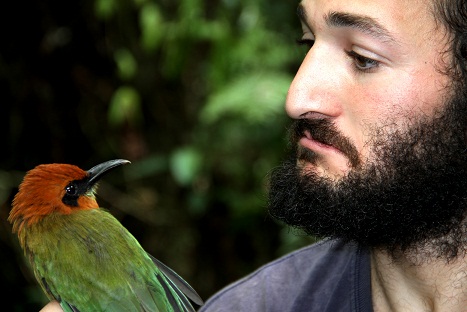 |
Eric Fishel
(USA) 2011
efishel2(at)gmail(dot)com
Working on this project was one the most exciting and
enjoyable experiences in my life. Wandering the rain
forest I was able to see so many amazing things that I know very
few people ever get to see. Finding something new
and incredible every day was defiantly the best
part of my time there. Though my time there was very enjoyable,
it did not lack for hardships. Looking for nests can be very
difficult and extremely frustrating, and because of this it
can be hard to stay motivated sometimes. But this just makes
finding nests all the more exciting and rewarding.
Working at the lower elevations the insects are a constant and
relentless nuisance. Sometimes there is little you wouldn't give
for anything cold, a clean shower or a soft bed, but all of these
factors just made the experience that much more rewarding. But
with all of this said, if you can deal with all of the hardships, this
is an experience that will stay with you for the rest of your life.
The people I worked with will be friends for life. The
wildlife you will see is hard to match anywhere else in the world.
And the experience you will gain in tons of field research
methods is great for helping you along in this field.
|
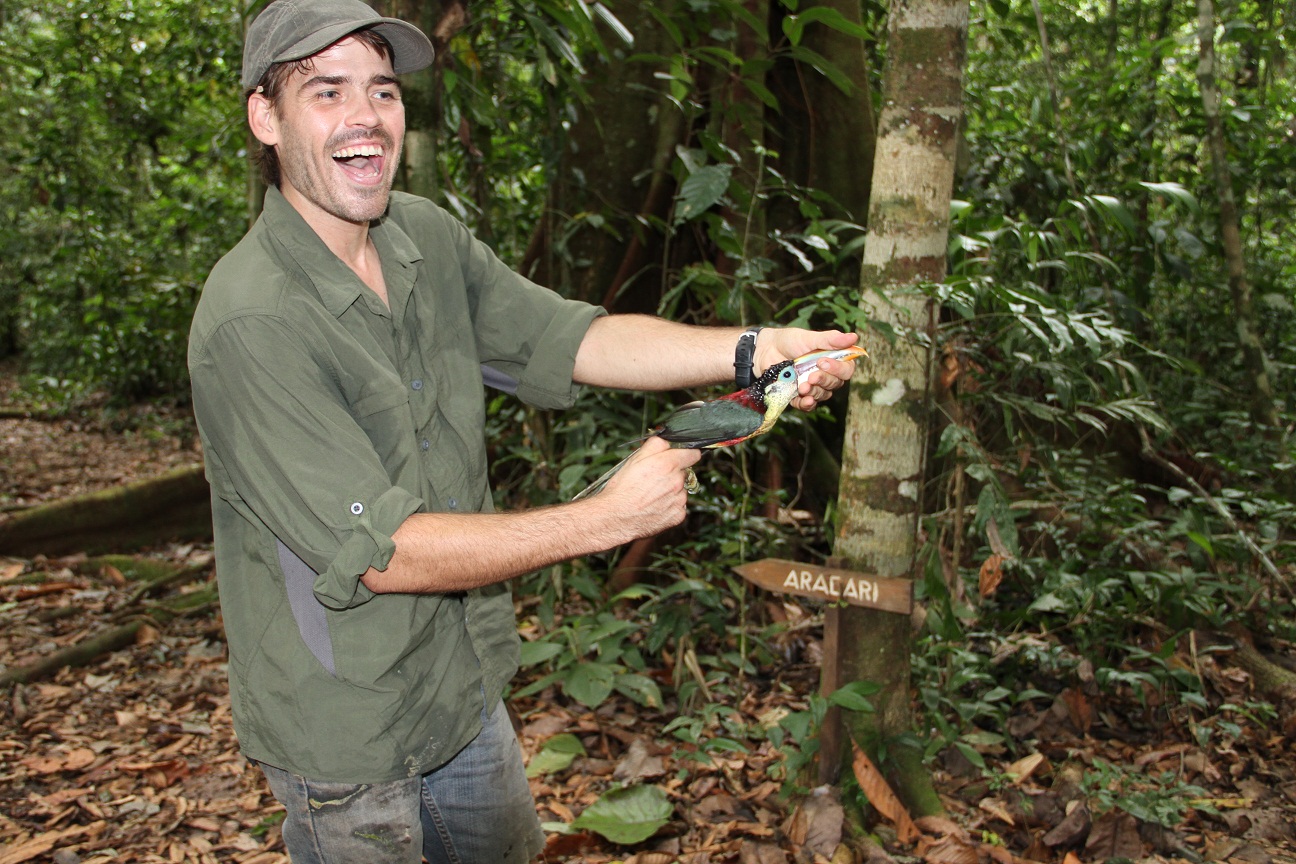 |
Jesse Vooz
(USA) 2011
jvooz(at)yahoo(dot)com
From August to
December of 2011 I
worked at Pantiacolla in the foothills of the Andes on the Madre de
Dios. It is
by far the most remote site on the project and being located in the
lowlands at
the beginning of the Amazon Basin, the biological diversity is
absolutely
teeming and completely overwhelming to one accustomed to more northern
latitudes.
Looking at the
other previous field
assistants accounts echoes the fact that the work is not easy. The days
are
long, most of the time is spent alone walking the jungle searching for
things
that are designed not to be found. At times you may not find a nest for
a long
period of time. Many times I returned to camp frustrated, soaking wet,
and
tired only to lay down to rest upon a damp sleeping bag. But I can tell
you
that every such moment was never in vain. Often I would be walking my
plot,
beams of sunshine coming down through the canopy, Red howler monkey
calling,
Screaming pihas singing on their lek, and there it would be, a
beautifully
constructed nest with 2 beautiful pearl-like eggs inside. It fills one
with
such joy and a sense of accomplishment to find such a sight and know
that you
are quite possibly among the first to ever have observed such a sight.
There is
no comparison.
Pantiacolla is
not for those who
rely upon, or need, conveniences of the modern world. You will sleep in
your
tent, you will cook, bathe in a muddy river, and you may or may not be
able to
use the internet for a month at a time. To me, these are among its
greatest
attributes. Working in Pantiacolla, I not only learned volumes about
the
natural history of the lowland jungle but had one of the most
enlightening
experiences of my life that in the end turned out to teach me so much
about
myself and this world. Despite its hardships I would undoubtedly
recommend the
experience to any adventuresome, hardworking individual looking for the
experience of a lifetime under the guidance of the most wonderful and
knowledgeable bosses one can imagine. Do it!
|
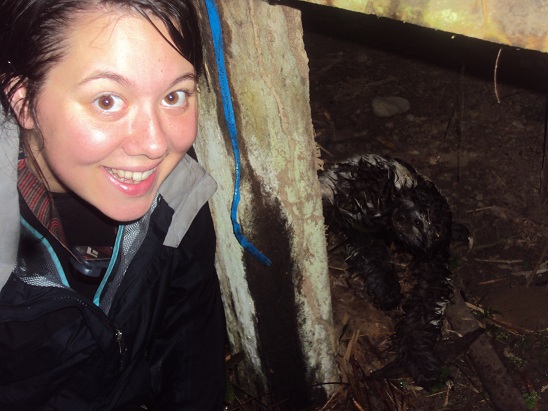
|
Erin Johnston
(USA)
2011
joheri08(at)evergreen(dot)edu
I spent four months working on Gustavo's project, stationed in the
lowlands at Pantiacolla. I have always fantasized about visiting
or working in the Amazon Rainforest, and am so relieved to find that
the reality of it is even better than all of my day dreams. Pantiacolla
is the most primitive of the field sites, so if you are keen on
living closely with the animals, then it is paradise. Throughout the
four months, I had to accept that none of my possessions I brought with
me would remain mine. My tent was claimed by ants, the food, by
weevils, and my body, by various parasites. My hearing belonged to
every insect and bird in the forest, and there was no guarantee that
anywhere was a safe place to sit, stand, or lean. However, this is a
wonderfully humbling experience that is the greatest cure for the
boredoms, or an itch for adventure. Anyone can do it, you just have to
want to! Nest searching was another great challenge for many of us. The
nests are everywhere, but the goal for every bird is to hide their
nest, and lead you away from it. The feeling of finding a nest never
gets old. In fact, it only gets more exciting as you become acquainted
with all the shapes, sizes, materials, and hiding spots. I feel that I
can truly appreciate the detail, precision and the craftsmanship that
goes into building a nest. It is important to keep a positive attitude
towards field work, long hours, living conditions, and your field
mates. Living with 12 random people for several months is a great way
to practice finding positive qualities in everyone, as it is always
possible. Taking this position was the best decision I have made thus
far in my life, as I have been inspired to further my study of
ornithology, and will certainly return to the jungle! |
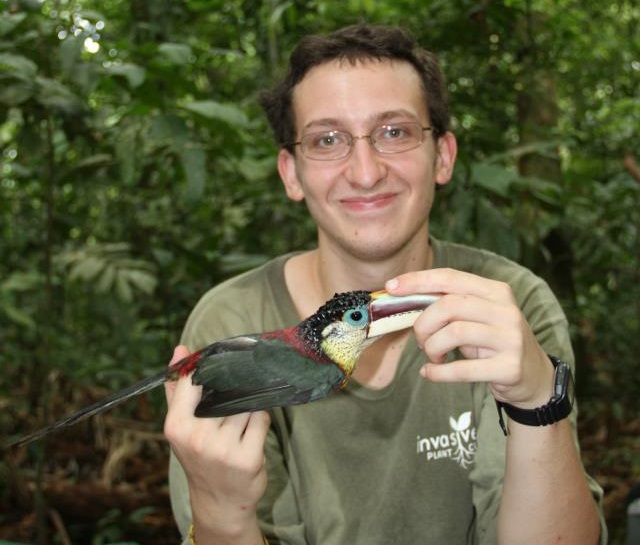 |
Samuel Flake (USA) 2011
sflake(at)gmail(dot)com
Despite the occasional hardships of last field season,
spending four months in Pantiacolla was a great experience which
benefited me as a person and as an aspiring scientist. It was a unique
opportunity, I think, in terms of the potential of the project, the
remoteness of the landscape, and the autonomy granted the field techs.
You really have to learn how to work on your own, but then you are also
rewarded by knowing that the nests you find and monitor are truly the
results of your effort, and you certainly get invested in the project.
I also learned much about how data are gathered to answer a particular
problem. Gustavo and Jill are looking at a complex problem from so many
different angles that one can't help but see the merit in the work as
well as the difficulties of designing a project to answer such a
question. This job was challenging but rewarding in many ways, and I
would think that any lover of natural history should benefit from the
experience even if one isn't particularly interested in tropical
ecology. I found the remoteness and the amount of independent work to
be meditative and personally fulfilling. I came home with a lifetime of
stories to tell. I also got to know the folks I was working with very
well, and I've stayed in contact with several of them. Plus, you get to
see tons of really awesome birds (you know, if you're into that sort of
thing). |
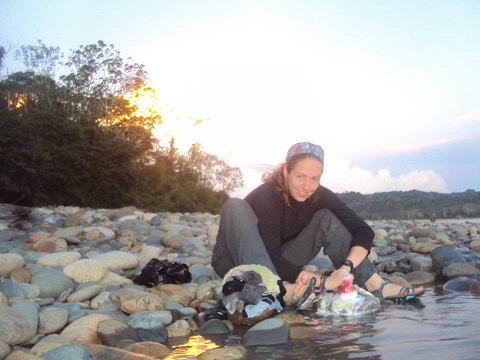 |
Sabrina Van Remoortere (Spain) 2011
sabrinavr81(at)gmail(dot)com
Yo
estuve durante esta temporada
en Pantiacolla, en Alto Madre de Dios, y ha sido una experiencia
increíble.
Pantiacolla es un sitio impresionante, a mí personalmente me
gustó mucho la
cantidad de especies diferentes que se pueden encontrar que estaban
especializadas en diferentes ecosistemas, como el bambú y tierra
firme. Rebosa
biodiversidad en aves, pero también en mamíferos y
en insectos (y esto
tiene, aunque no lo parezca, un lado interesantísimo y
positivo). Así que una
vez uno sabe los trucos para que le piquen lo menos posible (o se
resigna),
esto es el paraíso.
Trabajamos duro, y a veces es frustrante no encontrar tantos nidos como
otra
gente, pero lo mejor es no desesperar, disfrutar y dar lo mejor de uno
para que
la experiencia de todo el grupo sea lo más productiva posible.
Al final, es un
trabajo de grupo y todos tenemos cosas que aportar...y que aprender.
Pasas
mucho tiempo solo buscando nidos, pero también compartes cosas
básicas cada día
con un grupo grande de gente; para mí las dos cosas me hicieron
aprender y
disfrutar de muchos buenos momentos, pero hay que ser consciente de que
somos
humanos y todos tenemos días bajos. Yo estoy muy agradecida de
haber tenido la
oportunidad de participar en este proyecto, de haber aprendido
tantísimo y no
dudaría en volver. Si tienen cualquier pregunta, estoy
más que encantada de
responderles.
|
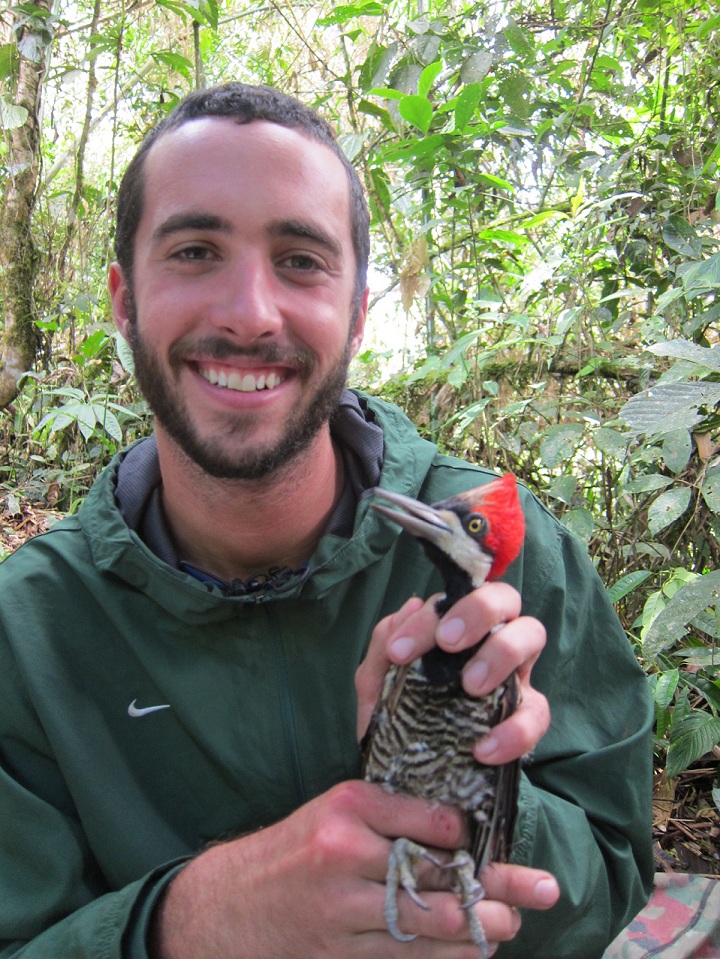 |
Brandon McLaughlin (USA) 2011
bmclaug1(at)ycp(dot)edu
Working with Gustavo and the rest of the
crew in San
Pedro, Peru was exhilarating. It was by for the
most
magnificent place I have ever visited. The work was difficult and
sometimes
frustrating, but completely worth it. Finding nests, monitoring their
juveniles
from birth until fledge, and handling adult birds is an interesting and
rewarding experience. Coming from a non-ornithologist, having the
chance to
explore the jungle and see sights like none-other while nest searching
was
incredible. When going on this trip,
expect nothing and absorb everything. Don’t stress too much about
equipment.
Just keep your wits about you and take in what’s around you.
|
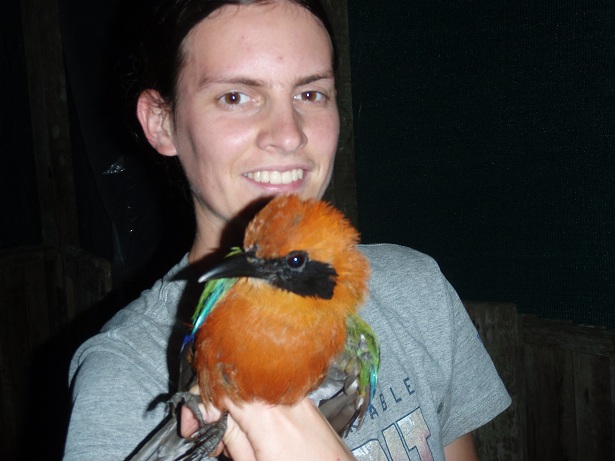 |
Laura
Southcott
(Canada) 2011
lsouthco(at)zoology(dot)ubc(dot)ca
Living and
working at San Pedro was an incredible experience. It's a much more
engaging
way to see Peru than the
average tourist experience.
Be prepared for long hours, many insect bites, and lots of rain. But
also be
prepared to be constantly astonished by the wildlife, the landscape,
and the
people around the field site. I learned a lot about tropical field work
and
birding in general in the two months I was there, but I think the best
part was
constantly seeing something new - weird insect, strange plants, the
occasional
monkey - around every corner.
|
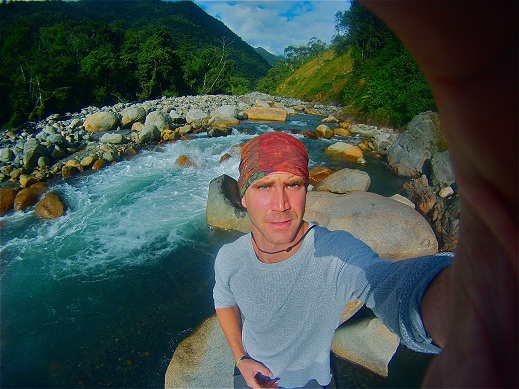 |
Dano Grayson (USA)
2011
danograyson(at)gmail(dot)com
Working in the East Andean slopes of Peru with Gustavo Londono I was
able to experience unique and beautiful bird species as well as many
other inhabitants to the cloud forest. My days were filled with
activities from hiking the High Andeas to hands on encounters with
amazing wildlife. The views at Wayqecha were awe inspiring and when the
clouds and the fog cleared you couldn't help but to stare out, down the
Koosnipata Valley into the mighty Amazon. I met some interesting people
along the way, made some new memories I hope to not soon forget and
learned that some momma birds will defend
their nests with honor. I thank the team I was able to work with for
the great experience and would recommend this position to others. |
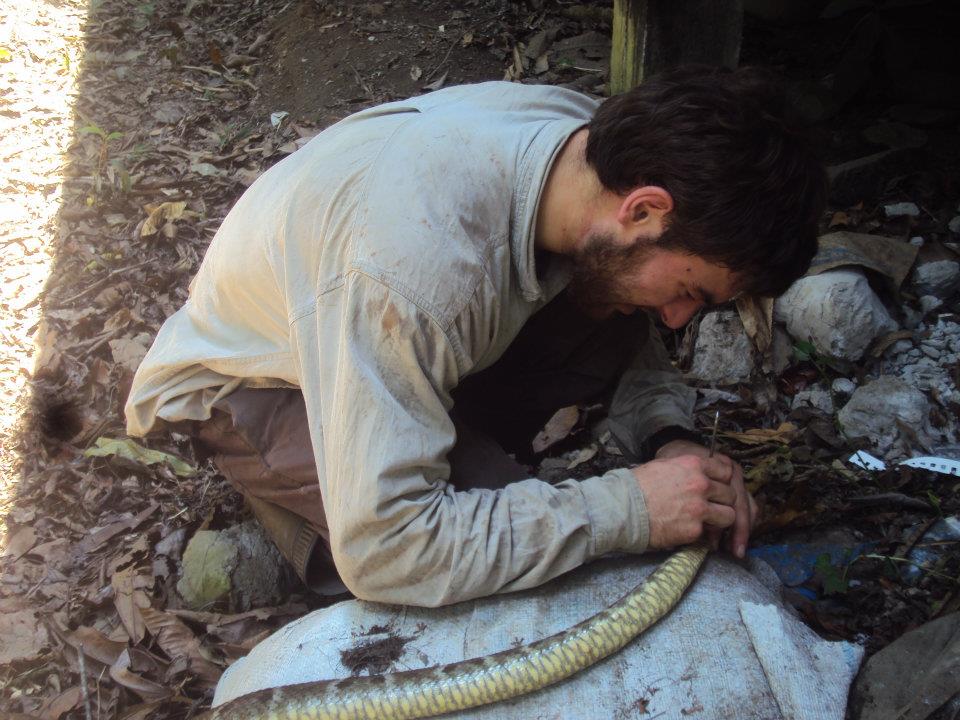 |
Chris
Smith
(USA) 2010, 2011
cscjsmith805(at)gmail(dot)com
2010: This
project was one of my favorite and most intense
field experiences. I have worked in Utah, Alaska, Utah, Jamiaca,
and
several other places, and this position was the hardest I have had to
work (12
hr days of walking at 10000ft elevation, plus 2 hours of data entry at
night). Discovering never-described nests of species is an
amazing
feeling, as is working with and observing birds such as fruit-eaters,
swallow-tailed nightjars, Oropendula, and Cock-of-the-rocks (to name a
few). My field site (Wayqecha) provided good food, usually in
ample
quantities, and hot water on irregular evenings. The other field
sites
are possibly a bit more intense, living off rice and beans for lunch
and dinner
6 days a week, and having only a tent platform to retreat to in
inclement
weather (we had an enclosed eating/lab area). The opportunity to
travel 1
week during and potentially after the season was amazing, and for me
included
Machu Pichu, Lake TIticaca, and Colca Canyon. Gustavo is an
amazing boss
to work for, although very busy at times. The research deals
largely with
natural history (focusing on nesting ecology), in large part because so
little
is known about the species there, which is slightly different than many
conservation-driven, hypothesis-testing science in the US. Be
prepared
for a few new diseases, sometimes-sketchy rides in the backs of large
trucks,
and living conditions that will at times test your mental toughness.
2011: Pantiacolla
was the most
intense and wild place I have worked out of 12 field jobs now to
date.
The place is located on the edge of a huge area filled only with
uncontacted
tribes and a small nearby town (15 min away) of 200, which
occasionally has
internet. I have worked in the tropics, and the frequency you see
rare
animals here like Jagarundi, tapir tracks, Jaguar tracks, and Giant
Anteaters,
and 6 sp. of monkey speaks of how wild this place is compared to
others.
The experience matches the place. Food comes every week, and
vegetables
and bread by the end of 1 week without refrigeration need to be picked
through
for mold/bruises. The diet is very simple (mostly dried rice,
beans,
lentils, and pasta) but will usually leave you filled. Come
prepared to
bath in a river, drink chlorinated water, wash dishes and clothes in a
river,
be mobbed by sweat bees, work 12 hour days (or 24 hrs if you are doing
metabolic work), and be stung by bullet ants, all for 4 months.
The
experience was worth it though. The nests are amazing, the
birding
spectacular, our crew was like our own little family, and soccer on
Saturdays
in town made for a welcome break in life. Gustavo is a great,
easy going
boss to work for, and his enthusiasm makes you excited to go look for
nests.
|
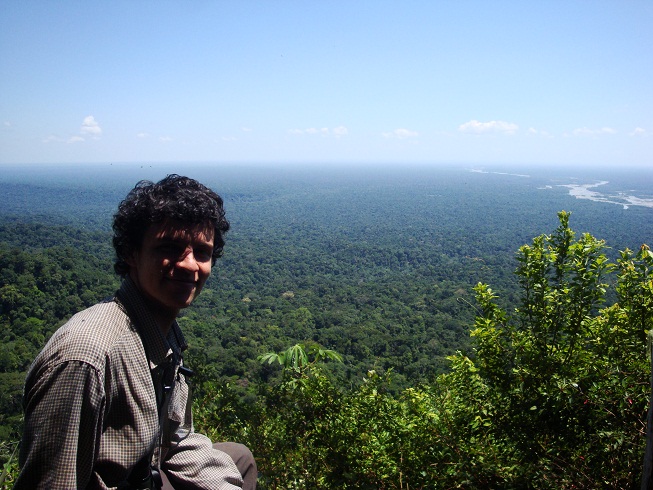
|
Camilo Flórez (Colombia)
2010, 2011
kmilofv(at)gmail(dot)com
2010: Es impresionante
poder haber visto la casi infinita
diversidad de la naturaleza y también haber visto tantas
historias de vida
diferentes . Esta experiencia, sin duda, define lo que me gusta
del
trabajo en la biología y en verdad lo que me gusta de la vida:
caminar largamente
en campo. Es bueno haber aprendido a ver una parte más de los
ecosistemas, los nidos son algo que antes nunca había
puesto atención.
Estar en el bosque tanto tiempo y haber aprendido de tantos
compañeros y buenos
amigos fue definitavemente una experiencia enriquecedora.
2011: Pantiacolla es un
lugar increíble, exuberante y lleno de "extravagancias". Siempre
detrás de la carpa hay sonidos espectaculares, de huanganas,
ratas del bambú, bienparados, monos aulladores... Uno aprende
que es demasiado pequeño en esa selva gigantesca, lejos de la
familia pero demasiado cerca a la naturaleza, otra nueva familia. El
bosque es un laberinto, casi todo el tiempo uno camina sin saber
dónde está. Lo más importante es ser paciente para
todo, para encontrar nidos, rascarse las picaduras, soportar los golpes
de Gustavo en los partidos de fútbol,
soportar la ropa mohosa, las hormigas en las carpas, las picaduras de
las congas, el mal olor de las huanganas, de los compañeros y de
uno mismo. De nuevo, otra experiencia inigualable, muchos amigos nuevos
y otros ya conocidos que fue muy bueno volver a ver. De nuevo, muchas
gracias Tavo. |
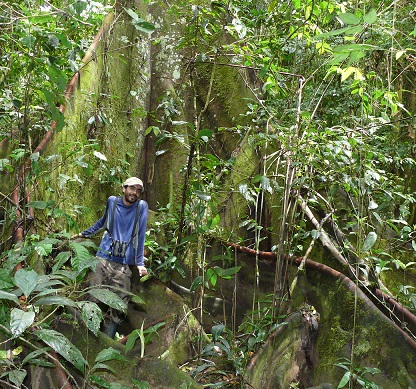
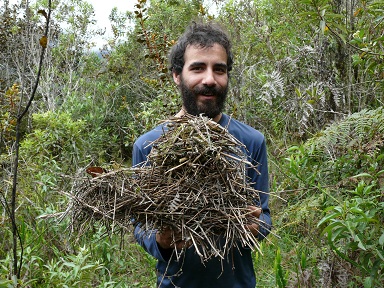 |
Richard Aracil
(USA) 2010, 2011
raptorara(at)hotmail(dot)com
2011: This was my
second time working on Gustavo’s Project
(I
worked at San Pedro in 2010). This past field season, I worked at the
Pantiacolla site. As was the case at San Pedro, I once again had a
wonderful
time. I’m so glad I decided to spend another season in Peru on
Gustavo’s crew! Pantiacolla
was the most beautiful, wildest, most remote place I have ever been.
The forest
was teeming with diversity and life; I would notice something cool and
new literally
every day. The fieldwork for this project is intense! Be prepared to
spend your
days in the field working very hard and often getting absolutely filthy
and/or
soaking wet in the process. Especially if you find a lot of nests, you
have to
be organized in order to keep track of everything and when you’re
not nest
searching, you will be spending much time running from nest to nest
tending them
like they are your children! Gustavo’s field work can be very
challenging, but
it’s lots fun and very rewarding as the data you will be
collecting is often
completely new to science. Working on Gustavo’s project is an
opportunity to
work at the frontier of what is known about birds! Plus, you are doing
it in an
incredible place few people have the opportunity to experience. For me,
the “work”
never really felt like work at all and because of that, I found it very
easy to
push myself too far and go a bit too long without taking breaks. Please
make
sure you are safe and that you also take care of yourself! Outside of
the
field, make sure you are comfortable and come prepared with lots of
extra
clothing to change into as well as stay warm and dry. Also make sure
you eat
enough! I lost a lot of weight at Pantiacolla! Exploring those amazing
forests
every day in search of nests and working with fascinating birds about
which very little is known was a privilege and I looked forward to
every day in
the field with excitement. If I could do it every year, I would!
2010: After
drooling over a friend's copy of Birds of Peru, reading A Parrot
Without a
Name, plus a four-year drought since my last tropical birding
experience, I was
pretty much chomping at the bit to come to Peru. About a year before I
actually
started my field season in San Pedro, I discovered Gustavo's project
after
coming across this website. Although I was really excited about the
opportunity, I was leery about such an epic adventure. I had no idea at
the
time if I would commit to going. During the intervening months, the
prospect
seemed more and more feasible to me. At another field job later that
year, I
ended up working with one of Gustavo's former assistants. She had great
stories
and photos of the wonderful time she had on the project which really
settled a
lot of my apprehension. After hearing her enthusiastic testimonials, my
decision to go was pretty much clinched. Working in San Pedro was one
of the
most enjoyable experiences I've ever had and definitely something I'll
never
forget. The forest in this area was by far the most beautiful and
biodiverse
I've ever seen and the birdlife was truly spectacular. Literally every
day, I
saw something cool and new. The fieldwork for Gustavo's project was a
ton of
fun and very challenging. Every day was an adventure as I never knew
what I was
going to see or find. The data we collected was fascinating and working
with
species on which so little is known was very rewarding. It was a
privilege
working with these incredible birds and making often completely new
contributions to science. Nest searching was surprisingly difficult as
the
birds are extremely cryptic and adept at cleverly concealing their
nests. It
was definitely unlike any nest searching experience I ever had before.
Learning
what to look for (i.e. getting a good "search image") with each
species' nesting behavior was crucial to finding nests in those dense
forests
as were patience and perseverance. If you are looking for an adventure,
you
love birds and challenging fieldwork, and are eager to learn new things
as part
of a truly immersive experience, Gustavo's research is for you!
|
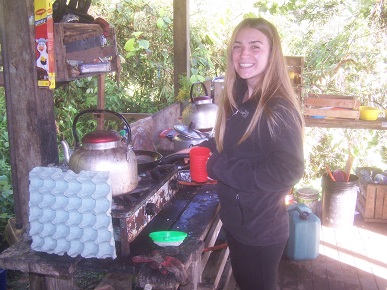 |
Michelle
Kelly (USA) 2010
mek757(at)gmail(dot)com
I
got more than I expected from my time on the Manu. Even though I turned
into a
little bit of a monkey, leaving preconceived notions of morals and
hygiene in
the States, my overall experience at San Pedro was beyond amazing. Much
of what
I learned on the trip was unexpected. I
was applying for Graduate school while abroad and although the limited
Internet
access made this complicated, I was in the most encouraging and
educational
environment for the process. Working for Gustavo gave me a keen insight
into
the challenges and rewards that lie ahead as a scientist.
Gustavo’s ambitious
and fun-loving personality makes it a real joy to work for him. The
variety of
data he accumulates in our short period in Peru is inspirational.
When I returned home, friends and family
thought the challenges I faced were insects, sleeping in a tent,
wearing
perpetually cold wet clothes, and eating the same food day after day,
however
those factors were every bit of the charm of the experience. I made
great friends
and definitely challenged myself. Accept
the fact that there are moments that will be extremely
frustrating.
You have to have to possess a positive
attitude and a drive to push past it. Life
in the forest beats at a different rhythm. The
true necessities are
never more apparent and the journey was so spectacular I understand why
people
go native. The experience was addicting. My
advice to anyone that wants to join the crew is
to learn some
Spanish, bring only items that will dry quickly, and enjoy every moment
(4
months in paradise passes swiftly). |
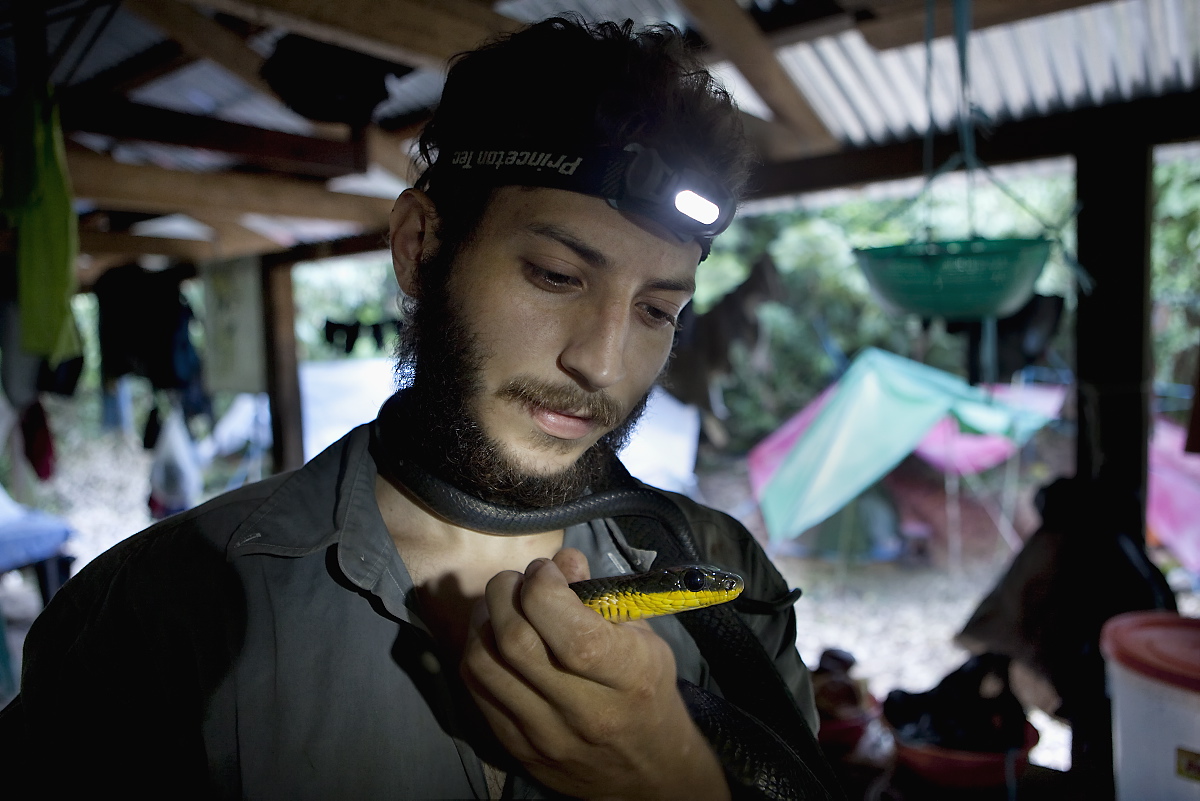 |
Alejandro
Montoya (Colombia) 2010
balrhog.demoria(at)gmail(dot)com
Es una interconexión de tu interior con lo que te
rodea. Es devolverse en el tiempo para impregnarse de tranquilidad y
felicidad.
En cuanto a lo académico es la vivencia más enriquecedora
en la que he
participado, además las serpientes son animales excepcionales e
igual de
frágiles que muchos otros. En consecuencia, la mejor experiencia
en todos los
aspectos de la vida y la repetiría a ojos ciegos. A pesar de
malos ratos, el
balance siempre va a ser positivo. |
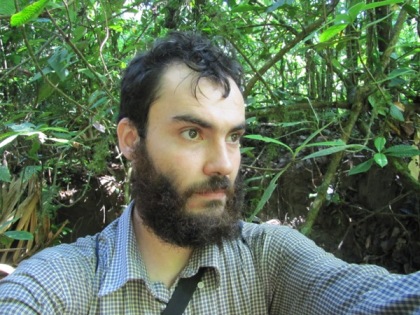 |
Cornelio Bota Sierra (Colombia)
2010
corneliobota(at)gmail(dot)com
Las palabras
que yo pueda escribir nunca lograran hacer justicia a la experiencia
vivida en
el proyecto. Las sensaciones, las anécdotas… Creo que
nunca había aprendido
tanto, y no solo de ciencias, sino de la vida, de la infinidad de
formas de la
vida, de la vida que respira, que corre, que lucha, que vuela!!! De mi
vida, de
la vida de mis compañeros… Como dije arriba las palabras
se quedan cortas.
Simplemente Brutal.
Papá Tavo,
Parceros: ¡Muchas gracias por todo! |
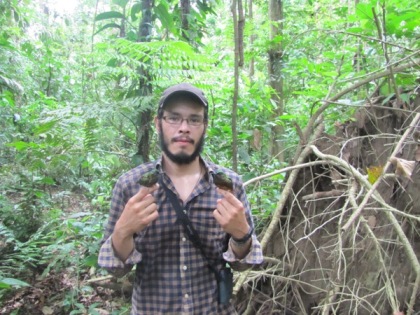 |
Jonny Echeverri
(Colombia) 2010
agnuzyos(at)gmail(dot)com
Experiencias únicas te esperan a la vuelta de la
esquina, me dijo un buen amigo antes de mi partida a Perú. Ahora
que regreso a
la cotidianidad de la ciudad me doy cuenta que esas eran sabias
palabras.
Agradezco al parcero Gustavo por permitirme trabajar en su
proyecto de
investigación, ya que gracias a esta oportunidad pude estar
en el mejor
sitio de trabajo al que alguien como yo puede anhelar. La
sensacion de
tranquilidad que se obtiene en la selva dificilmente se puede tener en
la
ciudad, ademas trabajar con aves es apasionante y todavia mas cuando lo
que
hacemos va a tener un impacto grande en el conocimiento que se tiene
sobre la
ecologia reproductiva de las aves. Peru es un pais con una incalculable
riqueza
natural y unos paisajes maravillosos que se quedan grabados en la mente
y en el
alma. |
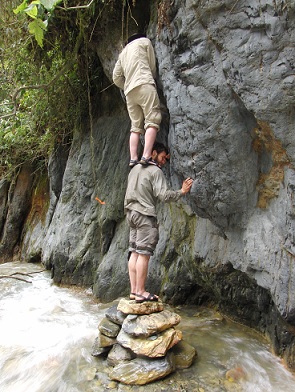 |
Loni Silver (USA) 2010
loni_ag(at)yahoo(dot)com
Working
in Peru for Gustavo was an amazing experience. Because
you get to spend so much time in the field
and Peru has such an
abundance of wildlife, you end up getting to see something new (an
animal,
plant or behavior…) on almost a daily basis. At the same
time, you are also being exposed to so
many different kinds
of birds, nests and even habitats, that you are constantly learning and
gaining
experience. Peru, itself, also has a lot
to offer and this can be a jumping off point for travelling and seeing
the rest
of the country. |
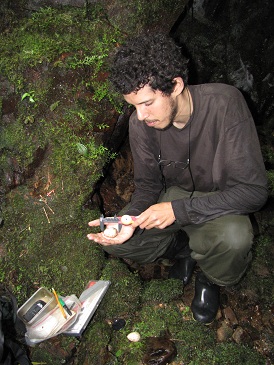 |
Diego Guevara Torres (Peru) 2010
dgt_1234(at)yahoo(dot)com
Participar en el proyecto fue una experiencia muy
valiosa para mí, aprendí muchas cosas sobre la
biología reproductiva de muchas
aves pero también aprendí que soy capaz de realizar
muchas cosas si me las
planteo. La búsqueda de nidos es un reto que invita a ir
por todas
partes, caminar entre los musgos y árboles de San
Pedro o avanzar
por el río Unión o Kosñipata es una experiencia
única ya que el bosque nublado
es uno de los ecosistemas más bonitos que hay en la Tierra.
Encontrar un nido es
como encontrar una caja llena de sorpresas, conforme pasan los
días uno se va
involucrando más con los polluelos llegando a pasar el
día pensando en
ellos, yendo de un nido a otro y siempre encontrando algo nuevo
conforme uno
camina. Le doy gracias a Gustavo por permitirme vivir mi carrera,
Biología, en un contacto directo con la naturaleza. Le
recomiendo la
experiencia a cualquiera que esté dispuesto a aprender mucho
sobre las aves
y vivir una aventura cada día. |
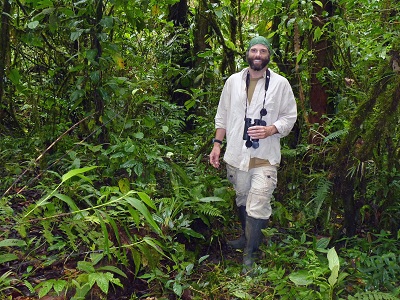 |
Dave Giordano "Gio"
(USA) 2010
businessgio(at)yahoo(dot)com
As
a field biologist, science educator and wildlife
photographer/filmmaker, I seek
out new, adventurous and exciting field research opportunities. Having
visited
Peru and Manu National Park on vacation in the past, I knew I wanted to
get
back there as a researcher one day. That opportunity arrived when I
worked with
Gustavo on his project in 2010. I spent most of my time at the San
Pedro site
but also visited the other two sites. Each site is different and
presents its
own unique adventures and challenges. Gustavo’s project is the
real deal when
it comes to field research. Nest searching in the cloud forest takes
practice,
skill, luck and a lot of patience. You must be physically and mentally
prepared
to work in these ecosystems. There are days when you might feel that
the rain,
mud and biting insects are going to drive you completely insane. Then
there are
days when you might find a nest of an incredible bird, come across a
troop of
woolly monkeys or discover a beautiful insect and remember that you are
lucky
to be working in one of the most diverse ecosystems in the world.
Living
and working in the Peruvian Andes will present endless adventures and
challenges. Not only within the wilderness but also with the local
cultures.
You must be open minded and prepared for the unexpected. A one-hour
ride to
town in the back of a cargo truck (with a bunch of farm animals) might
end up
taking two days to get back because the rains picked up and the road
washed
out. In the end, it’s all part of the adventure.
There
is much to learn about the birds
living and migrating in the Eastern Andes of Peru and Gustavo is trying
to
answer several important questions. He is cheerful; dedicated to his
work and
willing to help you learn and improve your field research skills.
Whether you
are new to field biology or a have been at it for many years, I
recommend this
project for the adventure of a lifetime. |
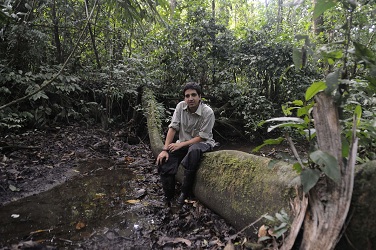 |
Alejandro Campuzano
(Colombia) 2010
kampu420(at)gmail(dot)com
Trabajar en el proyecto fue una experiencia muy
satisfactoria a nivel
personal y profesional. El trabajo de campo en la biología es de
gran
importancia, y es en este que nos acercamos a lo que de verdad estamos
estudiando, y es aquí donde se nos generan las preguntas y
inquietudes que como
biólogos nos debemos hacer. La oportunidad de hacer parte de un
proyecto así, y
de poder estar toda la fase de campo en lugares como Tono y Pantiacolla
fue de
gran importancia y fue una temporada de mucho aprendizaje sobre
biología y
sobre cómo vivir la vida. El trabajo de buscar nidos no es nada
fácil, pero no
hay mayor satisfacción que cuando uno encuentra un nido en medio
del bosque, y
cuando logra ver el proceso de este en cuanto a la construcción,
incubación, y
posterior crianza de los pichones. |
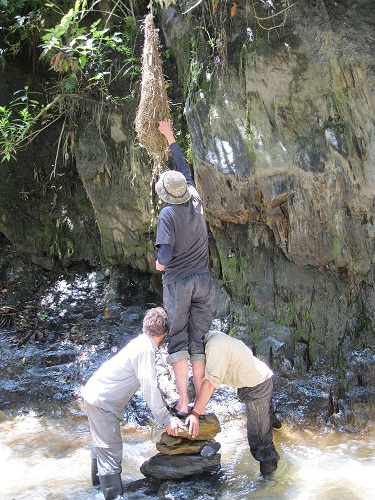
|
Corey Shake
(USA) 2010
corey.s.shake(at)gmail(dot)com
I
spent two months on Gustavo's project at the
Wayquecha Biological Station, my first field work and visit to the
tropics.
The habitats surrounding Wayquecha are an enchanting and often a
challenging work environment, thanks to the cool and damp weather,
steep
terrain, and sometimes thick vegetation. The fascinating and
unique
ecology of this cloud forest-puna grassland ecotone make the conditions
much
easier to deal with. Because of the nature of the job--spending
hours
searching for nests of any and every species you can find--I had the
opportunity to make intriguing observations of many different and
colorful
birds. I also had the luck of observing some pretty interesting
mammals
and butterflies at the lower elevations of the Wayquecha study area,
including wooly monkeys, oso andino, and
a tayra. Another highlight of my work at Wayquecha was the
opportunity to
interact with the Peruvian staff of the station, with whom I made
friends,
played futbol, and visited their homes in a nearby village after the
season.
The work itself was demanding, as volunteers were asked to work
long days
(~10 hrs; 6 days a week) with a relatively large workload (especially
towards
the end when collected nests were analyzed and data entered). The
research seemed to be mostly directed at answering physiological,
evolutionary,
and basic ecology questions, with only a small component of direct
conservation-related questions. Volunteers were asked to sacrifice some
eggs
and frequently handle nestlings to collect physiological data.
With these
things in mind, I would suggest that volunteers have a high level of
enthusiasm
for this type of research. For the project's leader, Gustavo
Londono, I
have much respect and enjoyed working with him. He is an
enthusiastic and
understanding supervisor from whom a budding tropical ecologist could
learn a
lot. Overall, I am very happy to have spent the time I did on
this
project in such an awesome place. |
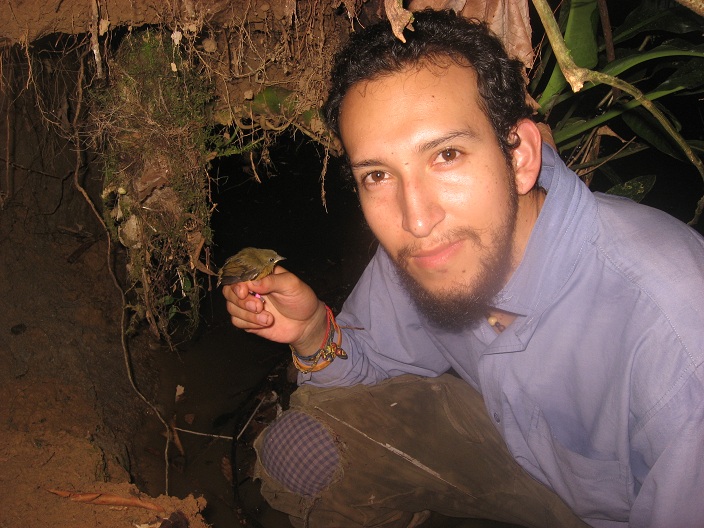 |
Sebastian Camilo
Pérez Peña (Colombia) 2009, 2010
biosebas_021(at)hotmail(dot)com
2009: El
trabajo de
campo es primordial en la formación de un biólogo, es
allí donde se aplica todo
lo aprendido en la teoría y en donde realmente comprendemos lo
que nos han
enseñado; para mi trabajar en el Proyecto con Gustavo fue sin
duda alguna una
de las mejores experiencias de mi vida no solo por la gran cantidad de
cosas que aprendí
y la cantidad de bichos que observe sino porque fue la oportunidad para
darme
cuenta de que esto es lo que realmente quiero hacer el resto de mi
vida, la interacción
con el ecosistema en el que vivimos fue fascinante... el PNN Manu es
uno de los
lugares mas hermosos de Latinoamérica y haber vivido alli es
todo un privilegio
del cual estoy muy orgulloso,tambien la oportunidad de conocer nuevas
culturas
y hacer nuevas amistades fue una experiencia inolvidable...
2010: Cuando en 2009
decidi que volveria para la temporada
2010 del proyecto de Gustavo, jamas me imaginé que iba a ser tan
bueno
regresar... fue una oportunidad inmensa para aprender muchismas cosas
nuevas,
tanto de aves del neotropico así como tambien de otros animales
como los
herpetos y los insectos... gracias al buen grupo de trabajo que se
formo.. fue
una temporada excelente en la que se nos exigio mucho pero al final el
buen
trabajo se vio reflejado en la calidad de los datos obtenidos... haber
tenido
la oportunidad de conocer un bosque de tierras bajas en ese estado de
conservación fue muy emocionante.... la cantidad de especies de
aves, herpetos,
mamiferos e insectos que observamos y con las que convivimos fue
fantastica y
no hay palabras, cada dia era una aventura... siempre habia algo nuevo
y una
historia para contar... la convivencia fue entre hermanos... muchas
gracias a
Gustavo y a cada uno de los parceros de la temporada 2010... por lejos
la mejor
temporada de campo de mi vida!!!! |
 |
Anthony Miller
(Canada) 2009, 2010
Kestrel7(at)surfbirder(dot)com
2009: Working in the
Peruvian
rainforest
with Gustavo was the
single greatest experience of my life. Working in the rainforest
forever changed my look on the natural world and the things around me.
I was
able to spend time at all three sites with the majority of that at
Wayqecha and Tono. All three sites are unique and present different
challenges at each Tono being the most rugged. You must be willing to
experience a new adventure every single day while on
this project. Nest searching in the rainforest presents a
totally different challenge from
that of nest searching in North America.
Birds
are very unique in the placement of there nests and the materials they
choose.
You can go days without finding a nest where others around you
may find 3
in a day. With each day the forest grows on you and you become familiar
with
movements, flocks, and the placement of birds in certain areas. Nest
searching
is a struggle but when you find one it's an amazing feeling!!
2010: This was my second
field
season with Gustavo Londono in Peru. Working with Gustavo was one of
the most
important pieces as my development to a career in biology and avian
research
for that matter. I had the opportunity to learn and work with people
from many
different biological backgrounds, giving insight into there techniques
and
styles of research as well as offering my own advices and experiences
in avian
biology. Your going to get dirty, your going to get wet, your going to
stink,
your going to be riddled with scrapes, cuts, bug bites, bruises and
many other
things – So if this doesn't sound like fun this type of field
work isn't for
you. One of the most important things as well, if you have any problems
when it
comes to eating. If you are a very picky eater you may not have the
greatest of
times. I highly suggest you bring your own foods from Cuzco the big
city or one
of the local mountain or lowland jungle towns. Things you may want to
consider
are peanut butter, or chocolates anything that you might find
comforting while
out doing the research. If you have never been to South America. Be
open minded
to trying new foods, hoping in taxis whizzing down the backroads,
people
trying
to sell you everything and anything from a pigs head, to massages and
anything
in between!
We work long hours, very
early mornings and lot's of walking. Bring the best field equipment you
can
afford. Most importantly good quality rain gear and boots like hiking
boots are
important to this field work. I had my boots fall apart within a few
weeks of
being in Peru. I had to wait a month for my new ones to arrive so it's
KEY to
have quality foot wear. Your job depends on your ability to walk around
searching for birds.
Aside from the rougher parts
of field work life. Your in Peru hello ! This is one the greatest
places on
planet earth to watch birds hands down. No where on earth will you find
the
diversity in plants, animals, and bird species ! It's incredible and
the things
I was able to witness I will carry with me for the rest of my life.
Gustavo is
one of the most amazing people I have yet to work with in my life. He's
a great
friend, an excellent teacher and a person I look up to proving to me
that with
a little hard work anything is possible in avian research. So get out
there and
Find Nests !!!!
|
 |
Rachel
Hanauer (USA) 2009
rachel.hanauer(at)gmail(dot)com
Working for Gustavo was both the
most difficult and the most
rewarding job I've ever had. This is not like studying abroad or
being a
tourist -- nobody will be holding your hand or preparing you ahead of
time for
every experience. You'll be hitchhiking like the locals do,
wearing wet,
muddy clothing every day, and occasionally scraping mold off your
food.
But getting used to this is part of what makes it a worthwhile
experience. I was at San Pedro, which is next to a tourist lodge,
and I
felt so lucky compared to the tourists. The forest is full of
huge
strangler fig trees, monkeys, psychedelic caterpillars, and incredible
birds,
and it was a privilege to call it home for a few months. Every
day I saw
something new and beautiful. I learned so much from my Colombian
and
Peruvian crewmates, both about science and the jungle and about South
America. You have to want to learn
Spanish;
it's okay if you don't speak much, but if you don't make an effort to
learn,
you will be isolated from everyone around you. The nest searching
can be
very frustrating -- you can go days or even weeks without finding a
nest.
But the nests are so intricate and beautiful that it's all worth it
when you
finally find them. I learned so much about natural history and
ecology,
and I feel much better prepared for grad school. Gustavo is great
-- he's
cheerful, energetic, driven to do a good job on his project, and
committed to
helping you develop as a scientist.
|
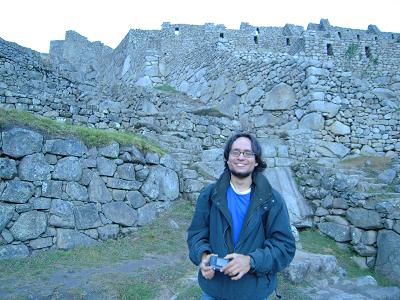 |
Julio Cesar Bermudez (Colombia) 2009
juliobicho(at)hotmail(dot)com
La
temporada que pase en San Pedro buscando nidos es una gran experiencia
de vida,
es una forma de ver las aves desde otro punto de vista muy
enriquecedor, se
aprende mucho sobre la biología reproductiva de las aves, la
gran variedad de
tamaños y colores de los huevos, sobre los periodos de
incubación, la forma y
ubicación de los nidos, los materiales de construcción,
sus predadores y los
diferentes comportamientos que las aves realizan para construir sus
nidos y
defenderlos. La búsqueda
de nidos activos en una tarea ardua pero satisfactoria, que necesita
paciencia
y estar todo el tiempo dentro de la trocha en continuo
movimiento, muy atento y pendiente de cualquier
movimiento y sonido, ya que esto puede representar encontrar un nido
con huevos
o pichones, o también puede representar observar un despliegue
de un ave muy
hermosa, escuchar un canto muy elaborado, encontrar algún
mamífero, insecto,
rana, culebra, flor, fruto, o ver caer algún árbol, ver
crecido el rio, o
cualquier espectáculo de la vida que solo se tiene la
oportunidad de ver en ese
instante. Aprovecho
la oportunidad para agradecerles por los buenos momentos a todos los
que
estuvimos esta temporada en el Manu, especialmente a Manuel, Gustavo,
David,
Santiago, Adam, Rachel y Alex, las personas con las que tire caja
(risa) y pase más
tiempo en San Pedro.
|
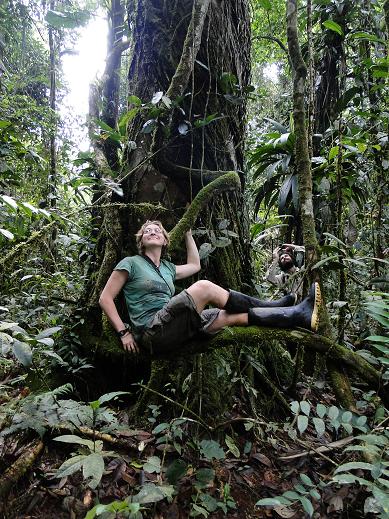 |
Jenny
Hazlehurst (USA) 2009
jhazlehu(at)gmail(dot)com
Working with Gustavo in Parque Nacional Manu is the best way to figure
out if field work in the tropics is right for you. If you can
learn to go with the flow you will gain the ability to be confident and
efficient working in challenging conditions, to
navigate the jungle by
yourself and the courage to stick your hands into things you wouldn't
have before. You may even be allowed to use a machete. If you can get
mentally past the challenging physical conditions of the work the
rewards are beyond value and the memories and stories will last a long,
long time. Work in Tono is especially demanding physically as it is the
most isolated of the stations, but that in itself makes it an
experience unlike any other. After this position you will be ready for
anything. My time in Peru
has provided me with an incredible set of skills, experiences, and
friendships to start my career as a tropical
biologist. Get your feet muddy and get out there!
|
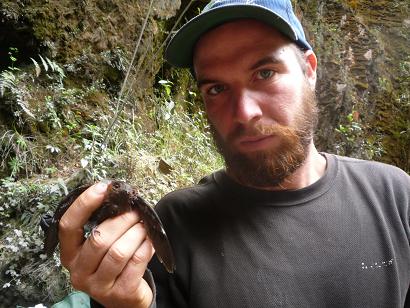 |
Michael Fuss
(USA) 2009
mambangan(at)hotmail(dot)com
I worked for Gustavo for 3 1/2
months at the Wayqecha field station.
Gustavo is a great motivator. He is very passionate about his
work and
inspires everyone around him with his enthusiasm. The project
requires a lot of hard work and perseverance, it is
challenging and
tiring, but the rewards of knowledge and experience are well worth the
effort. I have never felt physically stronger than when I left
Wayqecha,
I felt incredible. Working at Wayqecha includes working with the
two
swift species zonaris and rutila, both my favorites
and
incredible birds to work with.
|
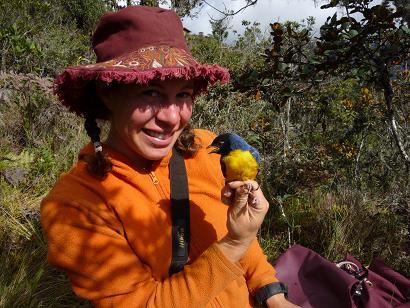 |
Audrey Adams (USA) 2009
ilikewildflowers(at)gmail(dot)com
Working at Wayqecha was a great
experience. There is so
much to learn through Gustavo's project that it is never boring. My
favorite
part of the project was holding and measuring the nestlings. Also,
all the
physical exercise made me feel very strong. At first I worried about
not
finding enough nests, but I shoud not have. Sometimes you are lucky and
sometimes you're not, and you get better as you go. Gustavo is a
good
person to work for because he is patient and relaxed even though there
is a lot
to do. There were quite a few tourists at Wayqecha, which could be
really fun
sometimes, but once in a while I would have preferred to be alone. The
meals
there are fantastic, though. Overall, it was a great chance
to see parts
of Peru
that most wouldn't. I had a fantastic time.
|
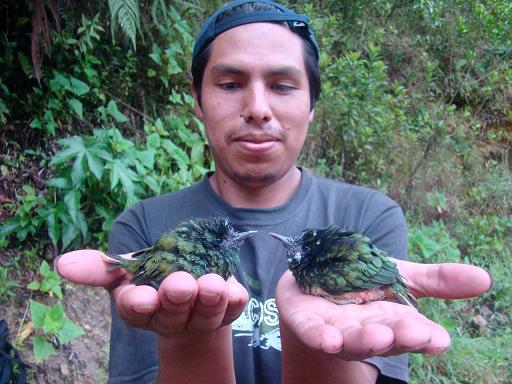 |
Alex Nina Quispe (Peru) 2009
alexphyto(at)hotmail(dot)com
Bien el tiempo en que participe en el
proyecto
sobre nidos, fue una experiencia
inolvidable no solo por haber compartido y conocido nuevas personas
(los
parceros, los paisas y el wuero) sino no también por el
conocimiento que pude
adquirir sobre la gran biodiversidad de aves que se hallan y las
metodologías
que se emplean para realizar su estudio con el uso de equipos y
aparatos
modernos. Los momentos que pase en la estación de San
Pedro son momentos que jamás serán olvidados, son muchas
las experiencias,
entre ellas la búsqueda de nidos en mi opinión muy
personal pensé que jamás
hallaría algún nido pero con la paciencia y buenos ojos
si PUDE, (gracias a las
Euphonias). La experiencia que se siente de ver: huevos
entre pequeños y grandes de diferentes colores, pichones calatos
recién nacidos
y verlos crecer y abandonar el nido y
con ello confirmar que dicha especie aun
se sigue reproduciendo en los bosques lluviosos del Manú, me
colma de mucha
alegría y felicidad. Los patas con los que estuve y los nuevos
parceros que llegaron de Tono hicieron el ambiente entretenimiento y
muy
familiar, siempre y cuando con el debido respeto. Es todo a grandes
rasgos, las experiencias que
pase, lastimosamente en el poco tiempo que estuve.
|
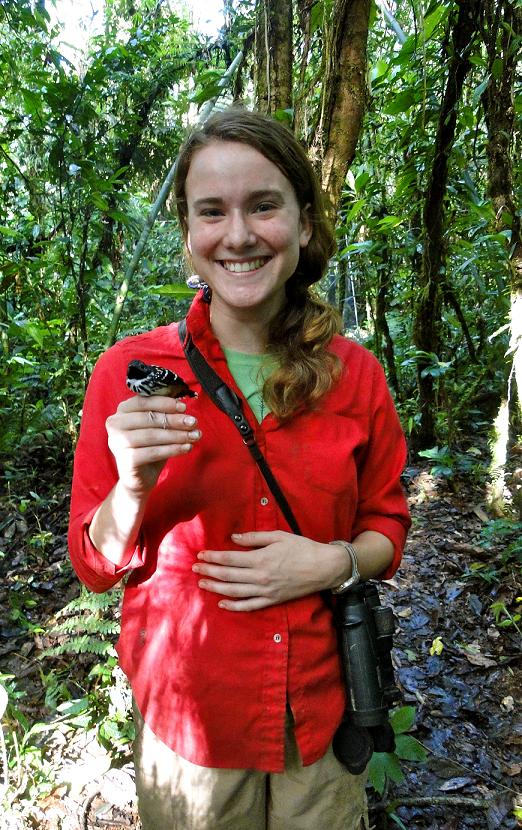 |
Rebecca
Brunner (USA) 2009
rmb57(at)cornell(dot)edu
Living in the Tono rainforest was
like walking through a
dream, a dream I’d been having for almost 20 years. So, needless
to say, truly
describing my experience can be a struggle, but I can confidently say
that
every day held at least one detail that kept me in perpetual awe of the
wonderful hidden world in which we were working. The majority of our
days were
spent off the trails, out there in the wild, the true wild. Every day
at lunch
time we would all trickle in, dirty, sometimes with ripped clothes, and
ask
each other the same question: “see anything amazing today?”
The answer was
always yes.
Since so little is known about the nesting
behavior of
tropical bird species, it was tremendously rewarding to know that every
active
nest we found was an important contribution to the project and the
behavioral
ecology field in general. That having been said, being an integral part
of Gustavo’s
research team is not for the faint of heart or those without a sense of
adventure. Researching at the Tono field site requires strenuous
hiking, a very
flexible palate, a tolerance for bugs, and, most of all, patience.
Searching
for nests can be incredibly discouraging—entire weeks can go by
without so much
as a trace of one in your plot, even while other assistants
consistently find
them in theirs. Nest searching is an art—one that necessitates
careful
observation, focus, and luck. Gustavo is extremely understanding and
helpful,
so as long
as you don’t give up easily and are passionate about working in
such a
spectacular and mysterious ecosystem, you’re sure to have the
time of your
life. Feel free to email me if you have any questions!
|
 |
Simon
Octavio Valdez (Mexico) 2009
simon.octavio.valdez(at)gmail(dot)com
Describir
el tiempo en Tono es difícil... tratar de describirlo no haria
justicia a el asombro diario al encontrar algo nuevo todos los dias. Al
caminar buscando nidos uno encuentra sorpresas a cada paso.
Trabajar en el Manu es algo incomparable, vi especies y animales
que ni
siquiera me imaginaba que existían, La exuberancia y
"excentricidad" de la vida es increíble. Pero lo mejor del
voluntariado fue aprender tantas cosas nuevas, en 6 anos de experiencia
que tengo trabajando como biólogo de campo esta ha sido una de
las mejores experiencias que he tenido. Todos los días
aprendía algo nuevo, ya sea de la biología de las aves,
de el nido, de la metodología, de el porque de la metodologia,
de ecologia, de mi mismo. Todos los días aprendes algo nuevo en
Tono, Y Gustavo es una excelente persona para la que es muy grato
trabajar, Gustavo tiene mucho
conocimiento y le gusta compartirlo, es el Mejor coordinador de campo
que yo haya conocido. Y aun mejor es la convivencia en Tono, entramos
como desconocidos y
salimos como hermanos. Reímos, sufrimos, nos enojamos, nos
contentamos, nos ayudamos mutuamente, nos cuidábamos. Los amigos
de Tono son amigos de por vida. Pero no todo es rosa. Definitivamente
Tono no es para todos. hay muchas
limitaciones e incomodidades, la recompenza es mas grande de lo que
puedes imaginar, pero hay que estar dispuesto a pagar el precio,
Considera Tono solo si no te importa:
-Que se moje toda tu ropa seca y andar todo el dia o toda la semana
mojado hasta los huesos.
-Comer pan con hongos.
-Comer Yuca y Arroz todos los días, (les quedaba muy
bueno, a mi en lo personal me gusto todos los dias)
-Insectos hasta en la sopa (literalmente)
-Picaduras de todo tipo.
-Hay que tener paciencia, no todos pensamos igual y hay desacuerdos, y
como en Tono solo eramos 7 pelados viéndonos las caras
mutuamente por 3 meses, hay que saber como convivir todos en paz. Hay
que saber ESCUCHAR y hablar. Debo decir que a mi no me
podría haber tocado mejor equipo de trabajo, aprendí
mucho de los
amigos de Tono.
-No tener Email, internet, telfono.
En Resumen, Tono es increíble y superara todas tus expectativas,
pero ve preparado, es en serio, ve preparado para pasar incomodidades,
porque va a haber muchas, pero Tono las vale.
|
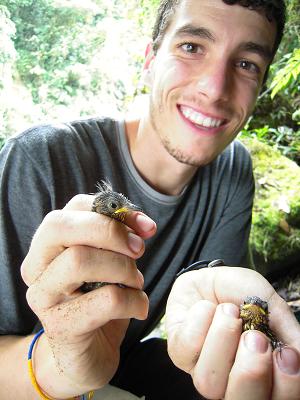 |
Adam Carter (USA) 2009
adjc2585(at)aol(dot)com
My experience with nest searching
was challenging but
extremely rewarding. In the first
several weeks I was unable to find many nests. But,
as time pasted I became more accustomed to searching in the forest
and in turn, a more productive searcher. I
became most attached to the nestlings and found the nesting process to
be very intimate. I gained many new
field skills and met loads of new people; all in all, a truly enriching
experience.
|
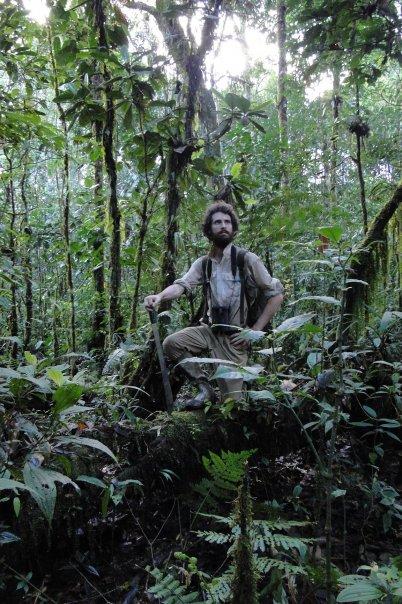 |
Peter Marting
(USA) 2009
peterrmarting(at)gmail(dot)com
Waking before the sun rises to a
chorus of tropical avian
courtships and eating breakfast in a shelter you built out of small
trees and
tarps is how every morning begins at the Tono field station.
Miles from
the nearest village, you set out, off the trails, deep into the
pristine,
dripping rainforest in search of the product of the avian courtships
happening
all around you; nests and eggs. The vastness and complexity of
this great
unknown land inspires endless emotions of curiosity, perplexity, fear,
frustration, exploration, and triumph. The forest gives its
beauty,
secrets, and strength, teaching strange lessons and specialized
techniques. However, the forest doesn’t offer its wisdom
and beauty for
free. For this job, one needs a strong body to hike across
trailless
hills all day and haul pack-loads of food for miles. Perhaps even
more
important, however, one needs a strong mind. Aside from clouds of
mosquitoes, biting flies, bamboo spikes, and wasp stings, it can be
very
frustrating spending weeks without finding what you search for all day
long.
But when you finally find one of these perfectly constructed nests with
eggs
inside, it is a true celebration. If anything, these mere
hardships only
enhanced my experience, teaching me patience, appreciation, and
courage.
This experience was invaluable for my development as a biologist,
sharpening my
problem solving skills in the field as I absorbed Gustavo’s
passion. I
can say with confidence that this experience in the rainforest was the
most
influential experience of my life. I can only hope that you too
can, as
Gustavo always said to me, “Enjoy the forest.”
|
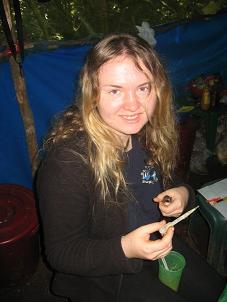 |
Sinead Borchert (USA) 2008
sineadborchert(at)umail(dot)ucsb(dot)edu
I had a great time
working in Peru.
Nest searching can be very difficult and sometimes frustrating. There
are many days when you may not find nests, but on the other hand, you
get to spend all day in the field observing birds. Each station has its
pros and its cons but all are beautiful and have really cool species.
The style of nest searching changes for each one, probably because of
differences in
habitats and the selection pressures the birds have faced. I spent the
longest time at Wayqecha. Initially, I didn't want to go to Wayqecha,
but I ended up really enjoying it because the habitat was unlike any I
had ever been exposed to. The research itself on incubation behavior is
interesting and I liked how Gustavo also focused on collecting natural
history data.
|
 |
Nestor Arilio Peralta (Colombia)
2008
nestorpera(at)gmail(dot)com
El buen paisaje y la relativa facilidad para observar
aves son unas de las cosas que caracterizan a Wayqecha, la
estadía se me hizo
acogedora ya que en el lugar donde me encontraba sentía bastante
tranquilidad y la
gente que estaba alrededor siempre fue
amigable. En general el trabajo es un poco difícil, pero es
divertido, siempre
tienes que estar atento al comportamiento de las aves, como
también a los lugares de posible
anidación de estas.
Finalmente cuando logras encontrar un nido tener mucha
concentración es
fundamental para que el esfuerzo valga la pena. Es
una buena experiencia para convivir con la
naturaleza, y conocer toda la belleza que esta nos brinda,
además que empiezas
a conocer muy de cerca características de vida de las aves
sorprendentes y propias
de este proyecto.
|
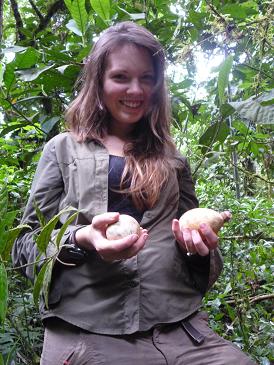 |
Katie Becraft (USA) 2008
kbecraf(at)clemson(dot)edu
I was stationed at
Tono. The forest there is beautiful and I felt like I was lucky
to be able to experience it. Over four months I saw a lot of
amazing
birds and other wildlife, and although the nest searching was difficult
there
at times, I felt like I really improved my skills by the end of the
season,
which was really rewarding. I can’t lie and say that
getting to and
living at Tono was easy; it was very challenging at times! But I
actually
enjoyed the physical challenges and problem-solving that I encountered
each
day, that’s just part of the Tono experience! A positive
attitude is
definitely key, but that’s true of any field situation. All
in all,
working at Tono was very worthwhile and probably the best field
experience I’ve
had. I loved working with everyone on the Tono team, and it was
great to
get to know people from other countries and to see so many beautiful
places
that so few people get to experience.
|
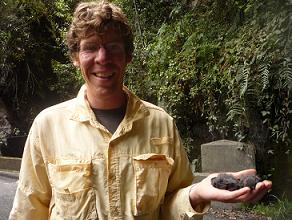 |
Josh
Brown (USA) 2008
joshbrown_81(at)hotmail(dot)com
Working at the Wayqecha Research
Station for Gustavo was the
greatest field experience of my life. During
my four months there I very rarely felt like I was
“working.” Instead I was
wandering
around the Andes looking for
bird’s nests, but
often finding much more. To find
birds’
nests you must go slowly, which also allows you to truly appreciate all
that
the area has to offer. At first, things
were
slow, and I became frustrated by finding few or no nests.
But don’t despair! In
time I found nests, sometimes wishing I
hadn’t found so many. Soon, I had
more
than enough to do, the days flying by as I tried to finish all of my
work each
day. But throughout, there were always
the great nest searchers I worked with, and the amazing staff at
Wayqecha. I will never forget waking up to
the sun
rising over the mountains at breakfast, finding my first nest, or my
heart
skipping a beat every time I saw a bird with nesting material in its
bill. And the truck rides!
|
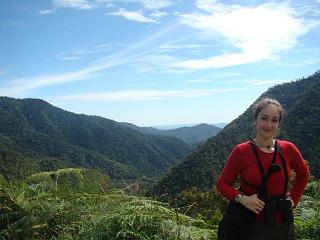 |
Maria Camila Estrada Florez (Colombia) 2008
steinacleit(at)gmail(dot)com
Para mi esta
experiencia
fue única en muchos sentidos,
mas allá del profesional, el
conocimiento ganado sobrepasó todas mis expectativas. Mejore
muchas habilidades
que ya tenia, aprendí otras, todos
los días estaba la
oportunidad de descubrir cosas nuevas.
San Pedro es
una estación hermosa,
las montañas, el río, el musgo que viste a los
arboles, es un
lugar mágico. Pero buscar nidos es una tarea ardua, que
requiere un gran
esfuerzo constante, no darse por vencido a pesar de las dificultades,
seguir
buscando todos los días con la misma intensidad, con
la esperanza
de encontrarlos, que es la mejor parte, ya sean nuevos, con huevos
o con
pichones es maravilloso, son recuerdos que nunca se olvidan!!!
|
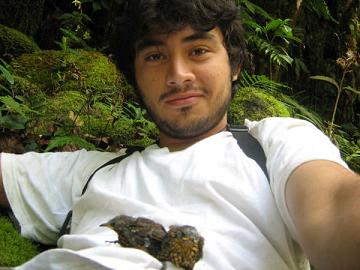 |
Elkin Tenorio (Colombia) 2008
elkint456(at)hotmail(dot)com
Una
de las etapas en la que más se puede aprender
sobre la historia natural de las aves es en su reproducción. O
por lo menos
esta es mi conclusión después de haber estado en campo
durante cuatro meses
continuos estudiando las aves del Manu y sus comportamientos
reproductivos.
Observar todos sus comportamientos desde la construcción de
nidos hasta el
éxodo de los polluelos, me permitió comprender
mejor algunos aspectos reproductivos
de las aves y sobre la
diversidad de estrategias de vida, lo cual sólo puede lograrse
con estudios a
largo plazo como éste y monitoreos constantes de individuos. La
toma de datos
aunque en algunos momentos es agotadora, es muy enriquecedora tanto a
nivel
personal como profesional, además de conocer nuevas
técnicas y compartir
conocimiento con personas de diferentes escuelas. El buscar nidos es
una
habilidad difícil de aprender, de mucha observación y
paciencia, pero cuando se logra, se entra a una nueva perspectiva de estudio y
manera de ver las aves.
|
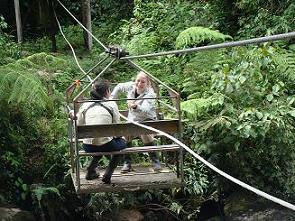
|
Sarah
Thornton (England) 2008
Sarahthornton40(at)hotmail(dot)com
My time in Peru
gave me
many opportunities such as learning new skills, meeting new and
interesting
people and experiencing such a beautiful part of the world. I
found nest searching difficult however I
thoroughly enjoyed other aspects of the project for instance handling
the
nestlings – you really get attached to them. I stayed at
San Pedro and found the living
conditions very comfortable
once I settled down, the platform became like a home from home and I
never got
tired of the view! It is a stunning area
and I feel very privileged to have spent time there.
|
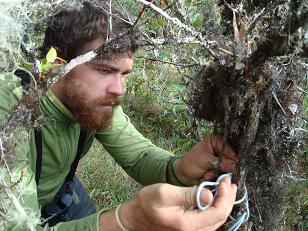 |
William Minehart (USA) 2008
sylvandream(at)gmail(dot)com
Assisting
Gustavo's
research is like being part of the ultimate Easter Egg Hunt.
Searching
for nests is very challenging and very rewarding work. When else
will you
have ten hour work days that consist of wandering around in the forest
witnessing some of the most pristine, exotic, diverse ecosystems the
world has
to offer? Searching for nests can be very difficult as well.
Searching for something that can be anywhere around you, but in
most
cases will remain hidden from you can be enraging work. Combing
through
the same areas day after day looking for nests that just didn't seem to
be
there changed my previous definition of patience for sure, but when you
do
happen upon a nest with several little eggs shining back at you, you
feel like
you have just found a hidden treasure, and indeed you have. So, to
anyone out
there interested in doing this type of research and field work, come
equipped
with a true love for alone time and nature, as well as an open
definition of
what true patience is.
Aside
from the actual nest-searching, working with and for Gustavo is a
great experience. His love for this work is apparent in his
untiring
demeanor. It is rare to find people in this field who can be so
successful in such a large project, yet also sit down and have a nice
conversation over the far-reaching importance of their research outside
of
their immediate project. Compared to all of the field research
projects I
have taken part in, the two months I spent searching for nests in the
Peruvian
Andes with Gustavo was the most rewarding and challenging field work I
have yet
to do.
|
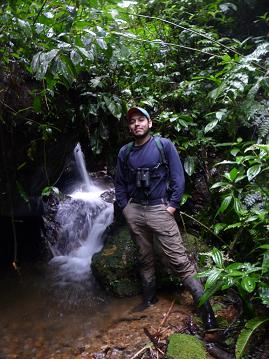 |
Giovanny Valencia (Colombia) 2008,
2010
gvalenciac(at)gmail(dot)com
2008: Fue
una
experiencia enormemente enriquecedora a nivel personal como
profesional,
gracias al trabajo conjunto con Gustavo Londoño y los demas
asistentes del
proyecto. Estos meses en Tono fueron un acercamiento profundo a la
naturaleza
que me ayudaron a comprender un poco la compleja interacción
entre las aves y
su entorno.
2010:
De nuevo una
gran experiencia!!!
La temporada
2010 estuvo saturada de todo tipo de situaciones y pruebas que gracias
al buen
equipo de trabajo se superaron. Al principio de esta en la estacion
Tono
simplemente era como regresar a casa, recordar historias y momentos
vividos en
el 2008, construir de nuevo el campamento, conocer a los nuevos
compañeros y
regresar a la busqueda de nidos hasta septiembre mes en el que
cambiamos de estación
por Pantiacolla un sitio unico, con una cantidad asombrosa de
vida, mas de
400 especies de aves registradas, un sin número de
mamiferos vistos, desde
grandes bandadas de pecaríes y monos todos los dias hasta
dantas, ciervos
y pumas. El tiempo de adaptacion fue corto y en unos pocos dias ya se
echaba
a Tono de menos, Agradezco a todos los compañeros por la
compañia y
enseñanzas en campo en estos meses y en especial a
"Papá Tavo"
por la oportunidad de asistir y sobre todo por las enseñanzas de
vida!
|
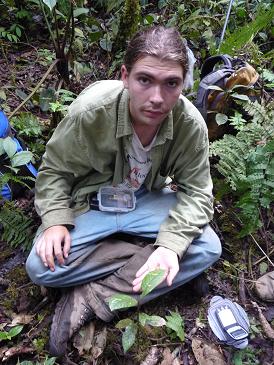 |
Jameson Brennan
(USA) 2008
jmebrn(at)gmail(dot)com
It is quite a rare
experience to work in one of the most remote and beautiful places on
the
planet. Waking up every day to the sun rising in the kosnipata
valley is
something that will stick with me for the rest of my life. Among
the most
memorable experiences would be the fascianation of seeing something new
in the
jungle everyday that I hadn't see before. Be it a new flower,
type of
bird, insects, or what have you, ever day was surely full of
exploration at
something new. The trips to town were always exciting with
unforeseen
twists and turns, quiet literally, while riding high on a camion to get
a few
fresh veggies, a cold soda, and a hour use of slow internet.
While the
accomodations and food may be basic at the field sites, something that
everyone
can take away is learning what is really necessary and important in
life.
|
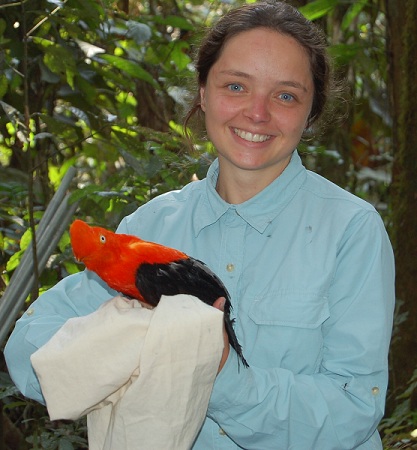 |
Judit Ungvari-Martin (Hungary)
2007
jungvari(at)gmail(dot)com
Finding nests was
challenging
at all of these stations. You need to keep your eyes open, and check
out everything that looks suspicious. Don’t get discouraged, I
had a hard time accepting the fact that I could not find nests for a
long time…but then I found some, which made it all worth it. I
really learned to enjoy the forest and to appreciate the fact that I
got to spend time at these magnificent places. It was the best field
experience of my life; I learned a lot about fieldwork and about my
limitations both physically and mentally too. Bring an open mind and
the best gear you can afford, being well equipped will ensure your
comfort, and a good night’s sleep at all times! |
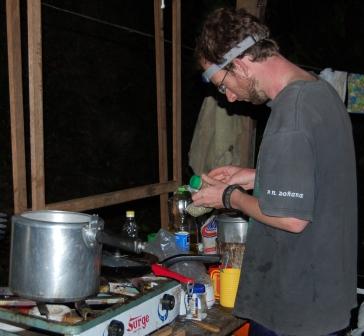 |
Kyle Elliot (Canada)
2007
haliaeetus(at)gmail(dot)com
I spent two months helping
Gustavo in 2007. All three sites are
beautiful and very different. I had often read or heard from other
researchers that Manu is the most diverse place on Earth, and it lived
up to its reputation. Between the two months I spent with Gustavo and
two weeks I spent afterwards around Cuzco and Pilcopata, I saw over 600
bird species in Cuzco Province alone. The experience is definitely
worth it, although it can be frustrating and difficult finding nests. I
will never forget going up the Manu Road at night on top of a load of
yuccas. |
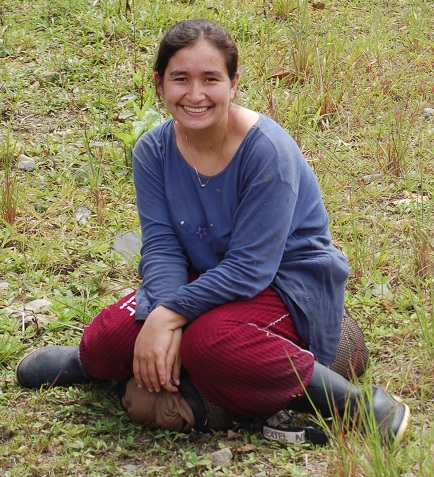 |
Cynthia Zurita
Cervera (Chiclayo, Peru) 2007
atiseret301(at)gmail(dot)com
Participar en el
proyecto fue una experiencia muy satisfactoria tanto en el plano
personal como en el profesional. Conocer profesionales
que permitieron ampliar mis conocimientos en aves, aprender y
sobre todo compartir muchas cosas y momentos en el campo
que hacen que una ame mas lo que esta investigando. A veces,
hay cosas que
incomodan pero no depende de factores internos sino mas bien externos
como son tal ves el clima, la disponibilidad de comunicacion pero
eso no desmerece lo maravilloso de esta experiencia, al contrario te
hacen aprender mas sobre el campo y como son las cosas en el area de
trabajo. Estoy muy satisfecha con esta temporada de
trabajo y espero tener muchas mas aplicando lo aprendido.
|
